Note: If an image ever fails to appear - refresh your page, it really is there
Political Flags of Extremism - Part 1 (a-m)
(Including Hate Groups, Far-Right, Far-Left, and Ultra-Nationalists)
| Flags of Extremism Part 1 (a-m) | Flags of Extremism Part 2 (n) | Flags of Extremism Part 3 (o-z) |
I agonized over these sections. Whether to ignore these flags and what they stand for, or include them was a tough decision. I feared including them would constitute legitimizing them, and certainly didn't want to do that. In the end I thought it important that they be identified for what they stood for, because many times they have been unknowingly displayed or incorrectly identified as historical by unsuspecting or uninformed individuals or flag companies.
These are flags that many times "migrate" from group to group, many of which rapidly appear and disappear as they change their names, and this makes identification even more difficult. Many of these groups were (and are very small) and don't exist any longer, but their flags continue to be used by other modern extremists. Unfortunately, there are a number of people who, like Ayn Rand's characters in "Atlas Shrugged," think there is something wrong in the world, that the world isn't following the right value system. As an alternative, they get into extremist politics like anarchism, environmentalism, neo-fascism, and radical traditionalism. The scary part is that this page only identifies a small portion of the Flags of Extremism being sold today. The sad truth be known, any flag or cultural symbol's true meaning can be used, then distorted and eventually destroyed by their misuse by these extremists groups.
Please be aware that in NO WAY does this site support the beliefs, policies, or philosophies of these organizations, nor encourage the displaying of these flags.
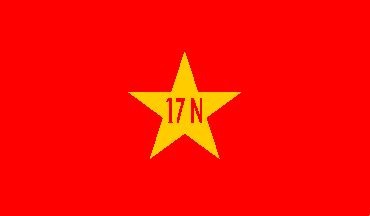
17-N Flag
|
November 17 (Greece)
17 Νοεμβρίου
November 17 took its name from the date of an uprising of a group of students at the Polytechnical School in Athens in 1973. The student uprising was crushed by the Greek Military Junta (1967-1974) led by Colonel Georgios Papadopoulos, who had seized dictatorial powers in the coup d´état of 1967. The 17-N group was founded in 1975, one year after the fall of the military junta. Their first act of terrorism was the assassination of Richard Welch, the head of the CIA bureau in Athens. Over 21 people were later added to the murder and kill list of 17-N, including American, British and Turkish diplomats as well as Greek policemen, businessmen and politicians.
The group was dismantled with the help of an international task force led by Scotland Yard in 2002. The leaders of the group were Alexandre Giotopoulos, arrested in 2002 on the Island of Lipsos, and Dimitris Koufondinas, known as "the man with a thousand faces," who surrendered to police the same year. |
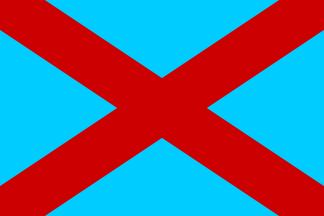
ACA Flag
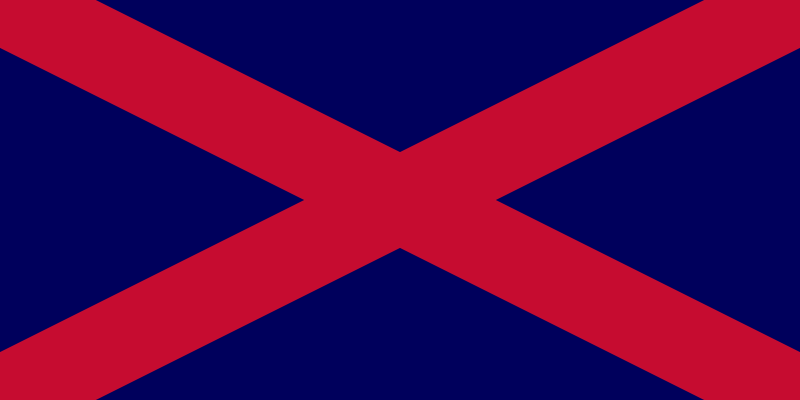
Variant ACA Flag
(questionable ratio and color)
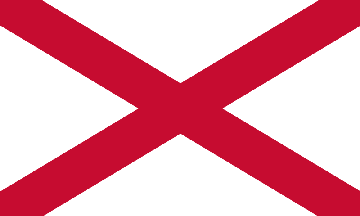
Saint Patrick's cross/saltire
- Traditional Irish Flag -
(use by the Greenshirts unverified)
|
Army Comrades Association (Ireland)
National Guard - Blueshirts (Na Léinte Gorma)
In 1932, a right-wing Irish organization, first called the Army Comrades Association (ACA), then the National Guard, and eventually merged into the Fine Gael Party, was started by Thomas F. O'Higgins and "General" Eoin O'Duffy, who where the first two leaders. Because the membership wore "St. Patrick´s blue," (sky blue) shirts, they soon became more popularly known by their nickname of "The Blueshirts." The Blueshirts, at least on the surface, appeared to be the Irish equivalent of the German Brownshirts or Italian Blackshirts; they wore paramilitary-style uniforms, greeted each other with Roman salutes, and participated in street violence and fights, usually against the IRA. Although they didn't seem to completely follow Fascist doctrine and didn't engage in political terrorism, the Blueshirts were declared an extremist and illegal organization by the Irish government.
After the banning in 1933, the National Guard has merged into the newly founded Fine Gael party, with O'Duffy as its first president who, after serious disagreements with other party leaders, resigned in 1934 and left to form the National Corporate Party, an openly Fascist organization nicknamed the "Greenshirts", in 1935. Only a minority of former Blueshirts followed him; most of them remained in the Fine Gael, which soon distanced itself from the extremism and evolved into a modern party of the center-right, participating in several coalition governments, including the current one (2011-present). O'Duffy later led Irish volunteers to aid the Nationalists in the Spanish Civil War (1936-1937) and had contacts with the Third Reich until his death in 1944, but his "Greenshirt" party was defunct by the end of 1937. The actual flag the Greenshirts used is currently unknown, although one undocumented source indicates they simply used the traditional Saint Patrick's Cross/Saltire Flag.
The Blueshirts´ flag, later also used briefly by the Fine Gael Party, was charged with the red saltire of St. Patrick on a field of light sky blue, the same color as used on the Blueshirts´ uniforms. Contemporary black and white photos clearly show flags with dark saltire on a light field that match their shirts, which were worn with dark ties, trousers and caps. The surviving Blueshirts' uniforms confirm the use of the light sky blue. |

AFA Type #1
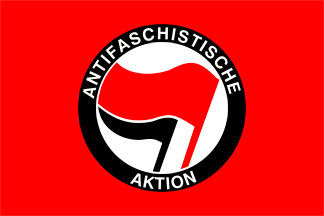
AFA Type #2
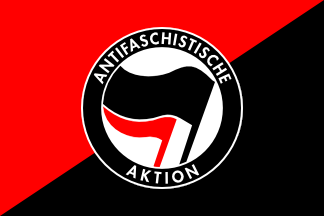
AFA Type #3
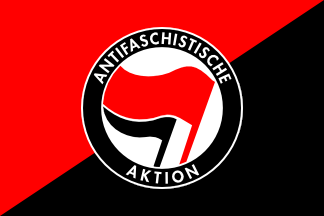
AFA Type #4
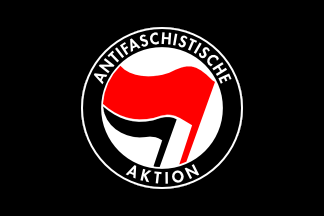
AFA Type #5
|
Anti-Fascist Action (Germany)
Antifaschistische Aktion
Antifaschistische Aktion, an umbrella organization for militant anti-fascists in Germany, was formed in 1932. It was sometimes called "Antifa". Although it did not survive the war, local anti-fascist committees were formed across Germany, typically by veterans of this organization, as Nazi rule crumbled in 1944, under the name "Antifa".[1] These anti-fascist committees often included communists, social democrats, and progressive Christians.[2]
The modern Germany movement most commonly associated with anti-fascism originated in the late 1980s, growing out of West Germany's squatter scene and autonomism movement.[5] This movement ultimately has its origins in the student-based Außerparlamentarische Opposition and the values associated with the new social movements. Unlike the 1930s Antifaschistische Aktion, which was linked to the Communist Party of Germany, concerned with industrial working-class politics against Hitler's NSDAP, the late 1980s and early 1990s "autonomists" were instead independent "anti-authoritarian" Libertarian Marxists and anarcho-communists, not associated with any particular party.
It was after German reunification in 1990, that most of the Antifa groups were formed.
In the 2010s, self-described antifa groups have become increasingly active in Western Europe and North America. These loose collectives first arose in the early 2010s in response to growing nationalism in countries including the United States, United Kingdom, Denmark, Germany, and France.
|
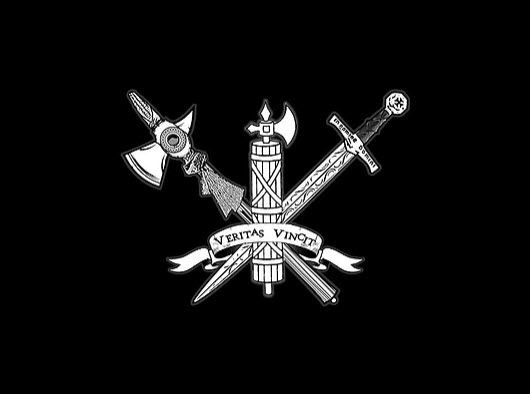
Flag of the Legion
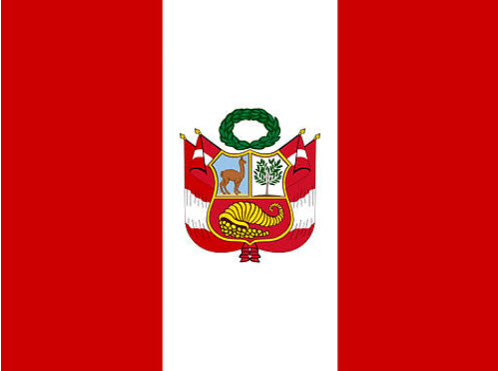
Flag of the Old Homeland
(Based on the flag used 1825-1950)

Flag of the New Homeland
(Based on the flag of October 1820)
|
Legionary Action (Peru)
Acción Legionaria
Legionary Action, popularly referred to as "The Black Shirts," is a fascist political organization in Peru founded on January 5, 2013. They trace their beginnings back to 1931 and the founding of the Revolutionary Union, a Peruvian political party founded by Luis Miguel Sànchez Cerro, the Brigade General of the Army of Peru. After Cerro's death it was led by Luis Alberto Flores Medina who has continued to followed Cerro's political philosophy. The modern AL's leaders include Lucio Rovegno, the paramount chief and highest authority of the organization and Enzo Fernandez Ciotola, who is the National leader of the Section of Press and Propaganda of Legionary Action.
The AL is characterized by its opposition to liberalism and communism, and regards the current government as decadent and corrupt. Under the slogan "neither left nor right", they support "Peruvian fascism" (National Corporatism), which is a political, economic and social doctrine that seeks to "...rebuild the nationality through a social discipline and spiritual awareness, the harmonization of social classes and the corporate organization of the State." (i.e. a Fascist Dictatorship)
There seem to be three different flags used by the Acción Legionaria at their public demonstrations:
The Flag of the Legion "...flies next to our national flag in all demonstrations or events... It is a symbol of strength and past glories."
The Flag of the Old Homeland is used to honor the successful overthrow of the Spanish in 1821 by José de San Martín and "...our heroes, Grau, Bolognesi, Quiñones, Cáceres."
The Flag of the New Homeland is based on the flag used by the Peruvian people after 1824 when they formed an independent constitutional monarchy. |
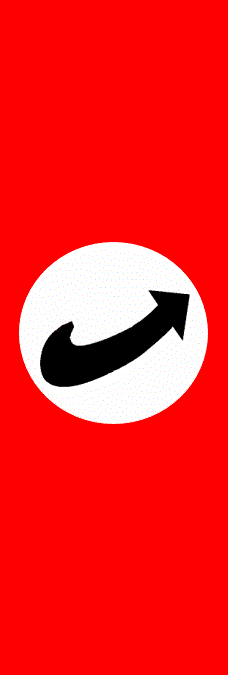
AfD Banner
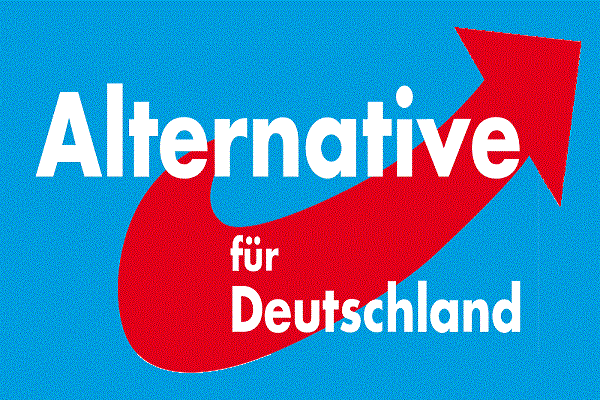
AfD Flag
|
Alternative for Germany
Alternative für Deutschland AfD
The Alternative for Germany (Alternative für Deutschland, AfD) is a right-wing political party in Germany, founded in February of 2013 by Bernd Lucke, Frauke Petry and Konrad Adam. In the same year the AfD founded a youth organization called the "Young Alternative for Germany" (Junge Alternative für Deutschland or JA), although not closely associating with its activities. The AfD is added to these extremist pages as a good example of how a right-wing political movement can become associated with extremist views and policies.
The Afd began as a center-right conservative party of the middle class supporting a mild Euroscepticism (opposition to the European Union), against Germany using the Euro currency, against any economic bail out for countries such as Greece, and were opposed gay marriage. However the party soon became a magnet that attracted extremist, such as former members of National Democratic Party of Germany (NPD), and saw a shift to the extreme right with focus on issues such as anti-migration, Islam and strengthening ties to Russia. In May of 2015, Lucke and his followers left to found a new party, the Alliance for Progress and Renewal, citing the rise of xenophobic and pro-Russian sentiments in the party as the reason. After months of factional infighting Frauke Petry became the principal speaker.
In 2016, Petry suggested several times in public shooting refugees at the borders to Germany and the AfD has since adopted a policy platform based upon opposition to Islam, calling for the ban of all Islamic symbols including burkhas, minarets and the call to prayer, using the slogan "Islam is not a part of Germany". Other party leadership has been guity of posting anti-Semitic comments on Facebook, and has been closely associated with PEGIDA (Patriotic Europeans Against the Islamisation of the West). The AfD's voiced desire to break with consensus-based politics and opposion to using politically correct terminology (claiming it undermines freedom of speech), does make it seem like much of the party has become a mouthpiece for right-wing populism in Germany.
In March of 2016, a NSDAP-style banner was displayed by the party in Magdeburg, and although unofficial, it has not helped the AfD's overall image. Their blue and white official Party Flag does appear far less extremist in nature.
|
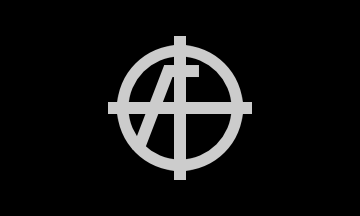
AF Flag
|
American Front (USA)
American Front was founded in San Francisco, California in 1984, which now makes it one of the longest continuously running white supremacist groups in the USA. Its founder was Bob Heick who loosely modeled the AF after the British National Front. Beside California, it has been active mainly in Oregon and Florida.
Its logo is a combination of Celtic cross and monogram AF, the latter often highlighted by using a different color (white over a gray Celtic cross, all on black field), but may also be conjoined into a single shape, which is how it is depicted on the flag, in light gray (perhaps meant to represent silver) on black field. |

Anarchist Flag
Generic Type #1
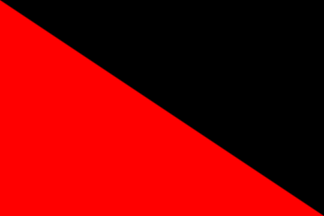
Anarchist Flag
Generic Type #2

Anarchist Flag
Generic Type #3
(very popular with Anarcho-Syndicalist
and Anarcho-Communist Movements)
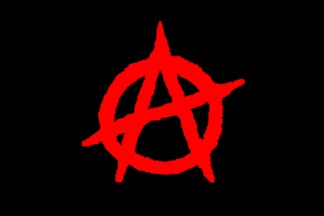
Anarchist Flag
Generic Type #4
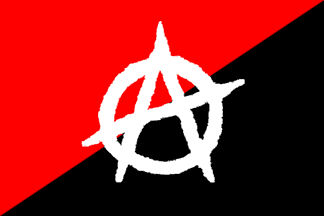
Anarchist Flag
Generic Type #5
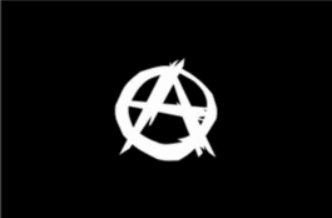
Anarchist Flag
Generic Type #6
|
Anarchist Movements (worldwide)
There are probably as many different kinds of Anarchist Movements as there are different ideologies or traditions in most normal societies. The term "anarchism" is basically used by people who want to abolish the government, abolish capitalism, abolish violence, abolish technology, abolish large-scale production, or abolish as existing society as whole. They seek to overturn, by violence if necessary, all constituted forms and institutions of society and government, with no plans for establishing any other system of order in the place of that destroyed. Basically, an anarchist is a person who promotes disorder or revolt against any established rule, law, or custom.
|
|
|
Anarchist Flag
Generic Type #7 |
|
Anarchist Flag
Generic Type #8 |
|
|
|
Anarchist Flag
Generic Type #9 |
|
Anarchist Flag
Generic Type #10 |
|
|
|
Anarchists & Soviet Communists
Munich, Germany |
|
"Anti-Globalist" Movement Flag
Voronezh, Russia |
|
|
|
Youth International Party Flag
United States |
|
Australian Anarchist Group
Sidney, Australia |
|
|
|
Fulor Movement Flag
Brittany - Type #1 |
|
Fulor Movement Flag
Brittany - Type #2 |
These flags are examples of hundreds of flags used by a wide variety of Anarchist movements world-wide. The generic ones can be found with a large variety of defacements, usually with white lettering, messages, or emblems.
The flag of the Youth International Party (late 1960s-early 1970s) is an especially interesting combination: black field for anarchy, red star of socialism, and green Marijuana leaves. Not surprising since the party leaders were Abby Hoffman and Jerry Rubin. |
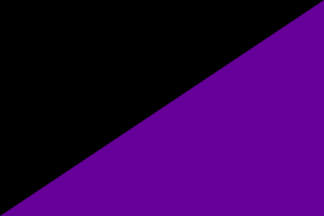
Anarcho-Feminists Flag
Type #1
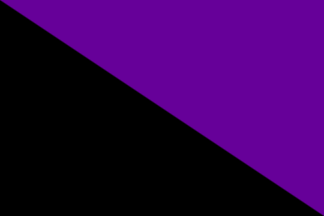
Anarcho-Feminists Flag Type #2
(possibly flown upside down)
|
Anarcho-Feminists Flags (worldwide)
The Anarcho-Feminism movement (Anarcha-feminism, anarchist feminism) basically combines anarchism with feminism. It views all "male dominated" society (patriarchies) as an "involuntary and coercive hierarchy" that should be replaced by "decentralized free association." Anarcho-feminists believe that the struggle against patriarchy is an essential part of class struggle and the state.
|
|
|
Anarcho-Feminists Flag Type #3
(possibly reverse side) |
|
Anarcho-Feminists Flag Type #4
(possibly flown upside down) |
Because of the very nature of Anarchism itself, we included the Anarcho-Feminist's flag here, but there has been few documented examples of any violence associated with this movement. Note: The possibility exists that these are not four distinct variants, but the same design displayed differently. |
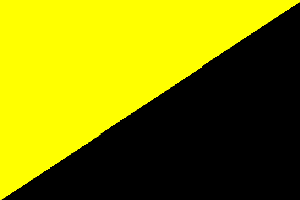
Market Anarchist Flag
("Black & Gold" Flag)
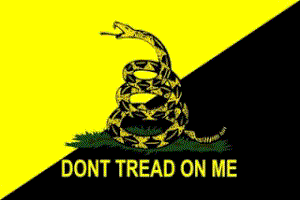
Anarcho-Capitalist Flag
("Rattlesnake" Flag)
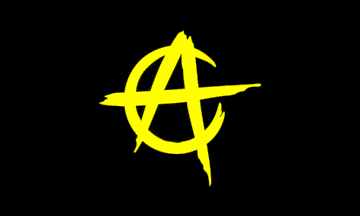
Anarcho-Capitalist Flag
("A over C" variant)
|
Anarcho-Capitalists/Market Anarchists (worldwide)
Anarcho-capitalism (also known as Free-Market Anarchism, Market Anarchism, Anarcho-Syndicalism, Private-Property Anarchism, and a host of other names) basically wants some sort of stateless society, where an economic system based on uncontrolled market interactions exist without regulation. Within these divergent groups there are a multitude of views on property and labor relations that differ significantly, and while many consider themselves simply anti-capitalists and oppose private ownership of the means of production, others stress the necessity of protecting private property, describing this as an integral component of individual rights and a free market economy. In short, there seems to be little agreement among the groups about what happens when government ceases to exist, nor the means of accomplishing it.
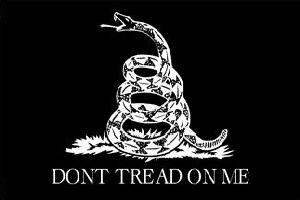 |
|
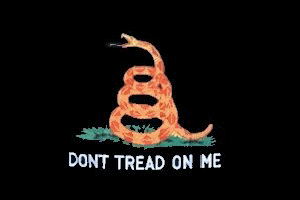 |
Black Gadsden Flag |
|
Tactical Gadsden Flag |
In the United States combining the Market Anarchist Flag with the Gadsden Flag favored by the Tea Party seems to have caught on, although no connection between the two groups is apparent, and many variant designs exist. The Market Anarchist flag is also known as the "Black & Gold" or "Black & Yellow" flag, with the black representing Anarchy and the yellow/gold representing physical gold itself.
Another Anarcho-Capitalist flag to gain popularity in recent years is black, and charged with the golden letters A over C in the center. The symbol is clearly derived from Anarchist symbol of the encircled A. |
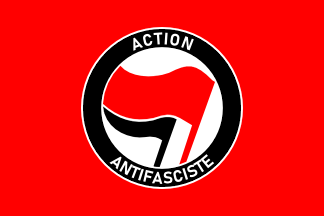
Antifas Flag, Type #1
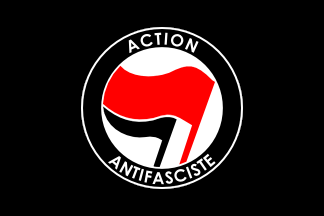
Antifas Flag, Type #2
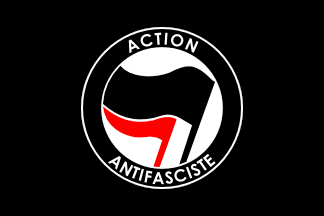
Antifas Flag, Type #3
|
Anti-Fascist Action (France)
Action antifasciste
The Anti-Fascist Action (Action antifasciste), founded in 2008, is a network of French autonomous (extreme-leftist) antifascist groups. These groups and their members are known as antifas. The French antifas are "affiliated" to an informal group of similar movements that emerged all over Europe (Denmark, Netherlands, Sweden, Czech Republic, Slovakia, Spain etc.) in the 1990s. They are based on the German Communist Antifaschistiche Aktion movement of the 1930s which was crushed by the Nazis after they got into power in 1933. Their main goal is to get rid extreme-rightist and neo-Nazi movements, stopping at nothing, including street violence and illegal acts.
The main flag of Action antifasciste is red with the movement's logo, a red and a black flag placed on a white disk surrounded by a black ring charged with the name of the organization, written in white letters. The emblem is a modernization of the one used by the German Antifaschstische Aktion in the 1930s, originally with two red flags and a red ring. The black color was added by the modern antifa movements, symbolizing the union of Communists and Anarchists against Fascists. The flags with black field are also used, sometimes with the swapped places of two flags in the logo.
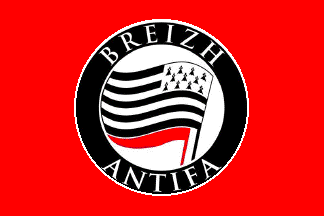 |
|
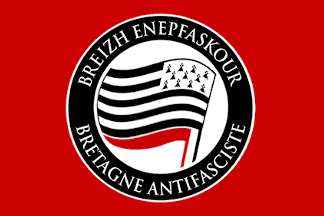 |
Breton Antifas Flag
Type #1 |
|
Breton Antifas Flag
Type #2 |
Most European antifa movements use the same emblem and flag, with appropriate modifications. The flags of Breton branch of Action Antifasciste are good example of this. Notice the black flag has been replaced by a Breton flag, placed in front of the red flag. On the first flag, the ring bears the shorter name of the group Breizh Antifa. On the second one, the full name is inscribed in both Breton (Breizh Enepfaskour) and French (Bretagne Antifasciste). |
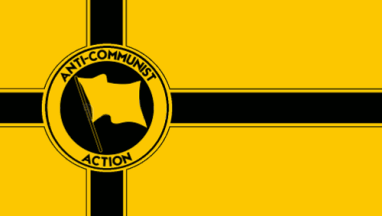
ACA Flag (type #1)
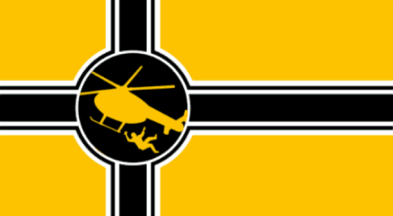
ACA Flag (type #2)

ACA Flag (type #3)
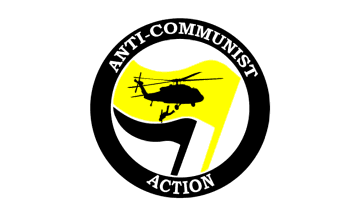
ACA Flag (type #4)
|
Anti-Communist Action (USA)
The Anti-Communist Action ("Anticom" for short) is a neo-Nazi group who attempts to represent themselves as not being neo-Nazi, but their philosophy is generally indistinguishable from various other white supremacist and neo-Nazi organizations.
The group name is an inversion of Anti-Racist Action (ARA), historically the largest network of anti-racist and anti-fascist dedicated to confronting the far-right and disrupting their events and rallies in the world. However, the main purpose of Anticom seems quite the oposite, as they serve as an "anti-communist" front for the wider internet-based neo-Nazi movement. They encourage confronting the far-left and disrupting their events and rallies through direct action, including violence. On the Discord servers they seem to associate themselves closely with groups like Vanguard America, the TWP, and Identity Europa. As part of the broader white nationalist Alt-Right Movement, Anticom members were a visible presence at the nationally televised Charlottesville Riots of 2017.
The black and yellow colors used on their flags are those of libertarianism and is reminiscent of various Imperial German era flags. A variation of this flag (type #2) features a Hughes 500 helicopter dropping a figure from the sky, a reference to brutal tactics of suppressing dissent used by Augusto Pinochet. The falling person that appears in the logo, actually depicts a "death flight" which was a form of killing practised by South American military forces where victims were dropped to their death from airplanes or helicopters.
A third variant of the Anti-Communist Action Flag places a new version of their Anticom logo centered on a yellow field. A stylized black and gold stars and stripes is the main design featured on this new logo, circled in black with the words Anti-Communist Action in white block letters.
A variant of the Anti-Communist Action Flag (type #4) features in the logo a version of the twin flags with a silhouette of a Sikorsky UH-60 Black Hawk, a more modern helicopter than the Hughes 500 used in the earlier flag (type #2), but still based on the same brutal tactics of execution of rivals. This bed sheet version (logo centered on a plain white flag) of the Anticom flag is similar in general design to that used by such extreme-leftist opposition groups as the Anti-Fascist Action in France and other similar groups in Europe. |
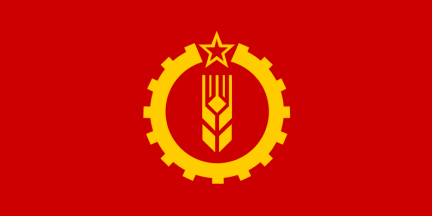
APL Flag
"The Grain and Gear"
|
American Party of Labor (USA)
The American Party of Labor (APL) is a Communist organization started in the United States in 2007. The party platform was established at the new Party's First General Congress on December 6, 2008, held in Milwaukee, Wisconsin. Although the party claims membership across the United States, the largest party activity seems to be in the Atlanta and Milwaukee areas. The current APL General Secretary is Alexander I. Serpov.
Although the APL has not been linked with any violent activities, the party draws its inspiration from the teachings of Marx, Engels, Lenin, Stalin and Hoxha and calls for a workers' revolution to end national control of the rich "ruling class." APL activities include a webpage, a newspaper called "The Red Phoenix," and the Red Star Library where they maintain a collection of Marxist-Leninist texts assembled or published by the APL to promote their version of Marxist-Leninist history and theory. The APL version of "Marxism-Leninism" seems to be closer to that of "Stalinism" and the "Hoxhaism" of Enver Hoxha of Albania.
The APL party calls its red flag "The Grain and Gear" because an ear of grain and a incomplete gear wheel are combined with the star of Communism into their emblem.
|

ARNE Flag
|
Ecuadorian Nationalist Revolutionary Action (Ecuador)
Acción Revolucionaria Nacionalista Ecuatoriana
The Acción Revolucionaria Nacionalista Ecuatoriana (ARNE) was a political movement founded in 1942; it was organized and militant, strongly doctrinaire; very unlike other movements and Ecuadorian political parties of the period who lacked a proper structure.
In 1942, a group of students founded the "Companies Functional National Revolutionary Offensive" (CONDOR). This organization soon became the ARNE political movement, which supported revolutionary nationalism - Falange, fascism, etc. It was led by George Moon Yépes and under his leadership developed very rapidly among young Catholics and the industrial sectors. ARNE is regarded as one of the three major political forces of Ecuador in the second half of the 20th century. However in 1979, with the fall of the dictators, ARNE was denied legal recognition, and although somewhat active during the early 80s it never again was a political force of any importance. |
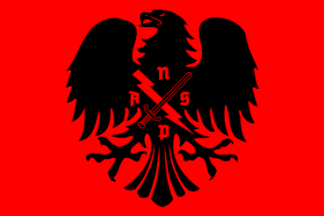
ANSP Flag
|
American National Socialist Party (USA)
In this country, the neo-Nazis keep splitting up and forming new factions. The American National Socialist Party (ANSP) is one such splinter group. Their motto is "Raising up from the ashes, rebuilding the white race, one person at a time." They maintain several similar websites including "the one and only true Aryan Nations," and another for a youth group called "The Werewolf Youth Legion." They are headquartered in Chillicothe, Ohio.
The ANSP flag is slightly reminiscent of the flag of the short-lived West German Socialist Reich Party of Germany of the early 1950s. It has a red field with a fearsome-looking black eagle centered on it. The eagle is defaced with a crossed sword and lightning bolt providing a frame for the red letters ANSP.
|

ANS-NA Flag
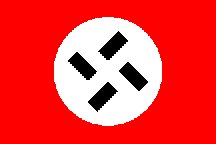
ANS-NA Flag
Variant
|
Action Front Nationalist/National Activists (Germany)
Aktionsfront Nationaler Sozialisten/Nationale Aktivisten
The Aktionsfront Nationaler Sozialisten/Nationale Aktivisten (ANS-NA) was a very active and violent German neo-Nazi organization.
They were originally founded in 1977 by Michael Kühnen under the name of the "Action Front of National Socialists" (ANS). By 1979, their violent policies resulted in most of their leaders being arrested and jailed.
In 1983, they merged with the Nationale Aktivisten (National Activists), an organization led by Thomas Brehl, and combined the names to form the Action Front of National Socialists/National Activists, or ANS/NA. The ANS/NA was in turn banned in 1983. At the time it had about 240 members.
The group used two different flags. One had a black-white-red horizontal triband with a rune-like "S" in the center; the other was a variant of the National Socialist flag called the "reverse swastika." It is the red flag with the white disk, in which a hidden white swastika appears in parts with black accents in the background, shown to the left. Squint your eyes and you'll begin to make out the hidden white swastika. |
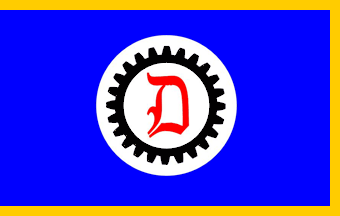
AV (New Jersey Bund) Flag
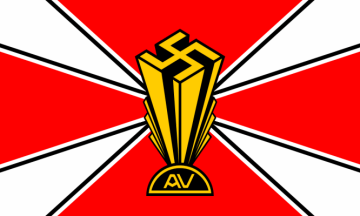
AV (New York City Bund) Flag

AV Youth Unit Flag
(assumed to be a unit flag)
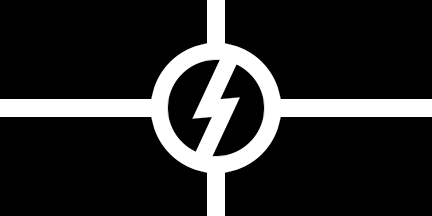
AV Youth House Banner
(assumed to be the general Flag)
|
German American Bund 1936-1941 (USA)
Amerikadeutscher Volksbund (AV)
The German American Bund (AV), or "German American Federation," was a pre-World War II American Nazi organization active in New York between 1936-1939, whose roots can be found in the earlier Teutonia Club (1924-1933) and in the FDND ("Friends of New Germany" - Freunde Des Neue Deutschland) movement between 1933-1936. An internal power struggle fought for control over the Friends in 1934 resulted in Heinz Spanknöbel, Alter Kämpfer, and Fritz Julius Kuhn starting the new German American Bund in Buffalo, New York.
The Bund established training camps in New Jersey, New York, and Wisconsin. Fritz Julius Kuhn was named Bund Leader (Bundesfûhrer), and under his leadership the Bund held rallies complete with Nazi insignia, emblems and rituals. They vocally attacked and held demonstrations against Jews, Communist, trade unions and the Roosevelt administration. In the process they claimed their main goal was to promote a favorable view of Nazi Germany. However, the Bund received no financial or verbal support from Germany, and in 1938, the Nazi government actually declared that no Nazi emblems could be used by the organization. This was done to distance Germany from the Bund which had become an embarrassment to the then current German government policies with some of its rhetoric and actions. Naturally, the AV's public activities pretty well ended with the declaration of war against Nazi Germany in December of 1941.
The first two Bund flags shown here were seen at German-American Bund activities in New Jersey and in New York City. The second flag seems to have been modeled after German military flags. Naturally, there were also large displays of both the Stars and Stripes and the NSDAP Swastika flag displayed at AV events.
The activities of the German-American Bund included several Bund Youth Groups, or DJ (Jugendschaft), who had (assumed) unit flags on black fields mirroring the German Youth Troop flags (Fahnleinfahne). These unit flags were of simple design and consisted of a single runic "S" thunderbolt on a black background. (The assumption they were unit colors is based on the fact that this flag many times had unit numbers inscribed in red in the canton) The second type of Bund Youth Group flag consisted of a white runic "S" thunderbolt centered on the black field, surrounded by a white circle which was centered on a white cross. This elongated banner seemed to have served the purpose of a general Bund Jugendschaft, or house flag, since no unit designations were present. |
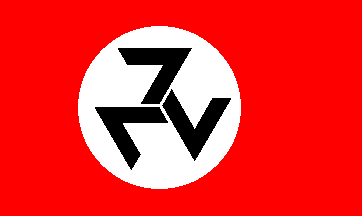
AWB Flag - Type #1
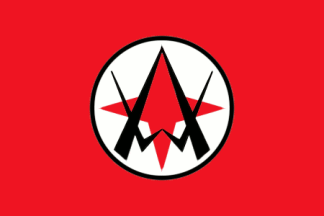
AWB Flag - Type #2
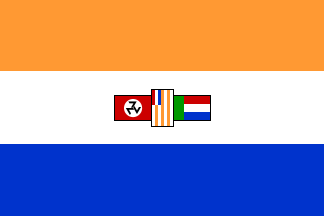
AWB Flag - Type #3 - Front
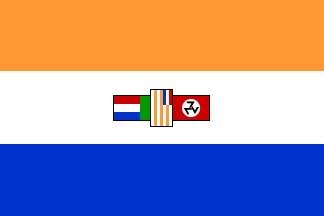
AWB Flag - Type #3 - Back

Modern Afrikaner Resistance
Aryan Guard - Blood and Iron
(Calgary, Canada)
|
Afrikaner Resistance Movement (South Africa)
Afrikaner Weerstandsbeweging
Essentially a variation on the swastika, and popular for that reason, the triskele was a symbol occasionally used by the Nazi regime, most notably as the insignia for a Waffen SS division composed of Belgian volunteers. After World War II, the "Three Sevens" version of the triskele was popularized by white supremacists in Europe and South Africa. The symbol is also used as part of the logo of the international racist skinhead group, "Blood & Honour."
The Afrikaner Weerstandsbeweging (Afrikaner Resistance Movement) or AWB, is a far right political organization and former paramilitary group in South Africa under the leadership of Eugène Terre'Blanche. The AWB claims that the three sevens symbolized supremacy over the devil. They are committed to the restoration of an independent Boere-Afrikaner republic or "Boerestaat" within South Africa. In their heyday they received much publicity both in South Africa and abroad as an extremist white supremacist group.
The AWB Flag (Type #2) was introduced in 1979, but was withdrawn from official use after a short time in favor of already well-established flag with three 7's. The star was said to have represented the Star of Bethlehem, and the Christianity in general. The flag with three 7's (Type #1) was the original flag of the movement; although it was replaced with the flag charged with the stars and letters AW in 1979, it was reintroduced in same year and used ever since. The flag was designed by Jan Groenewald, one of the founders of the movement, and slightly modified by Dries Albert, who was in charge
of the movement's propaganda.
According to Groenewald himself, the inspiration for the design did come from the Nazi flag, however, the three digits were always described as a Christian symbol, the number 777 having been described as the biblical symbol of perfection and of God himself, as opposed to the number 666 which symbolizes the Antichrist.
According to Groenewald, the color red on the flag stood for blood, white stood for the purity of the White race, and black stood for bravery.
The previous national flag of the South Africa was not much used by the AWB, having been generally considered the symbol of subjugation of Boer independence by the British Empire, so the flags of Boer republics were usually used instead. A flag derived from the national flag was used sometimes, on which the Union Jack was replaced with the AWB flag. The reverse of this flag was not identical to the front because three 7's were not mirrored, although the position of the whole AWB flag was (flags of the Boer republics were mirrored completely).
Modern White Supremacist supporters still occasionally fly a flag with a Nazi-like death head skull centered over the "Three Sevens" symbol. Its most recent appearance is in Canada, where it is being used the neo-Nazi group "Blood and Iron," a successor group to the Aryan Guard, under the leadership of Kyle McKee, who has been called the "micro-furhrer of Calgary" by the police. |
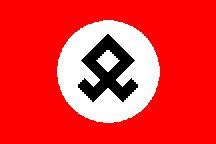
ASF Flag
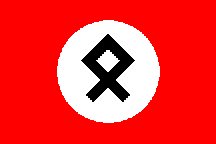
ASF Flag (variant) |
Afrikaner Student Federation (South Africa)
Afrikaner Studentebond
The odal rune is used by the South African African Student Federation. It is the last letter of futhark, the "modern" 16 letter viking rune set.
It was originally used by ethnic Germans (Volksdeutsche) from the Yugoslavia SS-regiment (The 7. SS Freiwillingen-Gebirgs - Division Prinz Eugen) operating during World War II in the Nazi Germany sponsored State of Croatia.
Today the odal rune is widely used by right-wing nationalist youth groups like the Wiking Jugend in Germany and other counties. It was banned in Germany in 1994.
The flag used by the Wiking Jugend was black with a red odal rune in its center.
The odal Rune is sometimes referred to as "Odin's Rune." It is a symbol of a Pagan Religion called Odinism. Neither the religion nor the symbol is racist, but both have been co-opted by certain sectors of the Far Right.
|
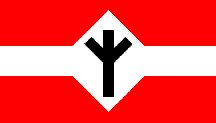
AHF Flag
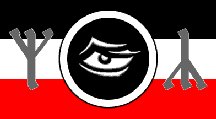
DHF Flag
|
All-Germanic Heathens Front & German Heathens Front (Germany)
Allgermanische Heidnische (AHF) & Deutsche Heidnische Front (DHF)
The Allgermanische Heidnische Front (AHF) was a far right militant Neopagan international organization espousing a philosophy influenced by Ásatrú (Odinism). Notice the strong resemblance of their flag to the flag of the Hitler Jugend, with the alghiz rune replacing the swastika. The AHF was founded and initially led by Norwegian black metal musician and heathen Varg Vikernes, who founded the Norsk Hedensk Front (Norwegian Heathen Front), which soon evolved into the AHF. (Varg Vikernes later ceased to be involved with the organization) The group seek to restore ancient Germanic religion of Odinism and was strongly anti-Semitic. In 2001, the AHF claimed chapters in Norway, Sweden, Denmark, the Netherlands, Germany, the USA, Canada, Russia, and Flanders, but since 2006, the Allgermanische Heidnische Front is apparently defunct.
The German chapter, Deutsche Heidnische Front (DHF), was founded in 1998 by avowed neo-Nazi Hendrik Möbus. The group publishes a magazine Tuisto, which deals with pagan, cultural and historical themes. Their flag's central image is the Eye of Wotan (Odin), and like the AHF flag, also uses the algiz rune, in this case both upright and reversed. |
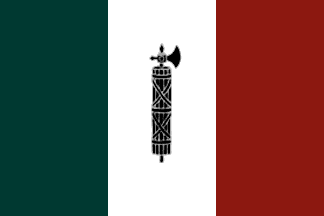
AFM Flag

AFM Flag
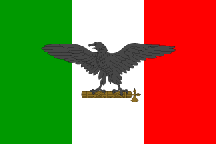
Italian Social Republic Flag
1944-45 |
American Fascist Movement Flags (USA)
Lawrence Dennis, an American diplomat and author, advocated fascism and talked of founding the "American Fascist Party" in the years following the Great Depression, but the group never materialized. Dennis and others were later tried for sedition under the Smith Act in what became known as "The Great Sedition Trial of 1944." The case ended in a mistrial when the judge died of a heart-attack.
The presence or absence of elements of fascism in the United States since World War II has been a matter of continuing dispute. Groups identified as neo-fascist in the United States generally include neo-Nazi organizations such as the National Alliance and the American Nazi Party.
Some say the Fascist Movement is a secret group of Americans who want a strong military government to take control of the United States and put down the protesters, greeners, and ultra-liberals. Others say an American Fascist party doesn't actually exist and its name is used just as a marketing ploy to sell Fascist memorabilia.
On their website, the current American Fascist Movement claims to be against racism and Nazism, materialism, globalism, capitalism and communism, and superficiality. They claim they are for meritocracy, timocracy, sacrifice, nationalism, cooperation (State Corporatism), and virtue.
A large section of their website is dedicated to merchandising. It is also interesting to note, that at the American Fascist Movement's website store, three flags are offered for sale, including a modern replica of the "Italian Social Republic Flag (1944-45)," a modern variant of the "Italian National Fascist Party Flag (1922-1943)," and what appears to be an Italian national flag with the fasces superimposed in black on the white vertical stripe. |
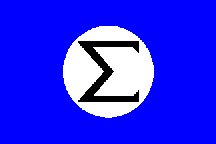
AIB Flag
|
Brazilian Integralist Action (Brazil)
Ação Integralista Brasileira (AIB)
The Ação Integralista Brasileira (AIB), also called the "Green Shirts" after their uniform shirt color, was a fascist movement founded in 1932 by Plínio Salgado after the 1930 revolution that brought Getúlio Vargas to power. Vargas banned all parties in 1937 and foiled an Integralist plot to seize power by force during the 1938 elections by declaring a state of siege. The AIB was revived in the guise of the PRP, one of the legal parties permitted after World War II, which were in turn abolished when the armed forces seized power from the elected civilian government in 1964.
Plínio Salgado was an admirer of Mussolini and Hitler. He tried to adapt some of the Nazi-Fascist elements into Integralism. The Green Shirts had a salute similar to the Nazi salute, but instead of the straight hand, they pointed the palm of the hand to the front and said "Anaue," meaning "You are my brother" in the native indian Tupi language. |
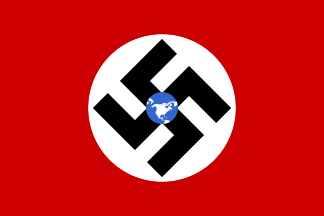
ANP Flag (original)
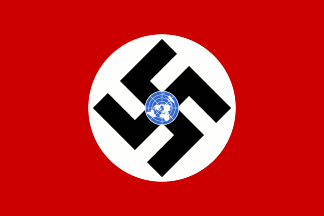
ANP Flag (variant globe)
(also used by the new ANP)
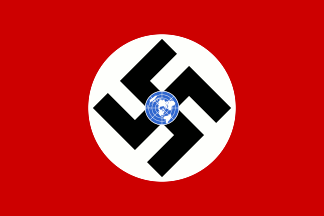
ANP Flag (variant globe)
(rarely used)

ANP Flag (blank globe variant)
(frequently used)
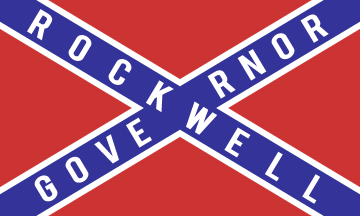
Rockwell's Campaign Flag 1965
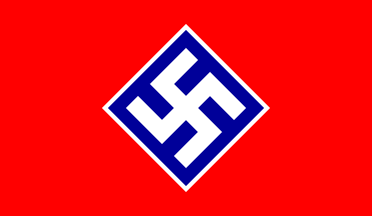
NSWPP Bicentennial Flag 1976
(ANP reorganized as NSWPP)
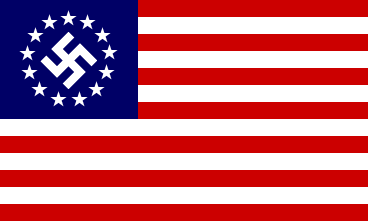
13-Stars and Stripes Flag
(rarely seen or used)
|
American Nazi Party (USA)
The American Nazi Party, founded by George Lincoln Rockwell in 1959 and led by him until his death, had a flag like that of Nazi Germany with a small blue globe in the center of the swastika, representing the world being consumed by the swastika. The depiction of the globe on party flag and emblem varied: sometimes it was showing only the North America and some of neighboring regions, but it was sometimes also showing all continents, together with the meridians and parallels as in the current United Nations flag, and there were few of its depictions as in the original United Nations flag. On many occasions, the globe was simplified to a blank solid blue circle, as can be seen in some early color photographs. Rockwell initially called his party the "World Union of Free Enterprise National Socialists" (WUFENS), but later renamed it the American Nazi Party in 1960 to attract maximum media attention. The party, headquartered in Arlington, Virginia, largely based its platform upon the ideals and policies of Adolf Hitler's NSDAP, but added a policy of Holocaust denial, and expressed allegiance to the Constitutional principles of the American Founding Fathers.
|
|
|
ANP Banner
(also used by the new ANP) |
|
ANP Banner
(Used in October 1961 demonstration) |
In a "Keep the Redskins White!" demonstration members of the American Nazi Party demonstrated against desegregating the Washington Redskins football team in October of 1961. At the time the Washington DC pro-football team was the last remaining all-white team in the league, and although desegregated today, it remains the only team in the NFL whose name is considered a racial slur.
In 1965, Rockwell ran for the governor of Virginia, finishing last among the four candidates. Although the ANP had already existed for six years, he ran as an independent candidate, probably in order to make himself more acceptable to the voters, and used a flag in his campaign which was derived from the Confederate flag by replacing the stars with the words ROCKWELL GOVERNOR in white. The flag was actually made from a real Confederate flag on which the stars were painted into blue before the letters were added.
In 1967, Rockwell was killed by John Patler, a former party member whom Rockwell had ejected from the party for allegedly trying to introduce Marxist doctrine into the party's platforms. The ANP name was changed to the National Socialist White People's Party (NSWPP) in 1967 shortly before Rockwell's assassination. In 1969 a youth wing of the National Socialist White People's Party (NSWPP) was formed by Joseph Tommasi called the National Socialist Liberation Front.
The so-called Bicentennial Flag of the National Socialist White Peoples Party was first seen in a demonstration in 1976 on the Fourth of July outside the White house. The NSWPP party claimed the flag celebrated America's Bicentennial and had nothing to do with any bicentennial of the National Socialist Movement which, of course, began in 1919. The red-white-blue Bicentennial flag was designed by Matt Koehl, the current leader of both the New Order and the World Union of National Socialists (WUNS). Koehl has a long history of being in leadership positions in various extremist groups, including the National Renaissance Party (NRP), the United White Party (UWP), the National States' Rights Party (NSRP), and the American Nazi Party (ANP). In August 1967, Koehl succeeded the George Lincoln Rockwell as "Commander" of the National Socialist White People's Party (NSWPP), and renamed it the "New Order" in 1983. By then, several splits resulted in formation of new neo-Nazi groups, mostly due to Koehl's policies, based on his vision of Nazism as a religious movement rather than a political one. Since mid-1980s, the New Order has been headquartered in New Berlin, Wisconsin, preaching Nazism as a pseudo-religion, without any public political activities.
Today, the name "American Nazi Party" has been adopted by an organization led by Rocky J. Suhayda, a former member of Rockwell's original party in 1960s, and headquartered in Westland, Michigan. Rocky Suhayda was later affiliated with a group in Detroit called the SS Action Group led By Ted Dunn in the 1980s. Dunn ran a kind of a soup kitchen operation feeding those who "fought" under his leadership. The new group claims George Lincoln Rockwell as their founder, but there seems no actual connection to the original ANP, apart from the fact that their website sells nostalgic reprints of Rockwell's 1960s-era magazine "The Stormtrooper" and replica flags of the original party.
The new American Nazi Party uses a version of the original ANP Flag (shown top left, with blue UN-style globe) on their website and a vertical banner (shown left) at their rallies. However, a few years ago, they sold flags of various countries and states with a swastika superimposed on their designs, including the 13-star United States flag shown on the left. |

al-Qaeda Flag
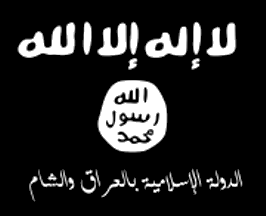
Syria-Iraq al-Qaida Flag

Syria-Iraq Isis/Isil Flag
|
al-Qaeda "The Base" (Saudi Arabia)
Islamic State of Iraq ISIS or ISIL (Iraq and Syria)
al-Qaeda/ad-Dawla al-Islamiyya fi al-'Iraq wa-sh-Sham/Da'ash
This flag sometimes has been used by cells of the extremist Arab terrorist organization al-Qaeda, who have been responsible for many senseless bombings and deaths. It is black with the "long version" of the Shahada in a yellowish color and a yellowish circle in the center. A variant has the lettering and circle in white. The flag is never flown, but usually hung on a wall. This flag was used in the background of several beheading videos. In the videos it is not clear enough to tell whether the lettering and circle is white or yellow, but it probably differs depending on who made the particular flag. The flags are not machine-produced, but hand-made, usually from two pieces of black nylon with embroidered lettering and circle.
The second flag shown here is an example of an al-Qaeda flag that is seen in many parts of the Middle East, with variants displaying differing Arabic text. Normally the text on the top reads "There is no god but God." The white circle appearing in the center with inscription Muhammad Rasul Allah is the seal of Messenger of God which he used on his letters. The text on the bottom of this example reads: "The Islamic State of Iraq and Ash-Sham."
What started in Saudi Arabia, gradually spread to western Iraq and Syria with violent extremist groups forming the Islamic State of Iraq and the Levant (ad-Dawla al-Islamiyya fi al-'Iraq wa-sh-Sham), abbreviated as ISIS or ISIL (Da'ash). In 2006, ISIS, acting as an umbrella organization for the Iraqi insurgent groups started by al-Qaida supporters and members, and taking advantage of the weakness of the states of Iraq and Syria following the Iraq Wars, managed to seize a fairly large portion of the area. What followed was a senseless regime of terror and destruction, resulting in the deaths of thousands of innocent people and the desecration of many irreplaceable historical monuments. Massive amounts of Syrians and Iraqi fled the war torn area resulting in a world wide refugee crisis.
The symbolism (in particular in the black flag and so-called seal of Muhammad) are modern-era inventions of jihadists that have neither historical basis nor Islamic tradition truly supporting them. |
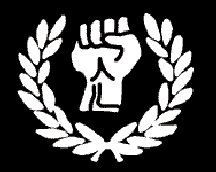
The Aryan Fist
|
Aryan Fist (USA)
The Aryan Fist symbol is a twist on the fist representing the Black power movement and the battle against racial oppression. White Power (U.S. Nazi Skins) uses a logo consisting of a white fist upwards on a black field.
The Aryan fist is a symbol of white power used by hate groups who promote their racist agenda as white pride activism. The laurel wreath appearing in the "Aryan fist" Flag is actually not a racist symbol itself, but rather a separate common skinhead symbol stemming from the logo of a line of British clothing that became popular among skinheads. It is the white fist itself that is the symbol of intolerance.
|
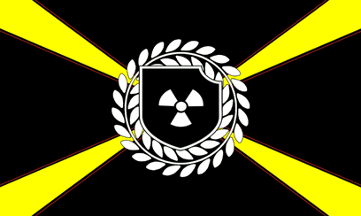
AWD Flag
|
Atomwaffen Division (US)
The Atomwaffen Division (AD), or Atomic Weapons Division (AWD), is a neo-Nazi terrorist, alt-right network, consisting of small groups mostly located in the Southern United States. They first appeared in 2015, but have since spread into pockets across the United States and even attracted followers in Canada, the United Kingdom, and reportedly even in Germany. According to the Southern Poverty Law Center (SPLC) "...members of the Atomwaffen Division have been held responsible for a number of murders, planned terrorist attacks, as well as other criminal actions."
The AWD flag is black, bearing a yellow saltire with arms widening towards the flag corners. Centered on the saltire is their logo consisting of a black shield fimbriated white and black. It is charged with the radiation hazard symbol in white. The shield is surrounded by an "endless" laurel wreath in white with black outline. |
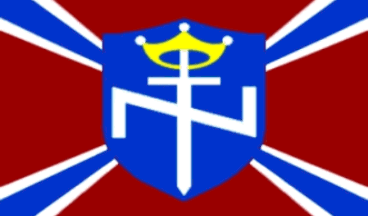
AN Flag
(oblong variant)
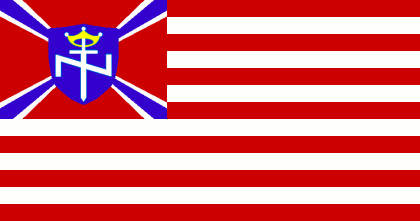
AN Flag
(13-striped variant)
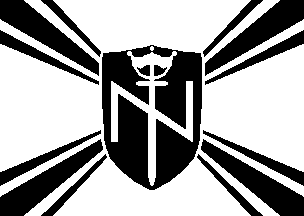
AN Flag
(black and white variant)
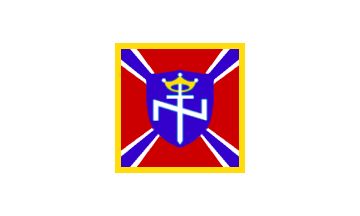
AN Flag
(white flag with "The Shield" logo)
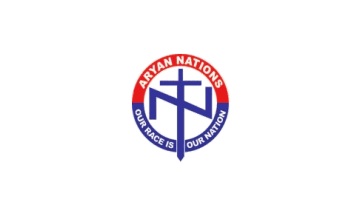
AN Flag
(white flag with newer alternate logo)
|
Aryan Nations (USA)
Aryan Nations (AN) is a white nationalist neo-Nazi organization founded in the 1974 by Richard Girnt Butler as the political arm of the Church of Jesus Christ-Christian (CJCC). As of December 2007 there were two main factions that claimed descent from Butler's group.
Aryan Nations was called a "terrorist threat" by the FBI, and the RAND Corporation called it the "first truly nationwide terrorist network." The organization has been at the center of violent racist activity since its inception in 1974. During the 1980s and early 1990s, neo-Nazis, racist skinheads, Klansmen and other white nationalists convened regularly at the Aryan Nations Idaho compound for its annual "World Congress." However, during the early 2000s the group lost a very costly civil lawsuit against the Southern Poverty Law Center that depleted the AN´s finances, and a slow decline followed that cumulated with the 2004 death of their founder Richard Butler. Today Aryan Nations has splintered into several smaller groups with various people in competition for the leadership of the movement.
|
|
|
The "Shield" Banner
(unbordered Variant) |
|
The "Shield" Banner
(Bordered Variant) |
The AN flag has appeared in both a square and rectangular shape, and is sometimes displayed with a gold fringe when used indoors. The square variant is called the Aryan Nations "Shield" and was carried in demonstrations in the form of a vertical banner. The AN also used a stripped version of the AN flag, as well as re-purposing for their demonstrations the more traditional Confederate Naval Ensign, the Christian Church Flag, and various versions of the Confederate Stars and Bars. The Aryan Nations also uses several white fielded flags: the first charged with "The Shield" and the second charged with an alternate emblem (sword over the letter N, both in blue, surrounded with a bicolor ring, top half of which is red and charged with the inscription ARYAN NATIONS, and bottom half is blue and charged with the inscription OUR RACE IS OUR NATION; the tip of the sword is set over the bottom of the ring, dividing it into two).
|
|
|
Werewolf Youth Legion Flag |
|
CJCC/AN-WYL Pennant |
The Werewolf Youth Legion (CJCC/AN-WYL) is the Aryan Nations Youth division whose purpose is to attract and sell to American youths the doctrines of their versions of National Socialism and White Supremacy. |
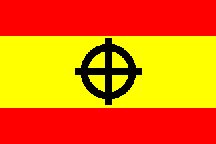
BBAA Flag
(Type 1)
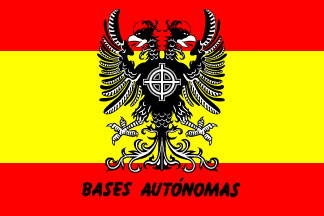
BBAA Flag
(Type 2)
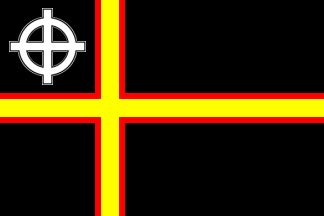
BBAA Flag
(Type 3)
This group was very active hanging a wide variety of hate posters in the streets of cities like Madrid and Sevilla in the early 1990s
|
Autonomous Bases (Spain)
Bases Autónomas (BBAA)
The Spanish red-yellow-red flag defaced with a Celtic Cross (Sun Wheel) and/or a Carlist-like double eagle are flags of Bases Autónomas (BBAA), a loose almost defunct neo-Nazi organization. Although the BBAA disbanded, some sleeper cells are rumored to still exist in several cities, especially Madrid and Burgos. Most of the militant leaders of this neo-Nazi, anarchist, violent and clandestine organization now conduct their militant activities from within other groups, such as Resistance, the DN, NuevOrden, Falangists and the Revolutionary Nationalist Coordinator.
Some BBAA-like Spanish cell organizations still exist, such as Hermandad Nacionalsocialista Armagedón (Armageddon National Socialist Brotherhood), which is active in the Valencia area and split from Acción Radical in 1998. The Armageddon Brotherhood has claimed responsibility for Molotov cocktail attacks against branches of the Popular, Socialist and Izquierda Unida parties in some towns near Valencia.
Other variant flags reported as being used by the Bases Autónomas
Other rumors about the Bases Autónomas still circulate, such as ex-members of this defunct Spanish hate organization still allegedly having links to other fascist groups still operating in Italy. These various variants of their flags are still manufactured for ignorant tourists who still buy them as historical Spanish flags in souvenir shops throughout Spain.
|
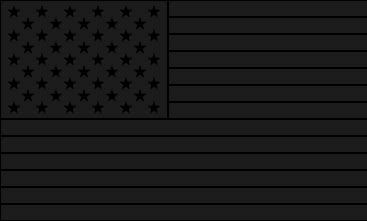
The All-Black US Flag
|
All Black "Stars and Stripes" c. 2000
The reoccurring appearance of all-white Stars and Stripes seems to have eventually inspired the introduction of a similar all-black flag. Seen from any distance, it may look like a plain black field with no design at all but when moving in the breeze, the observer can make out heavy stitches which outline the stripes, as well as the stars embroidered on the canton, all looking "blacker than black".
A recent surge of popularity prompted a number of online shops to include the flag in their offer. It is especially favored by the ultra-rightists, who claim that the Confederate units in the Civil War used all-black flags to indicate that they would never surrender - the opposite of the white flags. This story was soon expanded to claim that those were the "no quarter" flags, signifying that no prisoners would be taken, the enemies being killed instead - closer to the original meaning of all-black flags, which had signified the piracy long before the Civil War. This flag thus reflects the growing hostility of American ultra-rightists towards everyone who does not share their beliefs, openly speaking of resorting to violence, even about an approaching "second Civil War". |
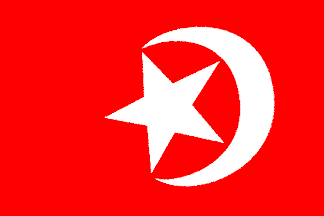
Black Muslim Flag
|
Black Muslim Movement Flag (USA)
Today, the Black Moslems are known as the "Nation of Islam" and are directed by Reverend Louis Farrakhan. They are not the militant organization of the past. In the early 60s, the Black Muslims were very active and violent extremist. In fact, Middle East Muslims rejected the American Black Muslim version of Islam, which was pretty much just a hate the white man movement. Malcolm X, perhaps their most well-known leader, eventually abandoned many of these violent ideas and converted to true Sunni Islam. Because of this, he was gunned down in a mosque by two black men wielding shotguns.
Today, they describe their flag as "the symbol of unity of all Muslims throughout the World." It basically is a mirrored version of the Turkish national flag with an enlarged crescent and star. The star is oriented with two points inside the crescent. The symbols of the sun, moon, and the stars, represent the universe. The flag differs slightly from their logo which has the individual letters "F, J, E, and I" placed in the four corners. They are said to stand for Freedom, Justice and Equality, and Islam.
|
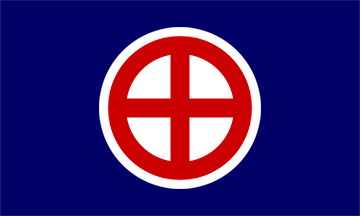
BM Flag
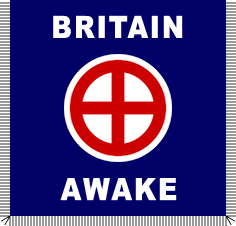
BM Ceremonial Flag
|
The British Movement (United Kingdom)
British National Socialist Movement
The British Movement (BM) was founded in 1968, by the former members of the British National Socialist Movement (BNSM), a similar organization founded in 1962. Active all through the 1970s, the group collapsed as a cohesive group in early 1980s, but remnants have managed to survive until the present time. Its flag is blue, charged with a red sun cross, or "sunwheel", on a white disc. Blue armbands with the same design were used. This flag has occasionally seen more recent use by the British National Party (BNP).
The BM also used a ceremonial flag, or banner, which they called the "Honour Standard". It was charged with a white inscription BRITAIN (above) and another white inscription AWAKE (beneath) the sunwheel, and it had a white fringe. It was usually flown from a staff with the crossbar. A sunwheel style finial and name plate with the initials BM were usually mounted above the banner. Sometimes another similar name plate was attached beneath on the staff. It was, of course, designed to be similar to the ceremonial banner used by the German National Socialist Movement (NSDAP) and helped identify the British Movement with its German predecessor. This ceremonial design was also used on hand-held flags.
|
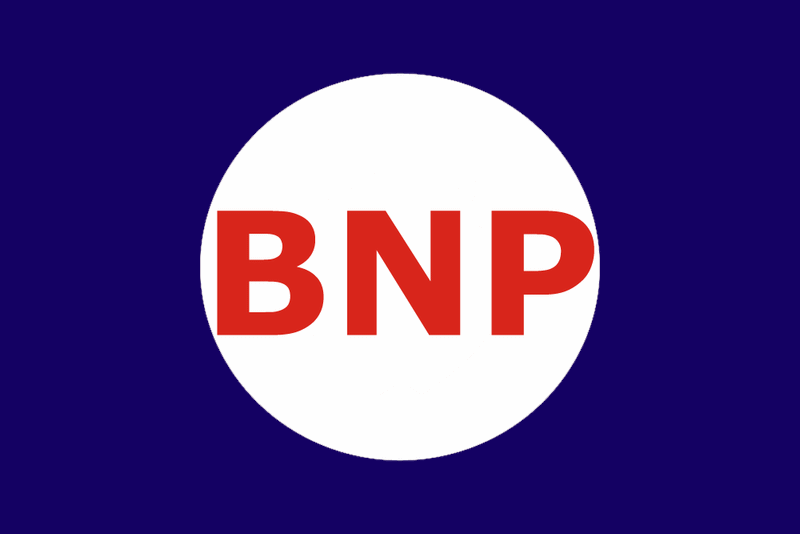
BNP Flag 1982
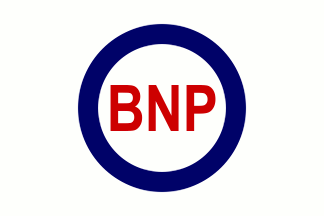
BNP Flag 1999
|
British National Party (Great Britain)
The British National Party is a far-right political party founded by John Tyndall in 1982 by merging several similar fascist parties including the old National Front. The BNP identified with Nazism with its activities, associations and publications, and its active denial of the Holocaust. Tyndall exclaimed "Mein Kampf is my bible." In 1999, Nick Griffin became the new leader of the BNP party and continued its policies of right-wing populism, white nationalism, and calling for "ethnic cleansing." Although the BNP has described itself as British nationalist, racial nationalist and "ethno-nationalist." They still call for a "voluntary resettlement" of all immigrants and their descendants back to the countries of their origins, support all anti-immigration policies, demand a return of capital punishment, oppose all forms of gay and same-sex marriage, and what they call the "Islamification" of the UK.
In recent years the party has also concentrated on opposing Islam and actively campaigns against the establishment of mosques, halal meat and what it calls the "Islamification" of the United Kingdom.
The original BNP party flag had a white circle centered on a blue field, with the block letters "BNP" in red centered in the circle. After Nick Griffin took over the leadership of the party the flag was design was changed to a plain white field, less bold lettering in red with a blue circle drawn around it. |
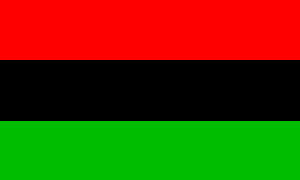
Afro-American Flag
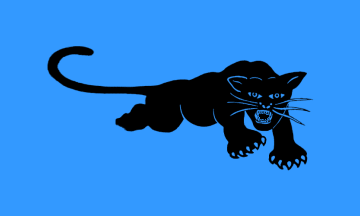
George Jackson Funeral 1971
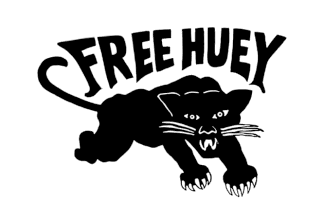
The "Free Huey" Flag
with white background
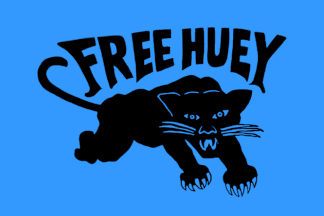
The "Free Huey" Flag
with blue background
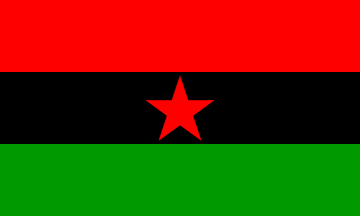
Afro-American Variant
with red star
|
Black Panther Party (USA)
The Black Panther Party, originally known as the Black Panther Party for Self-Defense, was an African-American revolutionary leftist organization founded in Oakland, California, by Huey Newton and Bobby Seale in 1966. The Black Panther Party achieved national and international notoriety through its involvement in the Black Power movement and in U.S. politics of the 1960s and 70s. The organization initially claimed to be protecting the African American neighborhoods from police brutality, but the leaders soon claimed to be followed Socialist and Maoist Communist doctrines. It was active in the United States from 1966 until 1982.
|
|
|
Black Panther with yellow background |
|
Black Panther with white background |
Although the Black Panthers were not noted for showing flags at their many rallies and demonstrations, the flag that is still most associated with them is the Afro-American Flag. Another popular flag featured the springing black panther (the party logo designed by Emory Douglas) under the words "Free Huey", which was used at demonstrations against Newton's imprisonment. A variant of the flag made a reappearance at the 40th Reunion of the Black Panther Party on September 15, 2006, in Oakland, California.
A plain flag with just the springing Black Panther logo centered on it was used by the Lumpen, a music band which publicly supported the party c1970, and also at George Jackson's Funeral in Oakland (shot to death by prison guards in San Quentin Prison during an escape attempt) in 1971.
Over the years there have been many variants of the springing panther flag with differing fonts and panther designs. Because of the use of black and white photography during the Panther's heyday, many photos of the black panther flag appear to show white or gray background, although the flags frequently had light blue or even yellow fields.
The yellow used was the same as used on the Gadsen Flag, which in the sixties and seventies was used by radicals at opposite end of the spectrum than today's Tea Party. The light blue used was the same as used on the Viet Cong flag.
The last variant shown at the left is an Afro-American Flag with the addition of a red star on the black strip that was reportedly seen in Oakland in 1989 at the funeral of Huey Newton. It also saw use by the African People's Socialist Party (APSP), another Black Power party founded in 1972, as well as by the African Socialist International (ASI), which was founded by the APSP in 1982. |
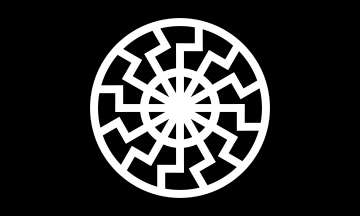
Sun Wheel Flag
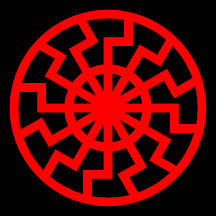
Sun Wheel Flag
(Red variant)
|
The Black Sun
Schwarze Sonne
The Black Sun, or Sun Wheel, is an occult symbol modeled after the central pattern of the floor mosaic in a hall of Wewelsburg Castle in Germany. Construction of a planned cult center for the German SS forces was planned there by Heinrich Himmler, but never completed. It is not known whether or not the mosaic was placed on the floor during the work on the hall between 1938-1943, or if it was there previously. Some scholars have tried to trace it back to the late Roman and early medieval periods, but this all remains speculation.
The symbol has, however, been adopted by neo-Nazi groups and placed on a variety of flags. The name Schwarze Sonne (Black Sun) came into use after World War II. It is not known what the original Nazis occult name for the symbol was or what it actually stood for. It was especially promoted by Miguel Serrano, an esoteric neo-Nazi writer from Chile, as the symbol of an invisible source of spiritual energy which would repurify the blood of Aryans and bring on a new Golden Age. Serrano claimed that Aryans were descendants of extragalactic beings called Hyperboreans and they could restore their "blood-memory" in the light of the "Black Sun."
In 2016, the symbol colored in red also appeared on a flag with a black field. The flag was square, or nearly square, and photographed in Roussillon, France, most likely used by members of the French Nationalist Party (Also see Irminsul Symbol on this page). The ratio of the symbol on the red variant also seemed to be slightly larger than in general use. |

The Branch Flag
|
The Branch Davidians (USA)
This is the flag flown at the Mt. Carmel Branch Davidian Compound during the infamous Waco Siege in 1993. The Branch Davidians, or simply "The Branch," were an extremist religious group that split from the Seventh-Day Adventist Church in 1930s. The Davidians believed themselves to be living in the time of the Biblical Final Judgment and Christ's Second Coming. The group and its members were "excommunicated" by the Adventist Church after the split.
The Mt. Carmel Branch flag featured a stylized six-winged fiery serpent flying over the white earth below with the "Seven Seals" of Biblical prophecy lined up on the horizon in position to trigger the Apocalypse. They gained national notoriety for their violent 51 day stand during the "Waco Siege of 1993." During the seige, the FBI, ATF agents, and the Texas National Guard lay siege on the Mount Carmel Center near Waco, Texas, resulting in the deaths of their leader, David Koresh, and 82 of his followers, plus four Bureau of Alcohol, Tobacco, and Firearms (ATF) agents. |
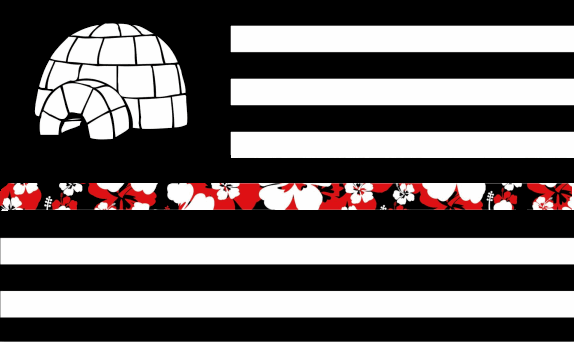
Boogaloo Flag (Type #1)
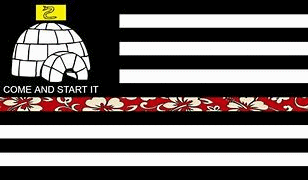
Boogaloo Flag (Type #2)
with reversed igloo logo
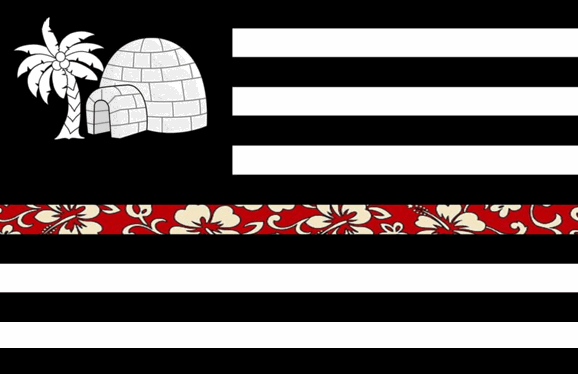
Boogaloo Flag (Type #3)
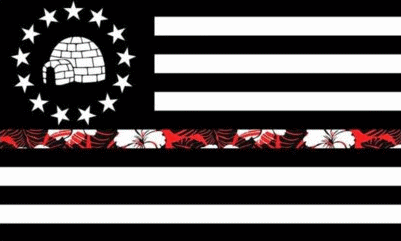
Boogaloo Flag (Type #4)
|
The Boogaloo Movement 2019 (USA)
The Boogaloos are a far-right anti-government extremist movement or milita. They are often referred to as "boogaloo boys" or "boogaloo bois." They often identify themselves as "libertarian" and say they seek to incite a second American Civil War which they call the "boogaloo."
According to the Southern Poverty Law Center, "the term 'Boogaloo' which began to predominate in far-right web spaces in early 2019, began as a shorthand for civil unrest following potential local or federal firearms confiscation and has been embraced by antigovernment and white nationalist communities."
The movement especially attracts a combination of gun rights, anti-government, white supremacist, neo-Nazi, and racists who believe that the impending unrest will become a race war. At demonstrations they appear heavily armed and often dressed in Hawaiian shirts and military fatigues. They use logos and other imagery incorporating igloos, palm trees, and Hawaiian prints. The members claim that the group and its ideology are nothing more than online jokes, similar to those used by the Proud Boys, but militant members of the Boogaloo Movement have been charged with violent crimes, been linked to violent disruptions in the George Floyd and Black Lives Matter protests, and the killing of two security and law enforcement officers.
|
Boogaloo Flag (Type #1) with reversed Logo |
They often refer to their flag as either the "Big Igloo" or "Boogalloo" Flag. The main flag (Type #1) used by the group is a modified black and white striped national flag where the canton features a white igloo on a black field. The stripe below the canton adds the only color to the flag done with a Hawaiian print. One variant Boogaloo flag (Type #2) adds the popular "Snake and Pepe the Frog" meme that has become popular with far-right extremist groups, above the igloo and the words "Come and Start It" below.
Another variant (type #3) features a palm tree and igloo in the black canton. The Type #4 variant uses a Betsy Ross circle of stars around the igloo in the black canton. The Hawaiian prints differ in multitudes of variants, as does the overall flag designs.
|
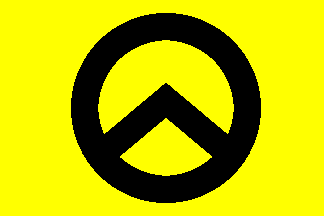
BI Flag (yellow)
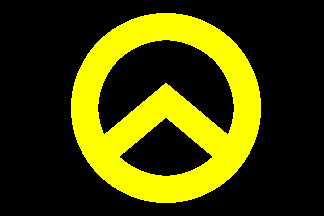
BI Flag (black)
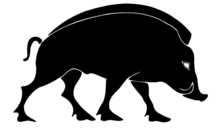
Current BI Logo
|
The Identity Block (or Identitarian Bloc) (France)
Bloc Identitaire
The Bloc Identitaire is an extreme right French nationalist political group. It was founded in 2003 by former members of Unité Radicale and several other nationalist groups. The Bloc Identitaire claims to represent all "young French and Europeans who are proud of their roots and of their heritage." It opposes what it calls "miscegenation" and "imperialism" (both American and Moslem), and has organized campaigns and demonstrations, sometimes violent, against Moslems, Jews, Communists, and other non-white ethnic and political groups. The Bloc identitaire runs the Nationalist Press Agency and website called Novopress, and identifies itself with other neo-Nazi and extremist groups in other parts of Western Europe and North America.
One of their more imaginative, and less violent, activities was the use of soups with pork as "identity soups" (soupes identitaires) to attack and belittle certain ethnic groups. The group has been banded as "discriminatory and xenophobic" by HALDE (High Authority for the Struggle Against Discrimination and for Equality - Haute autorité de lutte contre les discriminations et pour l'égalité) a French "independent administrative authority" which "has the right to judge all discrimination, direct or indirect, that is prohibited by law or an international agreement to which France is a signatory."
|
|
|
Traditional Flag of Languedoc Province |
|
Traditional Flag of Roussillon Province |
The flag most commonly attributed to the Bloc Identitaire has either a yellow or black field, with the symbol of the lambda Spartan centered on it in contrasting black or yellow. A number of these flags were used by the BI at the "Pigs' March," organized on May 14, 2011, in Lyon. The BI, like many extremist groups, is perfectly willing to "hijack" traditional flags and symbols for their use. The traditional flags of Languedoc and Roussillon Provinces would be perfect examples of this "borrowing to legitimize" by the Bloc Identitaire, who have displayed these flags during their demonstrations and parades. The newest BI Party symbol/logo is the black boar, but has yet failed to materialize on any flag. |

BI Flag (yellow)
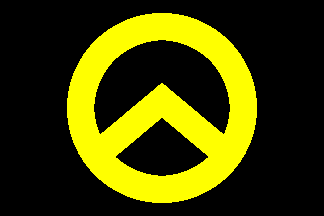
BI Flag (black)
|
Identitarian Bloc (Germany)
Identitäre Bewegung
The Identitarian Movement is a German ultra-rightist movement modeled after the French movement of the same name. It was founded in 2012 and along with a shared ideology, it also uses the same symbols used by the French Identitarians on their flags: the black "Spartan lambda" on a yellow field, and the reversed colors of a yellow lambda on a black field.
|
|
|
Josef Wirmer's Resistance Flag |
|
Munich Lozengy Flag (traditional) |
Along with their organization flags, the national flag of Germany is also widely used by the group. Josef Wirmer's "Resistance Flag" (which has become popular among German ultra-rightists over the last several years) is also seen at times, as well as a variety of local flags, such as the black and yellow lozengy flag of Munich which has been frequently photographed in demonstrations outside that city, suggesting that the local Munich branch of the movement is very active nationwide.
Identitarian Movement Austria (Austria)
Identitäre Bewegung Österreichs
Using identical BI flags there is also the Identitarian Movement Austria (Identitëre Bewegung Österreich), sometimes spelled Identitarian Movement of Austria (Identitäre Bewegung Österreichs), also founded in 2012. It, like its German counterpart, is modeled after the Identitarian Bloc (Bloc Identitaire) of France.
|

BR Flag
|
Red Brigades (Italy)
Brigate Rosse
The Red Brigades was an Italian Marxist-Leninist terrorist organization that was behind numerous violent incidents, assassinations, acts of sabotage, bank robberies, and kidnappings. The Red Brigades attained notoriety in the 1970s and early 1980s with these violent attempts to destabilize Italy. First formed in 1967, this violent left wing extremist organization sought to create a "revolutionary" state through armed struggle, and to force Italy to leave the North Atlantic Treaty Organization. In the late 1980s, the group was broken up by mass arrests and then slowly faded into insignificance as the leadership turned on each other. |
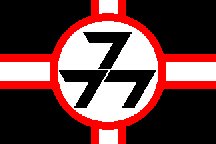
BWB Flag (under von Maltitz)
.jpg)
BWB Flag (under Ford)
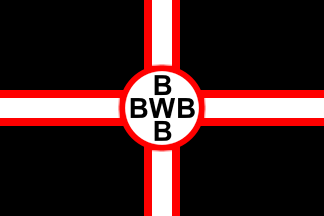
BWB Flag (current variant)
|
Boer Resistance Movement (South Africa)
Boere Weerstandsbeweging (BWB)
This was the flag of Boere Weerstandsbeweging (BWB) which was black with white cross fimbrated red; in the center of the cross is a white circle fimbrated red with three black "7"s. The BWB was initially led by Eddie von Maltitz and subsequently by Andrew Ford. This flag and its symbol are now also being used by European Nazis as they have volunteered to fight in a race war in South Africa.
When Andrew Ford took over the leadership the flag was replaced by a similar one instead of having the three 7s, bears the letters BWB in white arranged in a triangular fashion (pointing downwards) on a similarly directed black triangle.
The group appeared either to have gone underground or had ceased to exist, because their public activities were curtailed after 1999, but a new website has appeared in 2012. Until the appearance of this new website, their last public activity as the Boer Resistance Movement was when they offered to send a force of 35 volunteer soldiers to Yugoslavia in 1999 to help defend Serbia against "NATO aggression." It is unknown if anything ever came of this offer.
Their current BWB flag, which is featured on their website, has a cross composed of five black letters, four B's and one W, arranged on the white disc so as to give the abbreviation BWB both horizontally and vertically. The white cross is described as the symbol of faith and purity, its red borders as the symbol of both the blood Christ shed on the cross and the blood Boer people shed in struggle for freedom, and the black field as the symbol of courage and determination of Boer people.
How viable this new rebirth of the BWB is cannot yet be determined, but the website seems to be a serious recruitment effort. On their website they state they hope to bring the Boer nation together, and point to the current South African government as "a sadistic and racist regime" that must be stopped, stating their main goal is to free the three Boer republics (Transvaal, North Natal, Free State) from the "Afrikaner betrayal." |
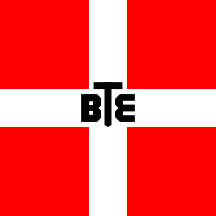
BTE Flag
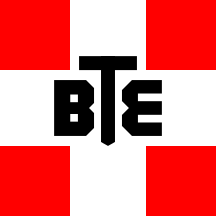
Closeup of Initials
|
League of True Confederates (Switzerland)
Bund treuer Eidgenossen (BTE)
The full name of this Swiss extremist party was Bund treuer Eidgenossen nationalsozialistischer Weltanschauung, which translates loosely into the "League of True Confederates of the National Socialist Ideology." The party was founded in March of 1938 by former members of the Swiss National Front, who thought that their old party was no longer truly following the Nazi ideology. It was led by Alfred Zander, who in September of 1938 attended the Nuremberg Rally (the annual convention of the Nazi party) and spoke in favor of the idea that Switzerland should join the Reich. In May of 1938, Bruno Oswald in Berne founded a local chapter with about 25 members, while the "national" membership of BTE would eventually reach about 175 members. In July of 1939 Zander was arrested on his return from Germany and sentenced to jail, together with other BTE leaders and party members. In October of 1940 the party was disbanded and most of its remaining members joined the National Movement of Switzerland (Nationale Bewegung der Schweiz), another similar group which intended to become a unified Swiss Nazi party. The Swiss Government banned the group the following month.
Their flag was derived from that of the National Front, adding the initials BTE to the center of the cross, thus employing the full color set of colors used on the German NSDAP flag. |
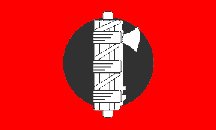
BUF Flag 1932
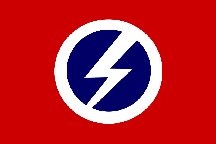
BUFNS Flag 1935
|
British Union of Fascists 1932-1940 (United Kingdom)
The British Union of Fascists (BUF) was founded in 1932 by Sir Oswald Mosley, a former Labor government minister and former MP of the Conservative Party. BUF's emblem was the one used by Italian fascists and by other fascist movements, the fasces. In the British flag the fasces was white placed over a gray disk on a red field.
In 1935, the party changed its name to the British Union of Fascists and National Socialists (BUFNS). Along with this name change appeared a new flag with the lightning flash emblem and the flag colors of the United Kingdom. The flash was white, set on a blue disk edged in white, appeared in the center of a red field. When the emblem was changed from the fasces to the circle and lightning flash, the symbolism was stated to be "the flash of action, within the circle of unity." Opponents of the party quickly named it "the flash in the pan." This flag was used until the party was dissolved in 1940.
Mosley modeled himself after Benito Mussolini and the BUF on Mussolini's National Fascist Party in Italy. Mosley instituted black uniforms for members, earning them the nickname "Blackshirts." The BUF was anti-communist and proposed replacing parliamentary democracy with elected executives having jurisdiction over specific industries, and by 1934 it had adopted antisemitism as official policy. In 1940, the BUF was banned outright by the government, and Mosley, along with 740 other fascists, were interned for much of World War II |
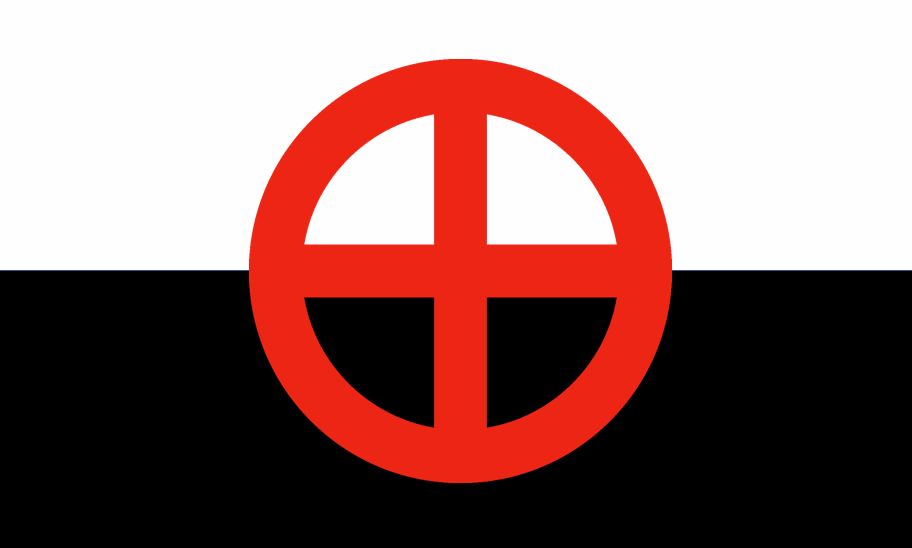
CNP Flag
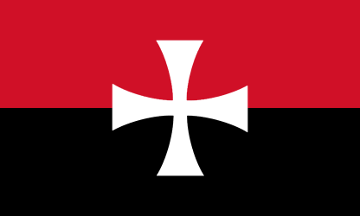
CNP Templar Flag
|
Canadian Nationalist Party (Canada)
Parti Nationaliste Canadien
The Canadian Nationalist Party (CNP) was started in 2017 by Travis Patron in Redvers in Saskatchewan, Canada. The CNP is a far-right and white nationalist political party. In 2019, the CNP was registered as a federal party by the Elections Canada. Patron and two others ran under the Canadian Nationalist Party banner during the 2019 federal election in their electoral districts. All three were unsuccessful.
The CNP's goal is "to improve the social and economic conditions of an ethnocentric Canada by maintaining the demographic majority status of white Canadians whose interests would be prioritized by the party over that of ethnic minorities."
The Canadian Nationalist Party have been seen using two flags. The first is a white and black horizontally striped flag charged with a red sunwheel centered on it. Their second flag is the black and red striped Beauceant Flag (meaning two-color), charged with a white iron cross center on it, which historically was the flag of the Knights of Templars, a famous medieval military order.
|

CFPD Flag (2006-2009)
Type #1
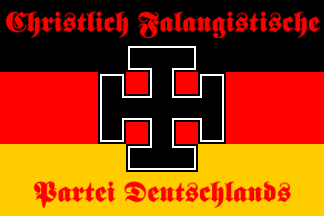
CFPD Flag (2006-2009)
Type #2

CFPD Flag (2006-2009)
Type #3 (unverified)
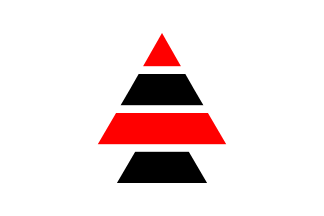
CFPD Flag (2006-2009)
Type #4
|
Christian Falangist Party of Germany (2006-2009)
Christlich Falangistische Partei Deutschlands (CFPD)
The Christian Falangist Party of Germany was founded in 2006, with the aid of the Christian Falangist Party of America, which saw it as the first step in transplanting of its ideas to other countries. However, it turned to be the last step as well, because the party has not been very successful and was disbanded in 2009, not long before its model. The party seat was in the city of Ingolstadt.
The Christian Falangist Party of Germany flags and emblems were derived from those of the Christian Falangist Party of America, whose leader Pat Bridges claimed to have designed them after having posted to a Flickr gallery several images showing different combinations of a modified German heraldic eagle with a CFPA crutch-cross. On the CFPD
party website, which is no longer online, a German tricolor, charged with the large black crutch-cross fimbriated in white and black (Type #1) was used. A variant flag (type #2) was also shown with the party name inscribed in red, above and beneath the cross. A third tricolor (Type #3), had large initials CFPD, inscribed in white on red field.
The Type #4 CFPD Flag uses a stylized tree centered on a white background and is obviously derived from the flag of the original Lebanese Falange. It is the only party flag not employing the national colors, gold being replaced with white.
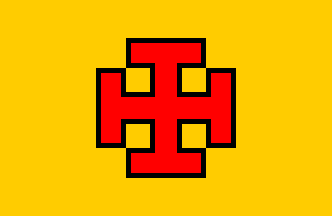 |
|
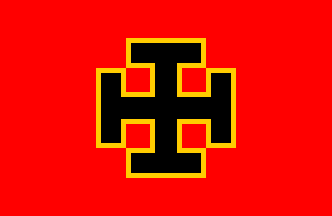 |
CFPD Flag (2006-2009)
Type #5 |
|
CFPD Flag (2006-2009)
Type #6 |
The Type #5 and Type #6 CFPD flags use a fimbriated crutch-cross symbol centered on a plain fields using variations of the German national colors.
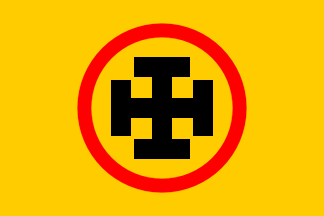 CFPD Flag (2006-2009) Type #7 The last CFPD flag (Type #7), has a crutch-cross symbol centered within a ring and is based on the 2003-2009 Christian Falangist Party of America flag, It simply replaces the United States national colors with those of Germany.
|
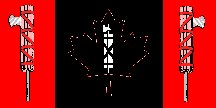
CFP Flag
|
Canadian Fascist Party (Canada)
The Canadian Fascist Party (CFP) was a fascist political party based in the Canadian city of Winnipeg. Although the party was a splinter group from the Canadian Nationalist Party and claimed to base its platform on the principles of corporativism, rather than the largely racial motivations of the Nationalist Party, many of the party membership were racially motivated. The party was founded as the British Empire Union of Fascists and was affiliated with the British Union of Fascists. It later became known as the Canadian Union of Fascists and Canadian Union, for short. It published its own newspaper called "The Thunderbolt."
|
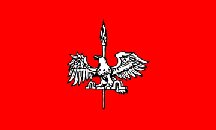
CEDADE Flag
|
Spanish Circle of Friends of Europe (Spain)
Círculo Español de Amigos de Europa (CEDADE)
The flag of the Spanish Circle of Friends (CEDADE) was probably the first "modern flag" of an European neo-nazi organization.
The official flag of CEDADE was all red with a golden eagle, holding a yoke in its claws and with a golden torch behind it. CEDADE was founded in 1966 and formally disbanded in 1993. |
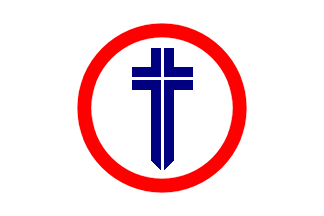
CFPA Flag (2000-2003)
(Blue Battle Cross within a red ring)
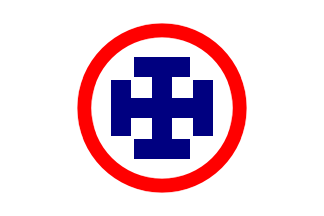
CFPA Flag (2003-2009)
(Based on the Austro-Fascist flag)
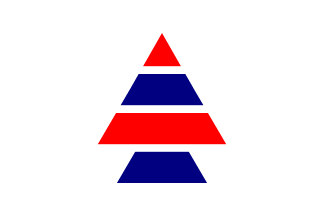
CFPA Flag (2003-2009)
(Based on Lebanese Falange flag)
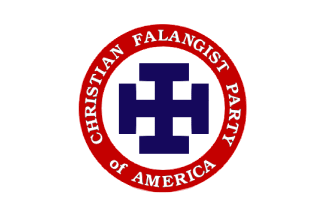
CFPA Flag (2007-2009)
(Crutch Cross Flag variant)
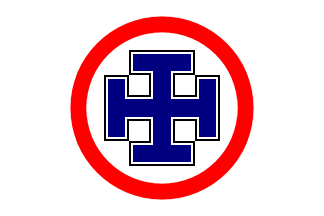
CFPA Directors Flag
(2007-2009)

"Christian Forces" Flag
(Red Battle Cross)
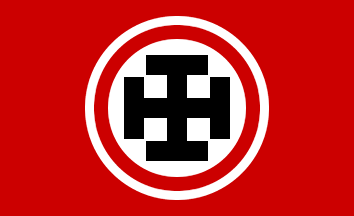
"The flag we can never use"
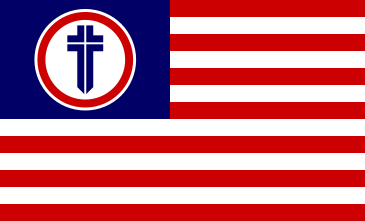
Naval Jack (2000-2003)
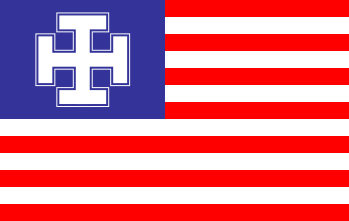
Naval Ensign (2003-2009)
|
Christian Falangist Party of America (USA)
The Christian Falangist Party of America (CFPA) was founded in Philadelphia in 2000 to replace the National Syndical American Falangist Party (NSAFP). They claimed to be dedicated "to fighting the "Forces of Darkness" which seek to destroy all of Western Judeo-Christian Civilization.
This new Falangist organization claimed that they no longer would condone acts of violence or hatred towards those of differing or opposing viewpoints and lifestyles, and they would no longer tolerate racism or anti-Semitism among their membership in any form. They severed their former ties to the Spanish Falange and all other "neo-Nazi/anti-Democratic/third position groups" who used the name Falange or Falangist. Instead of claiming succession from the NSAFP, they claimed to have derived their name from the Lebanese Falange, one of the oldest and strongest Christian parties from Lebanon, which, in fact, were originally modeled after the Spanish Falange, but gradually got rid of the Fascist "appearance" through the years, although its members still use a form of Roman salute. This new Christian Falangist Party claimed they believed only in the teachings of Jesus Christ and the Holy Bible. They supported the Constitution, the Bill of Rights, and nationalistic loyalty to the United States of America. Unfortunately, in practice, it soon turned out to be business as usual.
The original party flag was charged with a blue "Battle Cross" within a red ring, all on white field. The cross was derived from a similar one which was used by the Lebanese Forces, a former militia and current political party of Lebanese Christians, which was also partly modeled after the Lebanese Falange (borrowed their form of Roman salute, etc.). In 2003, The "Battle Cross" was replaced with a crutch-cross. This emblem was derived from that of the Fatherland Front (Austria 1934-1938), whose ideology was known as the Austro-Fascism, but although it was authoritarian and corporativist, it was generally less oppressive than most similar contemporary European regimes. It certainly was anti-Nazi and opposed the Anschluss; their first leader, Chancellor Engelbert Dollfuss, was killed by the Austrian Nazis during an unsuccessful coup in 1934 and his successor, Chancellor Kurt Schuschnigg, was sent to a concentration camp after the Anschluss. After the war, Schuschnigg moved to the USA and became a US citizen and the professor of Political Science at Saint Louis University. The Christian Integralist and anti-Nazi ideology of the Fatherland Front was chosen by the CFPA to be their new source of inspiration.
It should be pointed out here that the Crutch Cross a simplified version of the "Jerusalem Cross," or the "Crusader's Cross." They are a heraldic cross and a Christian symbol consisting of a large Greek cross surrounded by four smaller Greek crosses, one in each quadrant. They, like many other historical symbols, have been commandeered by extremist groups in an attempt to legitimize their existence. The Jerusalem Cross is also used on the flag of Georgia.
Along with the Fatherland Front, the Lebanese Falange remained the model for the CFPA and an alternative party flag was introduced after 2003, using a stylized tree like the cedar of the Lebanese Falangists, but striped in red and blue on white field so as to display the US national colors. The "Battle Cross" has reappeared, in a slightly modified form and painted in red, on white flag of the "Christian Forces", a would-be militia or social organization which seems to never have been really operative (which makes it difficult to decide about their real nature), although an address was reserved for their planned website which never appeared, only their flag having been regularly presented along with the party flags. A rarely used variant of the official party flag was introduced in 2007, with much darker shades of blue and red and charged with the party name inscribed in white over the ring.
|
|
|
|
|
CFPA Security Service Flag #1 |
|
|
|
CFPA Security Service Flag #2 |
|
CFPA Security Service Flag #3 |
During the CFPA's active existence, their private militia security force called FALSEC (Falangist Security) has used three different flags. These were produced as a part of a whole range of flags, including a naval flag, called "jack" before the 2003 flag change and "ensign" afterwards, and a standard for the Directors (national and state heads of the party) since 2007. Probably the strangest flag was "The flag we can never use", which was declared as banned on the party website because its design resembled some far-right flags too closely and might have misled visitors to attribute the site to a neo-Nazi group.
|
|
|
Christian Zionists of America Flag
(Blue Crutch Cross) |
|
Christian Zionist Roman Catholics
(Blue Jerusalem Cross) |
In accordance with their anti-Muslim and pro-Israeli attitude, CFPA started a partner organization, the Christian Zionists of America (CZA), which adopted a flag derived from that of Israel. A second partner was planned, the Christian Zionist Roman Catholics (CZRC), which would use a flag similar to that of the Christian Zionists of America, but with a Jerusalem Cross instead of the crutch-cross. The CZRC was never started, because the CFPA was officially disbanded in 2009. It has since re-invented its self as the Christian Phalange Organization.
Between 2006-2009, an associated Christian Phalange group called the Christian Falangist Party of Germany was organized in Germany, without much success. |
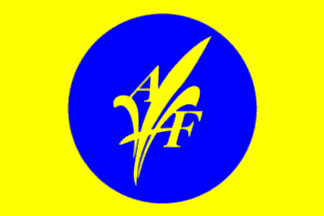
CRAF Flag |
Royalist Center of French Action (France)
Centre royaliste d'Action française (CRAF)
Founded in 1998 by Pierre Pujo, this is the ideological successor of the French Action (Action française), a nationalist, anti-republican and anti-Semitic movement founded in 1898 by Henri Vaugeois and Maurice Pujo (father of Pierre Pujo) during the Dreyfus affair, whose principal ideologist was Charles Maurras. By 1914, it has grown into one of the strongest far-right movements in France and remained such after the Great War, despite papal condemnation in 1926, due to opinion that it was just using the Catholicism for political goals, and the 1936 ban, together with other anti-democratic movements, which was lifted in 1939. Most of the members supported the Vichy regime during the World War II, although theoretically opposing the collaboration with the Third Reich, while the others left either to activelly collaborate or to join the resistance movement. The French Action was dissolved in 1944, Maurras and Pujo imprisoned after the war as the traitors, and the movement name was illegal to use for years, its ideas still being followed by a number of groups, including the CRAF.
Flag of CRAF is yellow, with its emblem in center: a large blue disc, charged with a stylized fleur-de-lis between the letters "A" and "F", all in yellow. These charges refer to the original Action française, as well as to the French royal arms.
|
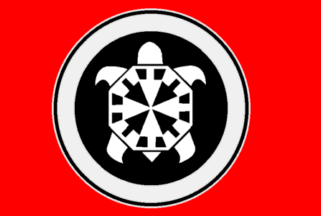
CPI Flag
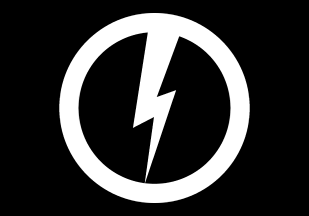
Student Bloc Flag
|
CasaPound Italy (Italy)
The neo-Fascist CasaPound Italy Movement began in 2003 with the occupation of a state-owned building in the Esquilino neighborhood of Rome. Their name referred to the American poet Ezra Pound who praised Mussolini's regime in the 1930s. Before 2006, CasaPound was associated with neo-Fascist Tricolor Flame Party, but has since become an independent movement. In 2011 it was estimated the CPI had as many as 5000 members.
Their flag is definitely Nazi-inspired, showing a black-white symbol on a red field. The symbol is a stylized tortoise, representing the ancient Roman battle tactic called the testudo (Turtle), a formation where the soldiers would form a protective shield wall overhead and around themselves as protection from arrows and thrown spears.
The Student Bloc (Blocco Studentesco) is a neo-Fascist student organization which was founded in 2006 by the CasaPound Italy. Its flag is black, with large encircled lightning flash in white. The symbol is designed so as to resemble the 1935-1940 emblem of the British Union of Fascists and the meaning is also similar, with the ring standing for the unity in a collective and the lightning flash standing for the action. Since the Student Bloc is actually the student wing of CasaPound, its members frequently carry both flags together. |
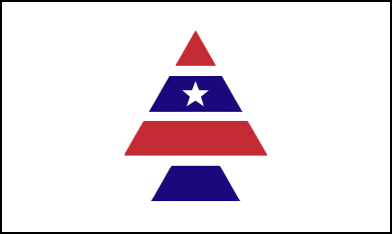
CPO Flag 2009
Based on the Lebanese Falange Flag
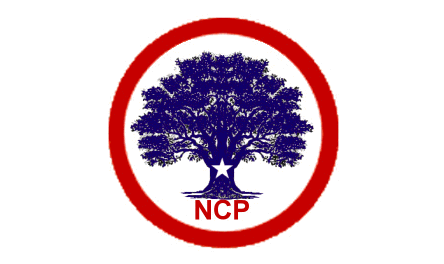
NCP Flag 2012
|
Christian Phalange Organization Flag (USA)
Formerly known as the Christian Falangist Party of America, the new Christian Phalange stated they were no longer a political party, but "a politically active social organization" in 2010. They claimed they changed their name because too many people associated the word "Falangist" with the neo-Fascist Spanish Falange and the neo-Nazis.
They now invited any Christian of any race or nationality to join the Christian Phalange and that their new goal is to stop the spread of Islam. Despite the name and goal change, they still remain, however, an extremist and very radical Christian Conservative organization. Although they say they are pro-Israeli and not at all racist or Nazi, their membership still really seems to have it in for gays and Muslims.
As the Christian Phalange cut back on their ultra-nationalistic symbolism, they also have abandoned their previous flags with the neo-Nazi-like appearance in favor of the one using a tree like the cedar of the Lebanese Falangists, but striped in red and blue, with a white star added on upper blue field.
However, the newest variant of the Christian Phalange flag to appear has a more natural looking tree (oak?) in blue, with a white star on its trunk, and the initials "NCP" (National Christian Phalange) placed in a centered red circle on white background. It appears to be the work of Pat Bridges, the leader of the CFPA/CP. |

CEI Flag
|
Circle of Indo-European Studies (Spain)
C´rculo de Estudios Indoeuropeos (CEI)
The C´rculo de Estudios Indoeuropeos (CEI) is a national-socialist organization founded in 1997. The organization claims to be a cultural movement and is considered by most to be a continuation of the "Spanish Circle of Friends of Europe. (CEDADE)"
They use a "neo-Nazi style" flag: red field, central white circle with black symbol. The central emblem is composed of the joined letters "H" and a "A," standing for "Hereditas Ambitusque," which is Latin for "Inheritance and Scope." |

Celtic Cross Flag
(Variant)
|
Celtic Cross (Sun-Wheel) Flag
Although not explicitly a racist symbol, the Celtic cross, or more properly the "Sun-Wheel," is often used by people in the white power movement, especially skinheads. The cross pictured here is one most often used by racist groups.
Many New Right groups began using this type of flag, with the main symbol being the Celtic Cross, because it isn't outlawed in most countries and they can claim it as a heritage symbol. The term "New Right" is used as a descriptive term for various policies and/or groups that are to the extreme "far-right." It has also been used to describe the emergence of extremist Eastern European parties after the collapse of communism. |
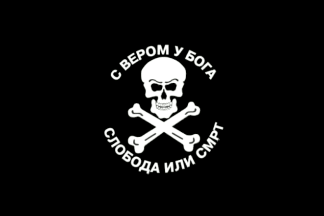
Chetnik Flag
(Type #1 - 1991-present)
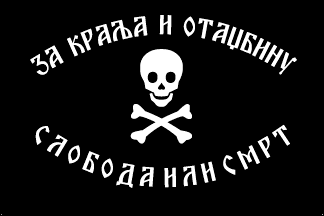
Chetnik Flag
(Type #2 - 1991-1999)
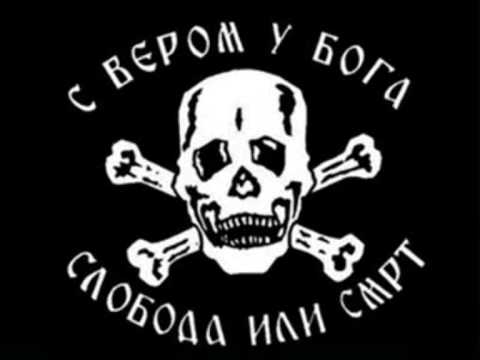
Modern Variant Flag
(Type #3 - actual use questionable)
|
Flag of the Chetniks (Serbia)
Here is a flag with a long history that proves the rule, "one man's extremist is another man's patriot." In Serbia this flag served as a resistance flag against the World War II German occupation, but now has been opted by extremist groups and others to serve very different purposes. The Chetniks (Troopers) were originally guerrilla groups which, since 1903, operated in areas still under the Ottoman rule, fighting not only against the Ottoman Empire, but also against similar Bulgarian groups. They also participated in the Balkan Wars (1912-1913) alongside the regular army, and again in World War I, in parts of Serbia which were occupied and annexed by Bulgaria (1915-1918). Along with Serbian national flags, they used black flags with skull and crossbones and inscriptions like Sloboda ili smrt (Freedom or Death). (Similar flags were also used in the Macedonian uprising against the Ottoman Empire in 1903.)
In World War II and afterwards, the Chetnik flag came to be used by anti-Communist resistance fighters. Thanks largely to Communist propaganda against the Chetniks in Serbia they were labeled extremist. The name Chetniks also became a name used by various legitimate para-military groups in the bloody Yugoslav Wars in the 1990s, but unfortunately, also became a name used by groups of local thugs and criminals hiding under the name in order to get some impunity for their actions. Naturally this Communist over-propagandizing of the name also resulted in making the flag popular among various other groups, some of whom were extremists, some not, some merely patriotic, and some who were just plain thugs. In Serbia today it is sometimes hard to determine which was which.
The original World War II Chetnik flags usually had the inscription S verom u Boga (With Faith in God) and Za kralja i otadžbinu (For King and Fatherland), sometimes with places switched, because "For King and Fatherland" and "With Faith in God" had been inscribed on Serbian military colors until 1918. Two of the flags (Type #1 and #2) shown here were used during the Yugoslav Wars. The inscriptions at the top are S verom u Boga (With Faith in God) and Za Kralja i Otadžbinu (For King and Fatherland), respectively, and Sloboda ili smrt (Freedom or Death) at the bottom. Variants of these flags, with differing text, are still also used freely by Serbian anti-Communist emigrants in Western countries as the symbol of a non-Communist resistance movement. The Type #3 variant is being sold, but its use is questionable, and has not been seen or documented in Serbia. |

Colonial Christian Republic
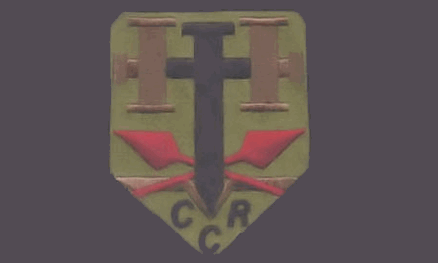
Hutaree Militia Flag
|
Colonial Christian Republic (USA)
The Colonial Christian Republic, with its Hutaree Militia, is a militant Christian fundamentalist group based in Adrian, Michigan. The group was formed in early 2008. They claim "Hutaree" means "Christian Warriors."
The group is preparing for what they believed will be an apocalyptic battle with the forces of the Antichrist (the UN), who they believed is supported and defended by local, state and federal police departments. On their website, all police and military members who would support the current U.S. system of local, state or federal government are described as members of an evil brotherhood and are considered by the Hutaree to be their enemies.
The Hutaree insignia includes a sword, crossed spears, and the letters "CCR" which stands for "Colonial Christian Republic." The Hutaree Militia uses a dull low-visibility Combat flag and a strange system of paramilitary ranks with titles from highest to lowest: Radok, Boramander, Zulif, Arkon, Rifleman (three grades), Lukore, and Gunner (three grades).
In March of 2010, nine Hutaree members were arrested in police raids in Michigan, Ohio, and Indiana, for their alleged involvement in a plot to kill various police officers and possibly civilians using illegal explosives and firearms. |
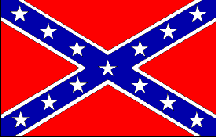
CSA Naval Jack (historic )
|
Confederate States of America (USA)
Although the Confederate flag is seen by many Southerners simply as a symbol of Southern pride, it is often used by racists to represent white domination of African-Americans. The flag remains a subject of controversy because some Southern states still fly the flag from public buildings or incorporate it into their state flag's design.
The flag is also used by racists as an alternative to the American flag, which they consider to be an emblem of what they describe as the Jewish-controlled government. |
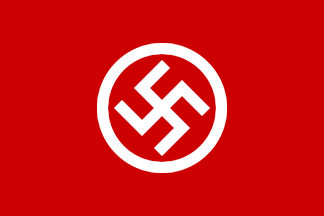
DNSB Flag
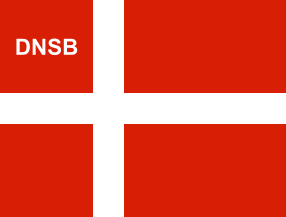
DNSB Flag (Type #2)
|
National Socialist Movement of Denmark 1991 (Denmark)
Danmarks Nationalsocialistiske Bevaegelse
The National Socialist Movement of Denmark was founded in 1991 as the latest in the list of successor parties to the original National Socialist Workers' Party of Denmark (Danmarks Nationalsocialistiske Arbejderparti - DNSAP), which was disbanded in 1945 after World War II ended.
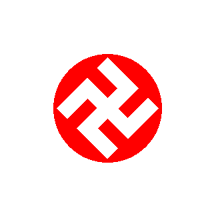 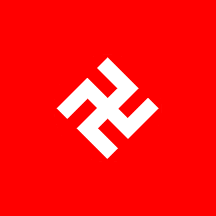
World War II era DNSAP Flags 1940-1945
The original DNSAP Flags were square (ratio 1:1) with reversed swastikas centered on them. The present DNSB flag features a red field with a white swastika within a ring of white. |
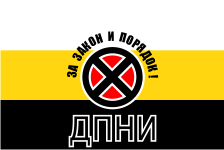
DPNI Flag
(in Romanov Imperial colors)
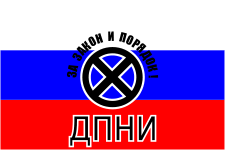
DPNI Flag
(in Russsian National colors)
|
Movement Against Illegal Immigration (Russia)
The Movement Against Illegal Immigration (DPNI) is a Russian nationalist hate group and anti-Illegal immigration organization. The DPNI was founded in 2002 by Vladimir Basmanov, in 2008 leadership passed to Aleksandr Belov (Potkin), the former press spokesman for ultra-nationalist Pamyat's leader, Dmitry Vasilyev. In 2010 the leadership changed once again, and Vladimir Ermolaev now leads the group.
The Movement Against Illegal Immigration was created in 2002, in reaction to ethnic violence between residents of a Moscow's suburb and immigrants from the South Caucasus and Central Asia. The Movement Against Illegal Immigration organized a number of anti-immigrant rallies throughout Russia. It also took part in carrying out the annual Russian March, a Russian ethnic pride display and protest event. Aside from mass protests the movement was active in organizing public pressure to support ethnic Russians in number of high profile court cases involving crimes committed by the immigrants.
Human Rights Activists had filed complaints with the Russian authorities because they believed the DPNI was "pursuing a fascist agenda," exemplified by slogans such as "Russia is for Russians!" Because the Movement continued to repeatedly take part in events aimed at igniting inter-ethnic hatred, it was finally banned by the Moscow City Court in 2011. At the present time, a suspension of the activities of the organization remains in force. The Movement Against Illegal Immigration was one of the more active political organizations in Russia with about 5000 members in 30 different regions. |
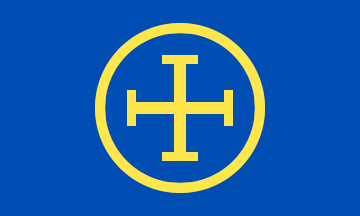
EA Flag
|
European Action (Germany)
Europaeische Aktion
Although European Action calls itself an international organization, its activities are mainly held in Germany. They have, however, demonstrated in nearby European countries such as Austria, Switzerland and Liechtenstein. They promote historical revisionism and Holocaust denial in the name of freedom of speech, call for the repatriation of all non-European immigrants, dissolution of the European Union which they want to replace by a confederation of "fully sovereign" countries. They want to defend "traditional" ways of life against "decadence" and support anti-LGBT activities.
The flag of European Action has a yellow Crutch Cross within a yellow ring that is centered on a blue field. Interestingly enough, these are the same colors used on the European Union flag.
|

Eco-Anarchists Flag (Type #1)
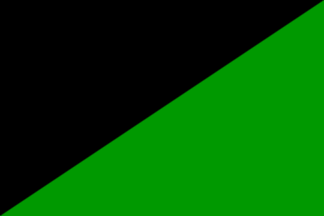
Eco-Anarchists Flag (Type #2)
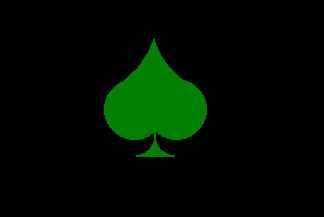
Eco-Anarchists Flag (Type #5)
|
Eco-Anarchists or Green Anarchists (Worldwide)
Green Anarchism, or Eco-Anarchism, is strange mixture of anarchism and environmental issues. Its multiple sources can be found in the teachings of such notables as Henry David Thoreau, Ralph Waldo Emerson, Leo Tolstoy and Élisée Reclus. This fusion of anarchism and naturist philosophies is now worldwide.
|
|
|
Eco-Anarchist Flag (Type #3) |
|
Eco-Anarchist Flag (Type#4) |
Unfortunately some Green Anarchists groups have engaged in direct action and acts of eco-terrorism. Groups like Earth First!, Root Force, the Animal Rights Militia, the Earth Liberation Front (ELF), the Earth Liberation Army (ELA), the Olga Cell, and the Animal Liberation Front (ALF) have taken direct action against "systems of oppression." There have been violent attacks on the logging industry, the meat and dairy industries, animal testing laboratories, genetic engineering facilities, and government institutions.
After attempted assassinations of nuclear scientists, and letter bombs sent to nano-tech and nuclear-tech facilities, many Eco-Anarchist groups, or their sub-groups, have been named as terrorist organizations. Groups like the Animal Rights Militia, the "Justice Department" and "Revolutionary Cells" have even claim responsibility for these openly violent attacks. It should be pointed out that not all Eco-Anarchist groups engage in these violent protest activities, but unfortunately, some do. |
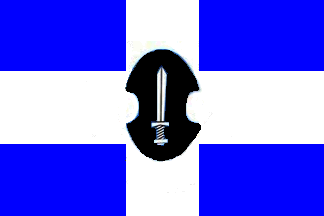
ELAM Flag
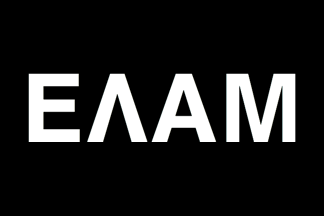
ELAM Flag
|
The National Popular Front (Cyprus)
Εθνικό Λαϊκό Μέτωπο (Ethniko Laiko Metopo)
The National Popular Front (ELAM) is an extreme-right political party founded in 2008 in Cyprus. ELAM described its platform as "popular and social nationalism" and promotes Greek nationalism. ELAM's activities include sometimes violent marches against Turkish Cypriots and attacks against immigrants and leftist progressive students.
Golden Dawn leader Ilias Kasidiaris has described ELAM as the "Golden Dawn of Cyprus." and the two extremist groups work closely together. Political racism of this sort is supported by about 4,000 people on Cyprus who regularly vote for ELAM. ELAM's members often rally at night in Larnaca dressed in black, waving Greek flags inciting anti-immigrant, racist violence, and some are members of the Cypriot National Guard.
ELAM uses a blue flag with a white cross charged in the center with the party's emblem, represented as a black old shield charged with a white sword pointing upwards. On variant flags the vertical arm of the cross is sometimes wider than the horizontal one.
ELAM also uses a black flag with the white letters "ΕΛΑΜ" on it.
|
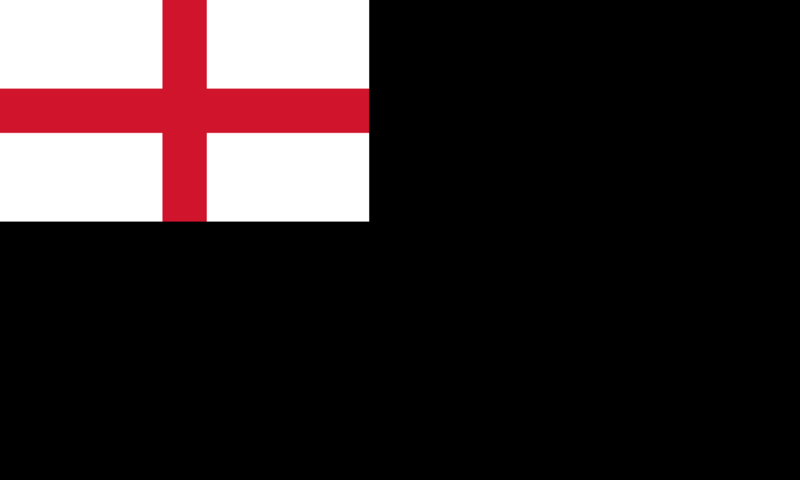
EM Flag
|
English Mistery (United Kingdom)
The English Mistery (or English Mystery) was a political and esoteric group active in the United Kingdom of the 1930s. A "Conservative fringe group" in favor of bringing back the feudal system, it was described as a patriotic organization who proposed a ´Masculine Renaissance,´ espousing an ultra-reactionary, aristocratic Toryism with an addition reference to Nietzsche, elitism and eugenics." Its views have been characterized as "aristocratic, ultra-conservative, Tory integral nationalistic, anti-liberal democratic, reactionary ultra-royalist, and anti-democratic." (Enjoy that trip to the dictionary) Basically, it was against everything to do with welfare, the London School of Economics, and the United States.
It was founded by William Sanderson, and took its title from his 1930 book That Which Was Lost: A Treatise on Freemasonry and the English Mistery. Sanderson was a Freemason, but disaffected, and founded the group in 1930 to promote his views of "leadership."
|
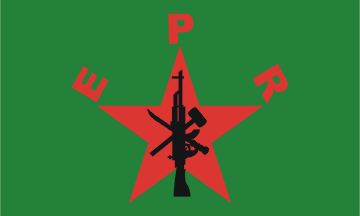
EPR Flag (type #1)
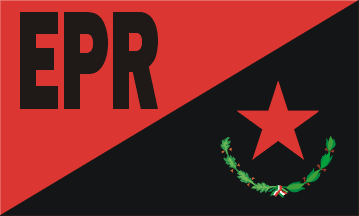
EPR Flag (type #2)
|
Revolutionary People's Army (Mexico)
Ejército Popular Revolucionario EPR
The Popular Revolutionary Army is a violent leftist movement in Mexico led by a masked leader who identifies himself as "Captain Emiliano." It was first formed in 1996 and after engaging police in a fire fight near the Guerrero capital of Chilpancingo, "declared" war on the Mexican government in a document called the Aguas Blancas Manifesto. The EPR guerrilla currently operates in the States of Guerrero, Oaxaca, Chiapas, Guanajuato, Tlaxcala and Veracruz.
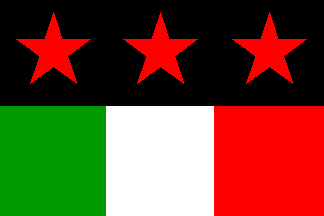
EPR Flag (type #3)
The main flag used by the EPR has a green field with a red star, superimposed over the star are crossed rifle, machete and hammer. Just off the three uppermost points of the star are the initials "EPR." Two other flags also reported in use are shown here. |
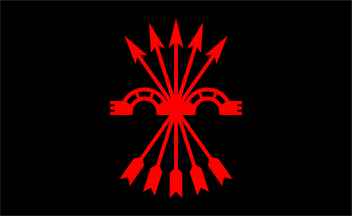
FB Flag (2000)
|
Puerto Rican Phalanx (Puerto Rico)
Falange Boricua
The name of this movement is loosely translated as "Puerto Rican Phalanx". It was founded in March 2000 as a Puerto Rican counterpart of the Spanish Phalanx and allegedly banned in May same year, after having attempted to blockade US military bases in Puerto Rico. It was soon reborn as the National Syndicalist Movement of Puerto Rico, but possibly ended its activities some time afterwards. The movement flag, as presented at their website (still existing), was charged with red yoke and arrows on black field. This flag might have inspired the Venezuelan Phalanx to adopt the same design in early 2002, claiming that it is the common flag of Latin American Phalangists.
Along with its own flag, the movement also used the Cross of Burgundy flag as the symbol of Hispanity (Hispanidad), as well as the Grito de Lares flag and the flag of the Nationalist Party of Puerto Rico, which were both considered important national symbols.
|

FDG Flag
(Sun Wheel variant)
|
Youth Front (Italy)
Fronte Della Gioventãƒâº
The Black Sun Wheel, or Celtic Cross, on a white disc has became the international symbol of the Youth Front, and adopted by other groups of young nationalist in several European countries. It is usually placed on a red field as is done with this Italian Youth Front flag.
Because this Celtic Cross was adopted by a prohibited neo-Nazi party in postwar Germany, its public display in Germany was banned along with the swastika under the federal criminal code, as part of legislation designed to forestall any revival of Nazism. However, it is still freely used in Italy and other countries. |
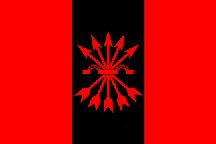
FE Party 1933
(original version)
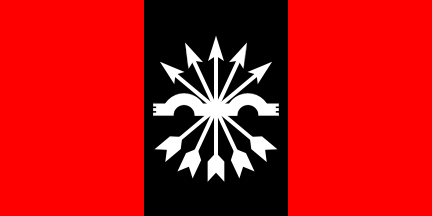
FE Party
(popular variant)
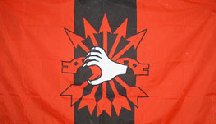
FE Party
(modern variant)
|
Spanish Phalanx 1933-1977 (Spain)
La Falange or Falange Española
The term Falange is used by several political movements and parties dating from the 1930s, including the original Fascist movement in Spain. The word "Falange" actually means "phalanx," (a Macedonian or Spartan Greek military formation) in Spanish, and there are many small parties still calling themselves the Falange Party today. The warlike symbol of the phalanx was chosen due to the militaristic nature of these National Socialist type parties. It should be noted here that the yoke and the arrows both were taken from the Catholic King's emblems (the yoke for Ferdinand of Aragon and the arrows for Elizabeth of Castile) and the same symbols were readopted by Franco's regime.
The original Spanish Falange movement was founded in 1933 by José Antonio Primo de Rivera, who was the son of the former Spanish dictator, General Primo de Rivera. Their platform (political agenda) combined the national traditions of Spain with these of Fascist ideology.
The Falange symbol was also used in World War II on a flag used by the soldiers of the Divisio'n Azul (Blue Division), a Spanish volunteer unit in the German Army which fought on the Eastern Front. It was formed in 1941, and was disbanded 1943. Theirs was certainly not the only case of using of a flag with this design: there have been many flags with the Falange symbol on them.
Today, decades after the fall of the Franco Fascist dictatorship, Spain still has several minor Falangist organizations, represented by a number of tiny political parties. Chief among these are the Falange Española (de las Juntas de Ofensiva Nacionalsindicalista), Falange Española de las JONS, Falange Auténtica, Falange Española Independiente, and FE - La Falange.
Following post-Francoist Spanish Falanges is a bit confusing, with their splitting and merging and use of similar names which have even led to several lawsuits. These fascist inspired parties are rarely seen publicly except on the ballots, in State funded TV election advertisements, and during demonstrations on historic dates, such as November 20 celebration the death of both Jose Antonio Primo de Rivera and General Francisco Franco. For example, in the 2004 national elections, these parties combined received less than 28,000 votes between all of them. |

FI Flag
|
Ibero-American Front (Mexico)
Frente Iberoamericano
The Ibero-American Front is a neo-Nazi group based in Mexico whose stated intention is to extend its activities to all Latin American countries. Although they claim to condemn all the genocides committed so far, their insistence on the "14 words of David Lane", as well as the Nazi-style graphics all over their website, clearly reveal their nature. Their stated goal is to "protect" the Creoles (Latin Americans of European origin) by formation of separate states for them wherever possible; these states would eventually gather in a Union of Sovereign and Independent Creole States.
The flag of Ibero-American Front is derived from the Cross of Burgundy flag, which is increasingly being used by Latin American ultra-rightists, with the addition a black and white cross. The cross is designed to resemble the German Balkenkreuz which, along with the complete set of colors, is another reference to the Nazism. |
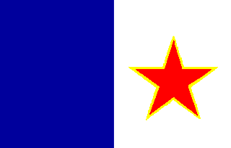
FLQ Flag
|
Quebec Liberation Front (Canada)
Front de libération du Québec
The paramilitary group Quebec Liberation Front was founded in 1963 by Georges Schoeters, a Belgian revolutionary. The goal of the FLQ was to "free" Quebec from Canada and form an independent nation. They were soon labeled a terrorist organization for their violent methods and were responsible for many violent incidents which killed eight people and injured many more, including a bombing of the Montreal Stock Exchange in 1969. In 1970, during the "October Crisis," they kidnapped James Cross, the British commercial envoy in Quebec, and assassinated Pierre LaPorte, the Labor Minister of Quebec province. By 1971, the Montreal Police Anti-terrorist Unit was able to arrest most of the FLQ leaders and dozens of members, after which the remaining FLQ broke up into several unorganized splinter groups.
The Quebec Liberation Front used a blue and white horizontal striped bicolor with a red star (bordered in gold) centered on the white fly that was seen at demonstrations between 1968-71 in Montreal and the U.S. |
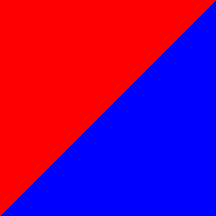
FN Flag (Type #1)
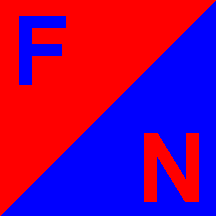
FN Flag (Type #2)
|
New Force (Spain)
Fuerza Nueva
The New Force is the name of a far-right political association in Spain which was founded by Blas Piñar in 1966 with the aim of opposing any reforms of the Fascist regime of Spain, an authoritarian state dictatorship between 1939 to 1975, that existed under General Francisco Franco. From 1976 to 1982, New Force operated as a political party, hoping to stop the transition to democracy, but the lack of political success made it eventually disband itself, although it has reappeared under different names, always under the leadership of Blas Piñar, who is the honorary president of Spanish Alternative (Alternativa Española) since 2003. The present association New Force is mainly dedicated to commemorating the anniversaries of beginning of Spanish Civil War (July 18th) and death of Francisco Franco (November 20th). Their calls to demonstrate on these dates have generally been supported by neo-Nazi, skinheads and other militants of the extreme right.
|
|
|
FN Flag (Type #3) |
|
FN Flag (Type #4) |
The New Force flag is parted diagonally red over blue, which recalls the red berets and blue shirts worn by the members of Spanish Traditionalist Falange (FET/JONS), the single party during the rule of Francisco Franco. Initials FN in counterchanged colors, or both in white or yellow, may be added to usually plain fields. |
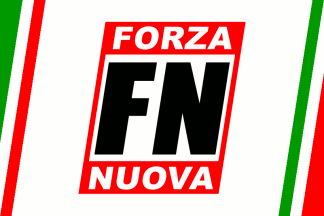
FN Flag (Type #1)

FN Flag (Type #2)
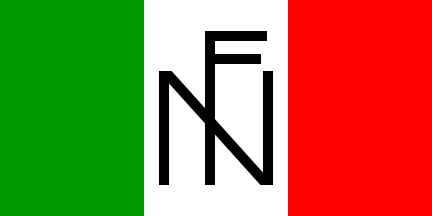
FN Flag (Type #3)
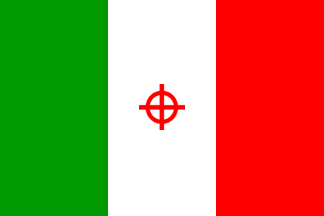
FN Flag (Type #4)
|
New Force (Italy)
Forza Nuova
The Forza Nuova (FN) is an Italian far right political party. Founded by Roberto Fiore and Massimo Morsello, and supporting the ideas of Julius Evola, the party is a member of the European National Front and was a part of the Social Alternative from 2003 to 2006. The party policies are an interesting blend of National Socialist ideology and traditional Roman Catholicism.
New Force mostly uses two flags (Types #1 and #2) charged with its logo, which is a white rhomboid charged with party name initials in black and placed in center of a larger red rhomboid which also contains party name inscribed in white above and below the central device. This logo is based on a common template used also by other European ultra-rightist movements which are members of the European National Front. Of these flags, the one much more used has black field (Type #2) and the logo height equal with the flag width, although some photos seem to show a black fimbriation. (Also see: Nordic Youth of Sweden and the
New Right of Romania [Type #3] for similar flags.)
|
|
|
FN Flag (Type #5) |
|
FN Flag (Type #6) |
At many New Force rallies, besides using the two main flags shown at the top left, a more traditional Italian Nazi Flag with the Sun Wheel (Type #5 and Type #6) has also been used both in red and black backgrounds. A NSDAP-style flag with the letters "FN" on a white disc also exists in variants of black and red colors, in fact, this variant can be found more frequently on the Web than the earlier one.
|
|
|
FN Flag (Type #7) |
|
FN Flag (Type #8) |
Either a black sun wheel or the letters FN, in somewhat different form, sometimes appear in the center stripe of the Italian Tricolor (Type #3). A sun wheel version (Type #4), the wheel usually in red, but also black, has also been reported. Also reported are Types #7 and #8 with either light blue or black backgrounds and an off-center green, white, and red rondel placed slightly behind large white block letters "FN" and words "Forza Nuova" written directly below. |
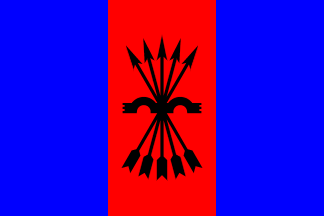
FNGE Flag
|
Ecuadorian Garcian National Phalanx (Ecuador)
Falange Nacional Garciana Ecuatoriana
The Ecuadorian Garcian National Phalanx was a Falangist group in Ecuador apparently modeled after its Spanish and Latin American counterparts. Very little is known about this small and apparently short-lived movement, although we can speculate that the name Gaciana was derived from the Spanish last name of García and suggests that the group was formed to honor a certain military man whose last-name was "García". Of course, "Phalanx" (Falangist and Falange in Spanish) is today defined as a "Spanish military, unionist, laborist, or anarchist" group. This particular Falangist group attempted to trace its origins back to the Falangism and Synarchism of the Alianza Revolucionaria Nacionalista Ecuatoriana which was started by Jorge Luna in 1948, but there seems to be little actual similarity or real connection between the two groups.
The FNGE flag was a typical Falangist design incorporating a blue-red-blue vertical triband design with Falange black yoke and arrows on the red field. |
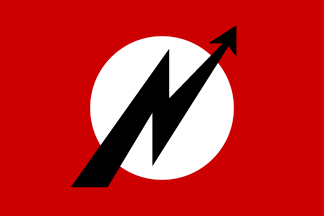
FNSH General Flag
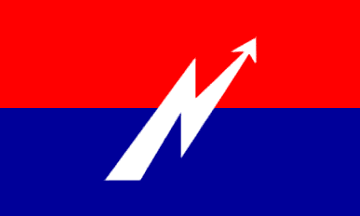
Chilean Division Flag
|
Hispanic National Socialist Front (Chile and Mexico)
Frente Nacional-Socialista Hispano (FNSH)
This apparent multi-national community of Hispanic-American neo-Nazis might be only active online and is most likely just a remnant of the Chilean National Order Front, which was disbanded in 2012. Their common symbol is actually the old flag of National Socialist Movement of Chilean Workers, while their Chilean division uses the flag adopted by the National Order Front in 2004, suggesting that this new National Socialist want-to-be was initiated in Chile.
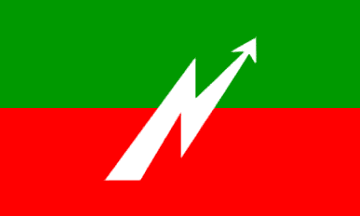 Mexican Division Flag The only other existing division, that of Mexico, uses the same flag design as that of Chile, but in Mexican national colors. |
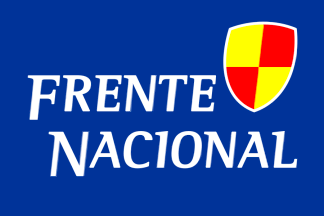
FrN Flag
|
National Front (Spain)
Frente Nacional - FrN
The National Front operated under the name "The Phalanx" between 2006-2009 after a split in the Spanish neo-Phalangist Phalanx Party (La Falange) left both factions using the same name until in 2009, when a court ruling awarded the rival faction the exclusive use of the name. After the court ruling the FrN party officially adopted the name National Front which it had previously only used to identify itself on ballots for the purpose of elections. The split in La Falange occurred due to a dispute about the leadership. The leader of the faction which eventually became the National Front, and of the National Front until the disbanding, was Jose Fernando Cantalapiedra. It never achieved any significant success after 2009 and disbanded itself in 2011.
The party flag was blue, with the party name inscribed in white in two rows and a yellow-red quartered oblique shield, fimbriated white and placed in the top fly corner. The shield and inscription on blue field were also used as the party logo. While yellow and red were used as the national colors, blue, as the color of Phalangist shirt, was probably the only remaining reference to the origins of the party. |
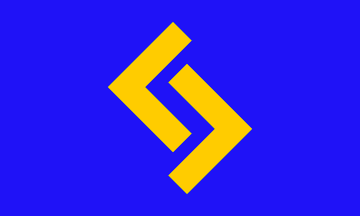
FNU Flag
|
National Youth League (Sweden)
Förbundet Nationell Ungdom - FNU
The National Youth League is a neo-Nazi movement started in in 2011 by Robin Boström. It was started with financial help from the Party of the Swedes sponcered newspaper "National Today." The name was borrowed from the 1930s pro-Nazi National Youth League of Sweden (Sveriges nationella ungdomsförbund, SNU). There followed several other Nazi and neo-Nazi youth organizations with the same or similar names, the last being the National Youth, part of the Swedish Resistance Movement, which was dissolved in 2006. The current organization describes itself as "a platform for educating young ethnic Swedes through workshops, lectures, and martial arts training." The FNU has six chapters and a national organization.
Like many other similar Swedish groups, the FNU uses a flag in national colors, with a large gold Jeran rune on blue field. The proto-Germanic rune "Jeran" dates back to approximately AD 200-400 and means "good harvest." The flag was first seen in the town of Eskilstuna in 2012 at a demonstration organized jointly by the National Youth League and the Party of the Swedes. |

MNSTC Flag 2002

FON Flag 2004
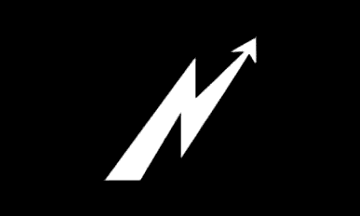
JNS Flag
|
The National Order Front (Chile)
Frente Orden Nacional
Originally known as the National Socialist Movement of Chilean Workers (Movimiento Nacional Socialista de los Trabajadores Chilenos (MNSTC), founded in 2002, this movement declared National Socialism as the only thing standing against national and international threats of the Chilean people's way of life. In 2004, the group renamed themselves the National Order Front (Frente Orden Nacional), or more simply FON. In 2012, they would disbanded themselves, blaming the hostility of Chilean LGBT organizations for the "persecution" which made further operations impossible.
However, more recently, a questionable new group calling themselves the Hispanic National Socialist Front (Frente Nacional-Socialista Hispano), or simply FNSH, has appeared on-line claiming to have "divisions" in both Chile and Mexico.
On National Order Front flags the letter "N", which stood for national socialism, was shown in the form of a ascending ray that pointed upward. Their original flag was red, with a large black thunderbolt placed over a white disc. When the group renamed themselves the black thunderbolt symbol was re-colored into white and placed over a red-blue horizontal bicolor, thus displaying the national colors of Chile. The lightening bolt like symbol was claimed to represented the birth of the movement and their stated goal of creating a society based on the values of national socialism.
National Socialist Youth
Juventud Nacional Socialista (JNS)
The FON youth wing striving to "instill habits of discipline" used special uniforms for those admitted to participate in their ranks. They felt the discipline and uniforms would lead to the "establishment of an egalitarian life," and be the "starting point" for all future Chileans to embrace National Socialism. Their youth organization flag displayed the same white thunderbolt as used by the FON, but placed it on a black field. |
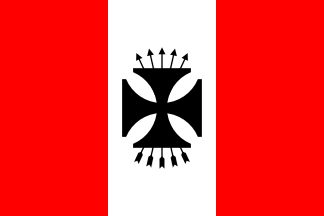
FP Flag
|
Peru Phalanx 2005-2012 (Peru)
Falange Peru
The Peru Phalanx was a minor Peruvian Fascist political movement, active from 2005 to 2012, which seemed to have been modeled after the Spanish Phalanx. Their platform (political agenda) combined the national traditions of Spain and Peru with these of Fascist ideology.
Its flag, obviously derived from the Peruvian national flag, was defaced with the FP logo (a black emblem composed of five arrows behind an Iron Cross) which was centered on the white stripe. It should be noted that the logo design is quite similar to that used by the Blue Division, the Spanish volunteers' unit in the German Army on the Eastern Front, during World War II. |
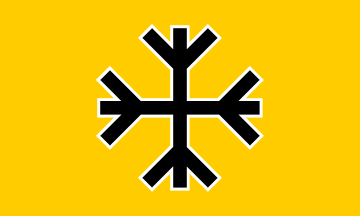
FSP Flag
|
People's Front Party 2008/Party of the Swedes 2009 (Sweden)
Folkfronten/Svenskarnas parti
The Party of the Swedes is a nationalistic political party, active in Sweden. It was founded by members of the former National Socialist Front in 2008 under the name People's Front, but was renamed in 2009 after it was revealed that a leftist party was already registered under that name. The leader of the party is Daniel Höglund, who was also one of the two leaders of the National Socialist Front. The FSP also has ties with a youth movement called the National Youth League (Förbundet Nationell Ungdom); although no official links exist with the party, they clearly have a close co-operation, and their leaders, according to the Swedish website Expo Skola, do have a common history of membership in the National Socialist Front.
The party flag uses a cross composed of Algiz (elk) runes as its main design element. Karl Maria Wiligut was responsible its adoptions by the NSDAP and it was subsequently used widely on insignia and literature during the Third Reich. Various forms of the Algiz rune are also commonly used by various Germanic Neo-pagan groups as a symbol of their religion. The flag field is yellow, the color which both symbolizes the sun and appears in the Swedish national flag. |
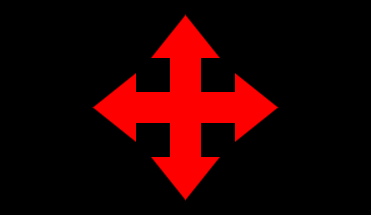
FV Flag
(original version)
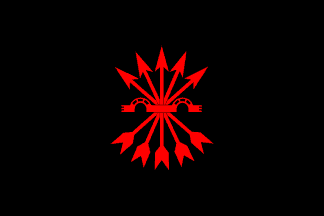
FV Flag
(newer variant)
|
Venezuelan Phalanx (Venezuela)
Falange Venezolana
The Venezuelan Phalanx is a minor political movement modeled after the Spanish Phalanx. The use of the term Falange refers to the ancient Spartan military formation and is used by several Fascist political movements and parties in Latin America.
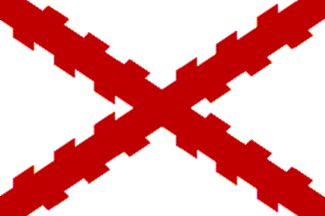 Cross of Burgundy (Spanish historical)The original FV flag has a black field charged with a large red arrow cross. A newer variant is modeled after the flag the Spanish Phalanx movement, but differs slightly in that it features an all-black field. This variant made its appearance in 2002. (Note: This flag is also similar in design to that of the defunct National Syndical American Falangist Party.) Another flag commonly seen at FV rallies is the historical Spanish Cross of Burgundy Ensign. |
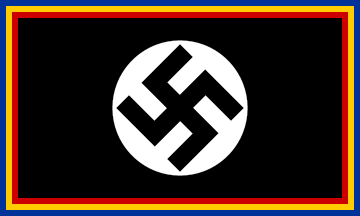
Garda de Fier Flag 1927-1938
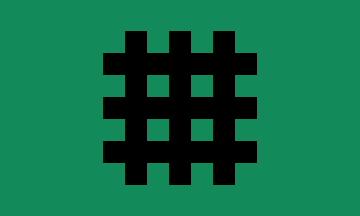
Garda de Fier Flag 1938-1941
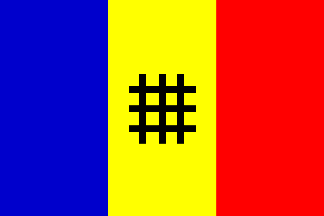
Garda de Fier Flag
(variant #1)
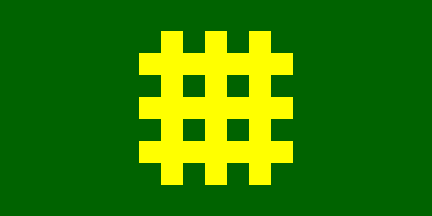
"New" Garda de Fier Flag
Not used by the original movement,
but by an organization using the same
name in the early 2000s. This variant would be also later used by the New Right Party.
|
The Iron Guard 1927-c1940 (Romania)
Garda de Fier
The Iron Guard was an ultra-nationalist, fascist, anti-communist, and extremist Orthodox Christian movement originally founded by Corneliu Zelea Codreanu, an anti-Semitic professor at the Bucharest University in 1927. Originally known as "The Legion of the Archangel Michael" (Legiunea Arhanghelului Mihail), then renamed the "Everything for the Country" (Totul pentru Tara) Party, and the "The Legionnaire Movement" ("Miscarea legionara), but the name most commonly given to this far-right Romanian movement and political party was "The Iron Guard."
Its members wore green uniforms, thus were sometimes called "Greenshirts" (Camasile verzi), and greeted each other using the Fascist Roman salute. The main symbol used by the Iron Guard was a triple cross, standing for the prison bars of martyrdom, and sometimes referred to as the "Archangel Michael Cross" (Crucea Arhanghelului Mihail).
The Iron Guard differed from other fascist movements because its membership, rather than the usual military veterans, came from the peasantry and students. However, the legionnaires shared the fascist love for violence and political assassinations. The black flag of the movement, with its swastika in a white circle, soon became well-known in Romania in the late 20s and the early 30s. It was originally used by the National Christian Party, a similar although less militant party, in whose founding Codreanu took part in 1923 before having broken away to found the Iron Guard. (A tricolor with the swastika was used later by the National Christian Defense League and the National Christian Party) After 1938, the swastika symbol was replaced by the triple cross and the black field on their flags was normally replaced with a green, but occasionally a red one.
|
|
|
Garda de Fier Flag
(variant #2) |
|
Garda de Fier Flag
(variant #3) |
The movement took part in the Spanish Civil War, and they had two prominent martyrs, both close to Codreanu, who died in the battle of Majadahonda. In 1938, when Codreanu was assassinated after the Guard started its conflict with King Carol (Charles) II over his plans to convert the country into a fascist nation. A campaign of assassinations ensued by Guard "legionnaires" who formed death squads and even though they managed to kill the prime-minister, they were almost decimated in the process. The black grid flag was completely banned by the Antonescu regime in 1941 and the new Guard leader, Horia Sima (Codreanu's successor), was sent to Buchenwald concentration camp. He was released in 1944, became the head of the Romanian government in exile until 1945, but was never allowed to returned from exile and died in Spain.
A modern neo-Fascist successor to the Iron Guard calling themselves "The New Right" was founded in 2000. |
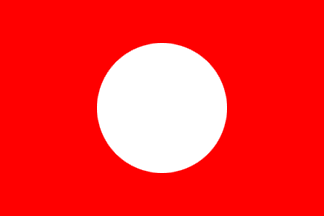
GJYP Flag
|
Great Japan Youth Party (Japan)
Dai-Nippon Seinen-tō
"Great Japan Youth Party", later renamed "Great Japan Sincerity Association" (Dai Nippon Sekisei-kai), was founded in 1937 by Colonel Kingoro Hashimoto during his forced retirement from military service because of his involvement in the attempted coup d´etat of 1936. The organization was modeled after the Hitler Youth and its goal was turning Japan into a single-party totalitarian state modeled after the Third Reich. In 1940, it was grouped with other nationalist movements into the Imperial Rule Assistance Association (Taisei Yokusankai), where it served as the youth wing of the IRAA. The organization was dissolved in 1945 after the capitulation of Japan and Hashimoto was sentenced to life imprisonment.
The flag of Great Japan Youth Party was derived either from that of the Third Reich, by omitting the swastika, or from the Japanese national flag, by reversing the colors, or possibly from both of these flags. The pattern was also used on the armbands of the Nazi-style uniforms, as well as the decoration on the official documents of the party. |
Golden Dawn Flags
with the Meander symbol
also known as the Greek Key pattern
or the Greek fret (maeandros)
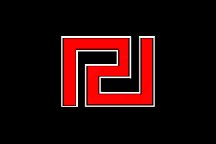
Golden Dawn Flag pre-2005
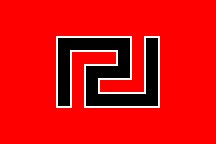
Golden Dawn Flag pre-2005
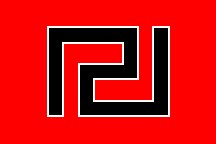
Golden Dawn Flag post-2007
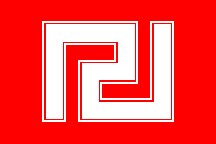
Golden Dawn Flag post-2007

Golden Dawn Flag 2010

Golden Dawn Flag 2010
People's Association
of the Golden Dawn

Golden Dawn 2012
(Black and Gold Variant)
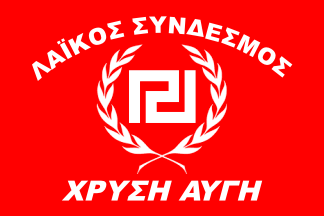
Golden Dawn 2012
(Red and White Variant)
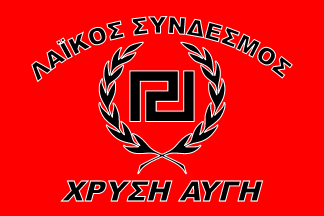
Golden Dawn Flag 2013
(Black and Red Variant)
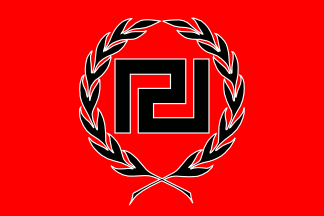
Golden Dawn Flag 2013
(Black and Red Variant without text)
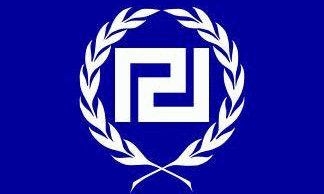
Golden Dawn Flag 2013
(Blue and White Variant without text)
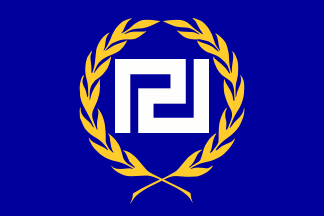
Golden Dawn Flag 2013
(Blue and gold Variant without text)
 Golden Dawn Flag 2013 Golden Dawn Flag 2013
(Black,White and Red Variant without text)
|
Golden Dawn (Greece)
Χρυσή Αυγή (Chrysi Avyi)
The Chrysi Avyi is the biggest extreme-rightist organization in Greece, not to be confused with the "Hermetic Order of the Golden Dawn," a peaceful society dedicated to the philosophical, spiritual, and psychic evolution of humanity. The Greek "Golden Dawn" is anything but peaceful, and has been responsible for carrying out acts of violence and hate crimes against immigrants, political opponents and ethnic minorities. The group favored the use of two symbols: the meander (an ancient Greek decorative pattern) and the Sun Wheel. It ceased to exist as the separate organization in 2005, merging with the Patriotiki Symmahia (Patriotic Alliance), which used different symbols. In 2007, the Patriotic Alliance ceased to exist and the Golden Dawn announced its re-activation (and reintroduction of the meander and sun wheel). Since then, the website of Golden Dawn has been regularly updated. The same is true for Metopo Neolaeas (Youth Front) website, the youth wing of the organization.
Golden Dawn Sponsored Flags using the Sun Wheel (Celtic Cross)
These Sun Wheel variants are being used by a wide-variety of extremist groups today.
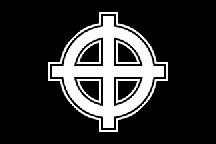 |
|
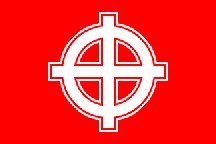 |
| Variant #1 |
|
Variant #2 |
 |
|
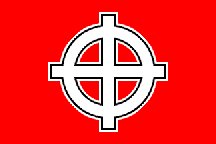 |
| Variant #3 |
|
Variant #4 |
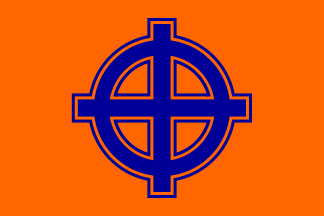 |
|
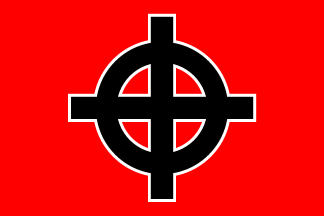 |
| Variant #5 |
|
Variant #6 (un-verified) |
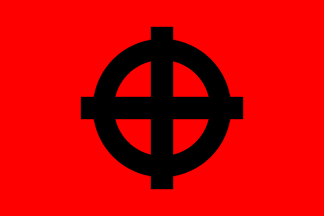 |
|
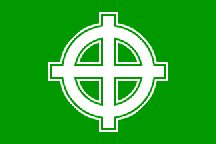 |
| Variant #7 (un-verified) |
|
Green Wing Youth |
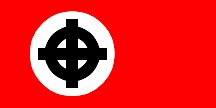
Golden Dawn Banner
Also used by Unit 88 (New Zealand)
The Prasini Pteryga (Green Wing) is an ecologist organization founded by members of the youth wing of the Golden Dawn. It uses a green flag, charged with a white Celtic Cross with outer white and inner green fimbriations.
A new flag appearing in 2010 has blue field and is charged with a smaller maeandros (meander) within a wreath, between the inscriptions LAIKOS SYNDESMOS (People's
Association) and H RYSI AYGI (Golden Dawn), possibly now the official name of the organization.
Another Golden Dawn flag (Variant #5), using a combination of a football (soccer) club colors (orange and blue), is now used by some fans of the Apoel Football Club of Nicosia, Cyprus. This is an example of how ultra-rightists attempt to infiltrate normal society, and by introducing their flag to football fans as a non-political symbol, it provides them with a valuable tool of later indoctrination.
|
|
|
"Epsilon" Design 2011 |
|
Meander Variant 2012 (use unverified) |
Two new Golden Dawn flags were introduced in 2011 and 2012. The first is charged with a large letter epsilon within a wreath, all black with white fimbriations, on a dark red field. The letter epsilon probably stands either for Ellas (Greece), Ethnos (Nation), or Ethnikismos (Nationalism). The second Golden Dawn flag appeared in 2012 and has a black Meander symbol with white fimbriations placed on a red shield with white border, all centered within a red wreath on a black field. "Golden Dawn" (in Greek) is spelled in red block letters directly below the wreath. Note: This second may only be an illustration used for Golden Dawn articles, its actual use as a flag is unverified.
In late 2013, a new flag with meander within a wreath, surrounded with
the full name of the party, has appeared. Its field is red and the charges are black, fimbriated white. The earliest photos can be found is also being increasingly used abroad, by ultra-rightists wishing to show the support to like-minded "persecutees", considering the criminal charges against the party and its members, a number of which was brought since 2012, merely as the "persecution" campaign. |
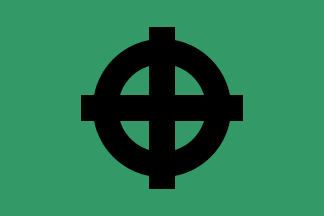
GR Flag
|
Green Rights (Belgium)
Groen Rechts
The Groen Rechts (GR) is an Ecologist ultra-rightist organization. The Green Rights website contains almost no information about the group, although since the logo of N-SA appears at the bottom of all the pages it suggests that members of the Nieuw-Solidaristisch Alternatief (Neo-Solidarist Alternative Movement) must have founded the GR. The flag of the Green Rights, with its black Celtic cross on a green field, also further suggest ties between two organizations.
The Groen Rechts green flag has been prominently displayed at various Flemish rightist demonstrations in recent years, suggesting an active membership in the area. |
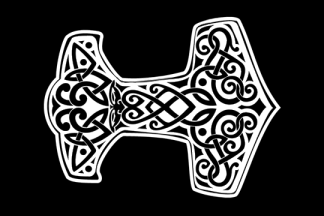
Mjölnir Flag
|
Hammer of Thor (USA)
Mjölnir
The symbol of Mjölnir appears on this black flag carried in 2017 by an alt-right protester in the violent "Unite the Right" Rally held in Charlottesville, Virginia. In Norse mythology, Mjölnir is the mythical Hammer of Thor, the Norse god of thunder.
Today, practitioners of Germanic neo-Pagan faiths wear Mjölnir pendants as a symbol of their faith and various renditions of Mjölnir are commonly used by these groups and individuals. Its use as a neo-Nazi symbol is widespread, and often quite misunderstood. |
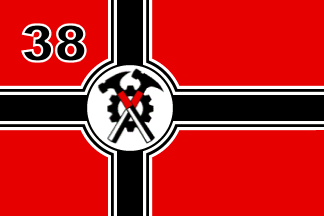
Hammerskin-Crew 38 Flag

Hammerskin Nation Flag
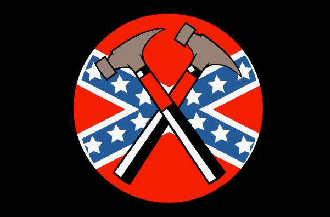
Confederate Hammerskin Flag
|
Hammerskin Nation (USA)
The Hammerskins, or Hammerskin Nation, are a white supremacist group formed in 1988 by Sean Tarrant in Dallas, Texas. Their primary focus seems to be the production and promotion of white power rock music, and many white power bands claim affiliation with them. The Hammerskins host several annual concerts, including the "Summer of Hate" concert and the "Hammerfest" in honor of deceased Hammerskin Joe Rowan, the lead singer of the band Nordic Thunder, which has become an annual event in both the United States and Europe.
The Anti-Defamation League describes them as the best-organized neo-Nazi skinhead group in the United States. They claim six chapters in the United States: The Northwestern Hammerskin Chapter (NWHS), Western Hammerskin Chapter (WHS), Confederate Hammerskins (CHS), Northern Hammerskin Chapter (NHS), Eastern Hammerskin Chapter (EHS), and the Midland Hammerskins (MHS). The ISVG (Institute for the Study of Violent Groups) says the movement is now international, with chapters existing in Australia, Canada, Czech Republic, France, Germany, Hungary, Italy, New Zealand, Portugal, Slovakia, Spain, Sweden, and Switzerland. According to them there are about 200 members with group affiliations with the Aryan Nations, Ku Klux Klan, National Alliance, Vinlanders, Volksfront, and White Aryan Resistance. The Hammerskins also have what they call supporter chapters, known as Crew 38, for non-members who support their activities.
The Hammerskins logo, "depicting two claw hammers crossed to resemble goose-stepping legs," is based on the 1982 film Pink Floyd The Wall. Their logos and motto "Hammerskins Forever, Forever Hammerskins" (HFFH) often appear on their buttons, T-Shirts, posters and tattoos. Crew 38 and Hammerskins members also frequently identify themselves with the slogan "838," meaning "hail the crossed hammers" (the acronym HCH translates into the eighth, third, and eighth letters of the alphabet).
The first Hammerskin flag shown here was used at the Summer of Hate concert, organized by the Western Hammerskins, the Southern California branch of The Hammerskin Nation. The second flag design has been also used as a badge and logo, and the Confederate Hammerskin flag has also reportedly been used as a square wall banner.
|
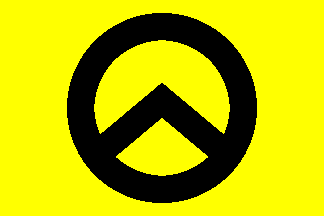
IG Flag (type #1)
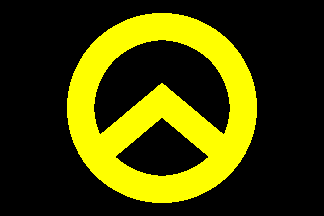
IG Flag (type #2)
|
Identity Generation Flag (Slovenia)
Geberacija identitete
Identity Generation is Slovenian far-right movement modelled after the Identitarian Bloc (Bloc Identitaire) of France. It has appeared in 2017 and is known to have operated through 2019, but seems to have ceased to exist by early 2020, its website being no longer online and Twitter account shut down (which actually might have happened while they were still active, if their activites were deemed unacceptable), while the VK account still exists, but has been long inactive.
Their political activities are typical for right-wing alt-right extremists in targeting socially progressive policies, the LGBT community, ethnic minorities from the Southern Balkans, and other European migrants. They have been responsible for multiple acts of violent extremism in Slovenia.
The flags, as used by the Identitarians in other countries, bear the
"Spartan lambda" symbol, black on yellow field, or with reversed colors. The Slovenian national flag is also used by the group, as well as the flag of Carniola, which differs from the former only in the coat-of-arms which it bears and its placement in center instead of canton. Local flags are also sometimes used, and even the flag of European Union, even though the Identitarians are generally hostile towards the EU, but since it has originally been introduced by the Council of Europe, perhaps they have seen it as the flag of Europe as the continent, rather than the European Union. |

IE Flag (white and Blue)
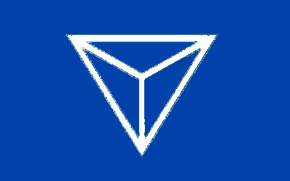
IE Flag (blue and white)
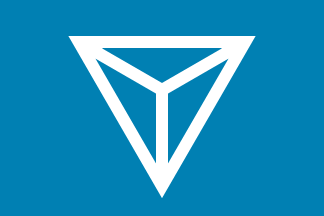
IE Flag (teal and white)
|
Identity Evropa (United States)
Identity Evropa is a white supremacist group founded by Nathan Damigo in 2016 and now headquartered in Oakdale, California. Damigo led the National Youth Front (the youth wing of the American Freedom Party) until it was disbanded. Although a relatively small group, IE has been identified as a racist white supremacist organization by the Anti-Defamation League and is designated by the Southern Poverty Law Center as a hate group. It focuses on recruiting disaffected college-aged, white students with what they call "race realism." They especially target college campuses by distributing white nationalist slogans on fliers, posters, and stickers, often describing themselves as a fraternity or social club.
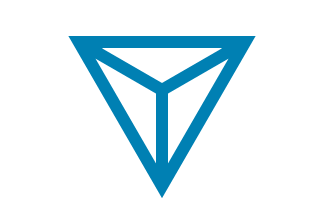 IE Flag (white and teal) Part of the broader white nationalist Alt-Right Movement, their flags were prominently displayed at the nationally televised Charlottesville Riots of 2017. The depicted symbol on their flags is called "Dragon's Eye" and may be depicted either in form of an equilateral triangle, or an isosceles triangle with width larger than height, as Rudolf Koch originally depicted it in "The Book of Signs." The photos of flying flags usually do not allow for clear recognition of the shape, but the movement is known to use both variants of the symbol. The symbol on flags looks a bit off-center, much closer to bottom than top edge of the flag, but it was done in order to make its geometric center as close to the flag center as possible. |
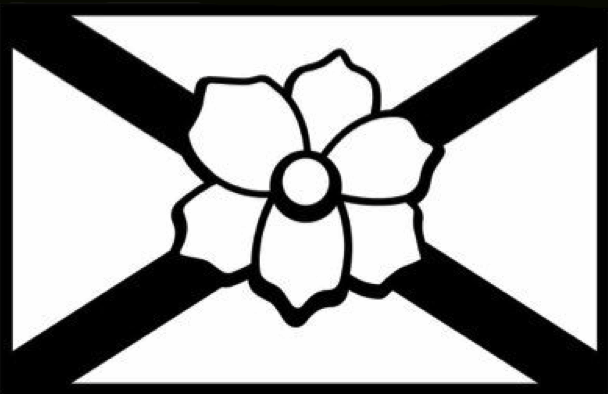
ID Flag
|
Identity Dixie (United States)
Using a variation of the neo-Confederate Southern Nationalist flag, featuring a magnolia flower, Identity Dixie althought having a similar name to Identity Evropa is actually an offshoot of "The Right Stuffs" and not associated with Identity Evropa despite being at Charlottesville and having similar names.
Although also a relatively small group, ID has been identified as a racist white supremacist organization by the Anti-Defamation League and is also designated by the Southern Poverty Law Center as a hate group.
|
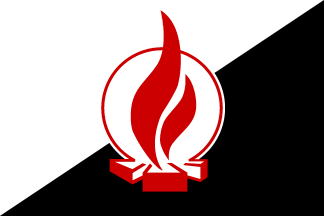
HDJ Flag

HDJ Pennant
|
German Youth Loyal to the Homeland (Germany)
Heimattreue Deutsche Jugend (HDJ)
The Heimattreue Deutsche Jugend (HDJ) is a neo-Nazi youth association offering Hitler youth-style camping holidays and other youth activities for children and young people that attempts to familiarize participants with Nazi thinking and teach children, as young as six, that foreigners and Jews are a threat to the nation, leading them into right-wing extremism.
The HDJ emerged from the "League of Youth Loyal to the Homeland - Free League" (Bund Heimattreuer Jugend - Freibund), an organization originating in late 1950s that was based on the traditions of early 20th-century German youth movements, and co-operated closely with the Viking Youth and other neo-Nazi organizations until the late 1980s when it began distancing from them, causing its most extreme members to break away in 1990 and found "The Youth Loyal to the Homeland" (Die Heimattreue Jugend), renamed the HDJ in 2000.
Involvement of Viking Youth members in their activities, as well as the members' participation in acts of violence, resulted first in a ban on wearing uniforms in 2007, which they declared they wouldn´t obey, and eventually by the complete banning of the group itself in 2009. The HDJ website claimed it fought "for an independent Germany, for traditional values and for a lifestyle reflected in a healthy body, spirit and character. It also [fought] the use of English in the German mother tongue." Its newspaper "Firebrand" (Funkenflug) had a subtitle "Young, Stormy, Loyal to the People."
Since it is illegal to display Nazi symbols in Germany, the HDJ´s flag features a stylized campfire, but maintains the traditional national socialist colors of red, black and white. On some reported variants of the flag a caption in a red ribbon is located below the campfire reading Heimattreue Deutsche Jugend (German Youth Loyal to the Homeland). |
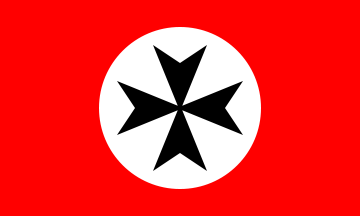
IE Flag
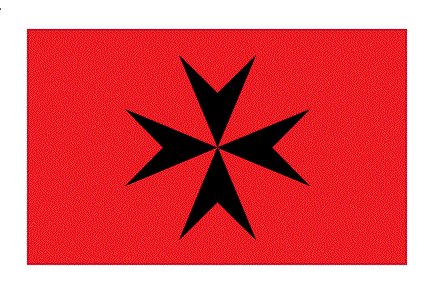
Maltese Civil Flag Variant
|
Empire Europe (Malta)
Imperium Europa (IE)
Empire Europe, more commonly called Imperium Europa, is a far-right Maltese political party, founded in 2000 by racist Norman Lowell. Its primary aim is to unite Europe into one political unit as a homeland for white people, organized similarly to the Holy Roman Empire, but ruled by "The Elite." Their goal is to see Europe "liberated from the enemy within and the enemy without." Lowell's beliefs were first published in an article, titled "Our Age", published in The Times of Malta in 1981. Their propaganda is written for those Lowell calls "Radical-Racialist-Right-Revolutionary-Reactionaries."
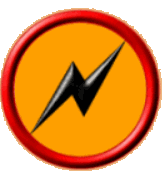 Although the IE uses a symbol of a gold lightning bolt superimposed on a orange red filibrated sun called "The Lightning and the Sun" as a logo, they use a Nazi-style flag, with a black Maltese cross replacing the swastika. The earliest appearances of these flags are in videos released by the party in 2012, so that year is probably when this flag was adopted. More recently, the Maltese Civil Ensign (a white Maltese Cross centered on a red field bordered with white) has been modified with a black cross replacing the white one, and has been reported in use at demonstrations. Although the IE uses a symbol of a gold lightning bolt superimposed on a orange red filibrated sun called "The Lightning and the Sun" as a logo, they use a Nazi-style flag, with a black Maltese cross replacing the swastika. The earliest appearances of these flags are in videos released by the party in 2012, so that year is probably when this flag was adopted. More recently, the Maltese Civil Ensign (a white Maltese Cross centered on a red field bordered with white) has been modified with a black cross replacing the white one, and has been reported in use at demonstrations. |
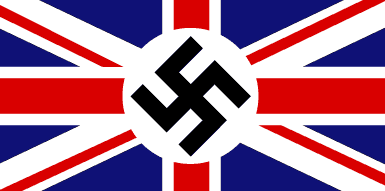
IFL Flag
|
Imperial Fascist League (United Kingdom)
This was the flag of the Imperial Fascist League (IFL) a British Fascist movement led by Arnold Spencer Leese between 1928 until 1939. The IFL was a small group with never more than a few hundred members. They wore black shirts and were organized for street battles. Initially, they used the fasces as a symbol, but adopted the swastika superimposed on the Union Flag after Adolf Hitler came to power in Germany.
The group was in harsh competition with the British Union of Fascists, and more than once there were street battles between the two extremist groups. Eventually, the BUF proved too strong, and by 1939, the IFL had largely disappeared. Their flag regained brief notoriety when a picture of it being used in a 1938 pro-nazi demonstration in London was re-published in a 1997 edition of Newsweek magazine. The IFL flag variant, modified with text, was adopted by the new National Socialist Movement - Britanna (NSM). |

INP Flag (Type #1)
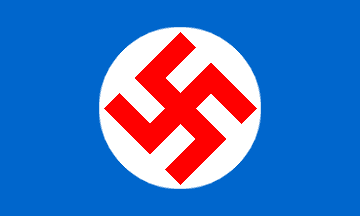
INP Flag (Type #2)
|
Nationalist Party (Iceland)
Flokkur Þjóðernissinna
Nationalist Party was founded in 1934 by fusion of the Icelandic Nationalist Movement (Þjóðhreyfing Íslendinga), founded in 1933, and their breakaway members - the original Nationalist Party. The party believed in Aryan supremacy and anti-Semitism, and intended to make Iceland a Corporativist state, but never developed a personality cult of a supreme leader. The membership never exceeded 450. The British invasion of Iceland in World War II in 1940 caused a mass exit from the party which was officially disbanded in 1944. In Iceland today, membership in the Nationalist Party is a matter of embarrassment and very few objects, including the party flags, have been saved, except perhaps by a small number of collectors who are interested in this period of Icelandic history.
The Nationalist Party used two different flags in national colors. The first flag added the swastika to the 19th Century proposal from which the national flag was derived. The swastika was placed on a white diamond, conjoined with the cross into a single charge. The second flag had a typical Nazi design, with red swastika on a white disk in center of blue field.
|
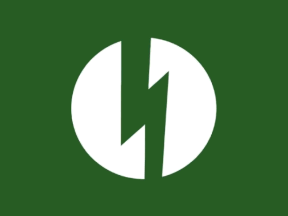
IPGB Flag)
|
Integralist Party of Great Britain and Northern Ireland (United Kingdom)
The Integralist Party of Great Britain and Northern Ireland, founded by Robert Stead and Benjamin Noyles, is a small political movement in Great Britain that seems to be a strange combination of neo-Fascistism, localism, traditionalism, trade unionism, corporatism, and environmentalism. It combines elements of both the political left and right, but claims not to be racist, although they do oppose mass immigration and what they call the EU "straightjacket." They see the nation as an organic unity, and feel that there has been a social, political, and economic decline suffered in Great Britain that must be corrected.
Their flag has a green lightning-bolt or thunderbolt on a white circle, called "the lightning in the sun," placed on a plain green field. The Integralist claims their symbol is a modern adaptation of the British Union of Fascist's "action within unity" symbol, and although clearly derived from the BUF flag, the flag´s designer, Benjamin Noyles, once claimed the symbol isn't neo-Fascist in nature. |
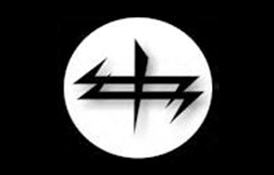
IAMF Flag
|
Iranian Aryan National Front (Iran)
Jebhe Nasionalisti-ye Iranian-e Arya
The Jebhe Nasionalisti-ye Iranian-e Arya (IAMF) is an ultra-nationalistic organization with Iranian national ideals as its prerogative. They emphasize Aryan Values and are definitely in support of the concept of Aryan Racial superiority.
Although the Iranian Aryan National Front is a new organization, they do supports a website with their views, agenda, and articles in a semi-organized format. |

IBDA-C Flag
|
Great Eastern Islamic Raiders' Front (Turkey)
Islami Büyükdogu Akincilar Cephesi
The Great Eastern Islamic Raiders' Front is an Islamic militant hate group that follows the teachings of Necip Fazil Kisakürek and his racial hate philosophy of Büyük Dogu (Great East). The group's goal is to create a new Sunni Caliphate in the Middle East. They claim credit for attacks on Shia, Alevi, Christian, and Jewish diplomatic, business, and religious interests in Istanbul. The group has defiantly moved from rhetoric to violence and is credited with a series of 90 bombings and attacks in the 1990s.
The flag of IBDA-C is blue with three white crescents arranged in a triangular pattern at hoist. The inner crescent is accompanied by a white 5-pointed star. |
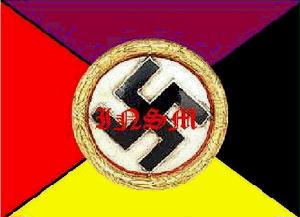
INSM Flag
|
Iranian National Socialist Movement (Iran)
Jonbesh-e Nasional Sosialist-e Iran
The Jonbesh-e Nasional Sosialist-e Iran (INSM) is the latest addition to the Internet-based National Socialist organizations of Iran. Although the organization is Iranian, strangely enough they use the English script letters "INSM" centered on their flag standing for "Iranian National Socialist Movement."
The background colors on the flag (red-brown-black gold clockwise) are the colors used on the Derafsh-e-Kaviani, the oldest Persian flag dating back to the Persian empire. According to legend, it had be made of a long rectangular leather apron used by national hero Kaveh the iron smith during the reign of King Fereidoun, and mounted on a spear. This leather banner became the symbol of Iranian independence, resistance, resilience and the revolutionary momentum of the masses revolt against evil invaders. Today it is known as the"Glorious Flag" of Iran. |

INBP Flag (Type #1)
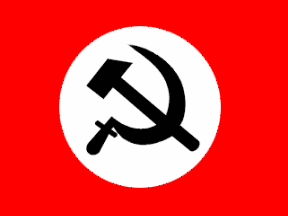
INBP Flag (Type #2)
|
Israeli National Bolshevik Party (Israel)
also National Bolsheviks of Israel
The Israeli National Bolshevik Party is a strange contradictory one. National
Bolsheviks in other countries generally have an anti-Zionist and pro-Palestinian attitude, but their Israeli counterparts are openly Zionist and frequently co-operate with other extreme Zionist groups. They also claim the heritage of Poalei Zion and other Jewish leftist organizations from the Russian
Empire (most of their members are immigrants from ex-USSR countries). They also frequently express
the solidarity with the "repressed" Russian NazBols, but generally seem not to be very close with most
of their European counterparts, who, as mentioned, are generally very anti-Zionist and pro-Palestinian.
According to the INBP itself: "Israel was invented and founded by Red Zionists geopolitically as part of Eurasia, from the beginning oriented towards the Eurasian continent and developed as a Red proletarian communal republic. We, the National Bolsheviks of Israel, see our global mission in the resurrection and reworking of the idea of very great social justice for the Workers of Zion in the context of an interconnection with Russian National Bolshevism and the construction of a single imperial state free from the tyranny of globalism."
Along with their Type#1 flag, the party sometimes also uses the "generic" National Bolshevik flag (Type #2) with the hammer and sickle on a white disc. However, it seems to be done quite rarely, mostly because the Nazi-looking design of the flag, which must be quite unpopular in Israel. |
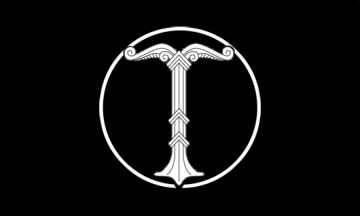
French Nationalist Party
Roussillon Branch
|
The Irminsul Symbol
Irminsul (mighty pillar) is a Germanic neo-pagan symbol frequently
used by the neo-Nazis. The name originated in old Saxony for a wooden pillar or tree trunk used as a place of worship. Little is known about their exact appearance, but the modern symbol is generally based on a 12th Century relief carved at the Externsteine Rock Formation near Detmold, Germany. The symbol, which vaguely resembles a palm tree, was first described as an "irminsul" in 1929 by archaeologist Wilhelm Teudt. He believed that the Externsteine site was a place of worship to commemorate the victory of Christianity over paganism. While no evidence exists to support his hypothesis, it caught on among the neo-Nazis.
This flag used by the French Nationalist Party in Roussillon, France, provides an example of the use of the irminsul by extremist. Their flag depicts a white irminsul symbol within a white ring, placed on a black field. |
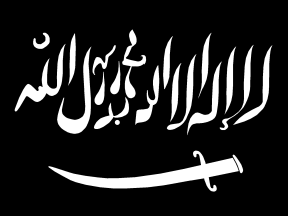
JAU Flag
|
Army of the Nation (Palestine)
Jaysh al Ummah
The Army of the Nation is a small terrorist group based in the southern Gaza town of Khan Yunis and led by a man known only as Abu Hafss. The armed members of this group wear black robes over black pants with red or black "death squad" headbands. The group considers themselves "brothers" of the al-Qaida terror network and threaten not only to operate in the Giza-Tel Aviv area, but "God willing" to take the fight to Washington. Hamas has supported and allowed such extremist groups as the JUA to train openly in Palestine.
Abu Hafss's group has claimed responsibility for several recent mortar
and rocket attacks on Israeli border communities, and is one of several small al-Qaida-inspired groups, such as the Army of the Nation and the Army of Islam, that have emerged in Gaza in recent years as the area goes deeper into poverty, which, of course, creates fertile ground for such militant groups. |
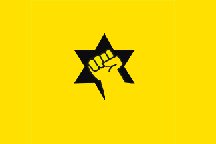
Kahane Chai Flag
There several variants of this flag with various customized inscriptions in use.
|
The "Thus Kahane Lives" Movement (Israel)
Kach Kahane Chai
The Kach Movement began as a far right political party in Israel, founded by Rabbi Meir Kahane in the early 1970s. It was barred from participating in elections after 1988 under Israeli elections laws that banned parties that incited racism. In 1990, Kahane was assassinated after making a speech in New York City.
After Kahane's assassination the party split with the Kahane Chai breaking away from the main Kach faction. Both the Kach and Kahane Chai Movements were banned outright in 1994, and today, both groups are considered terrorist organizations by Israel, Canada, the European Union, and the United States.
The group has been responsible for using explosives that has done damage to property, including an attempt to car bomb a Palestinian girls school in East Jerusalem, threatening and conspiring to carry out assassinations, and for soliciting funds and members for terrorist organizations. Splinter groups of the Kach now include the Kahane Chai Organization in the USA and the Ligue de Défense Juive in France. |
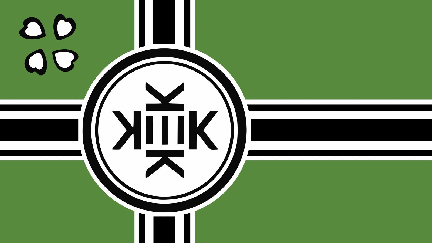
Kekistan Flag (Fictitious)
|
National Flag of Kekistan
The fictitious nation of "Kekistan" even has a fictitious flag. It mimics the German Nazi War Flag, with the Kek logo replacing the swastika and the green replacing the German red. It also has a 4chan logo is emblazoned in the upper left-hand corner. Alt-righters have become particularly fond of this fictitious flag because of the way its use bothers those able to recognize its Nazi-like design.
Since this flag is widely used among unaffiliated individuals and other American white supemacists it should not be affiliated any particular group. |
Knight's Party Flags
 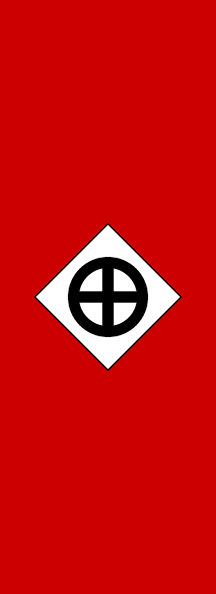
(Variants for wall hanging)
|
Knights' Party (USA)
The Knight's Party is now a registered political party whose purpose is to provide an avenue for the members of the Ku Klux Klan (see below) to run as political candidates in elections. They host a new look for their website and now claim to be "peacefully" seeking to abolish all discriminatory affirmative action programs. They wish to become known as the "White Rights Movement" and consider themselves as "the Last Hope for America." They are still in the same old business, but trying for a newer more "politically correct" look.
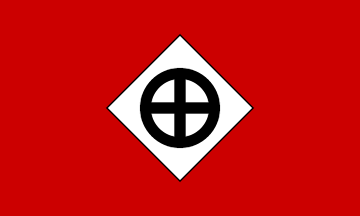 |
|
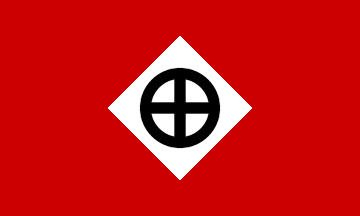 |
| Knight's Party Flag with border |
|
Knight's Party Flag without border |
This new flag is clearly inspired by the traditional National Socialists design, but instead of white disc with a black swastika, it has a white diamond enclosing a black Sun Wheel. Flag variants include diamonds with black borders or without borders. |
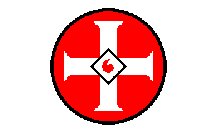
The Blood Drop Flag
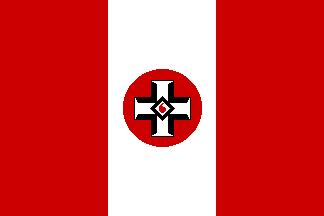
The Duke Flag
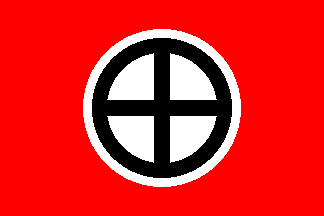
The Sun Wheel Flag
|
Knights of the Ku Klux Klan (USA)
The Blood Drop symbol is most often used by various Klan organizations throughout the United States. Usually at clan rallies there are actually a lot more United States Flags displayed than KKK flags, despite their very un-American racial beliefs.
The Ku Klux Klan was established in Tennessee in 1866. Most of the leaders were former members of the Confederate Army and the first Grand Wizard was Nathan Forrest, a confederate general during the American Civil War. In the late 1800s and early 1900s Clansmen wearing masks, white cardboard hats and draped in white sheets, have been responsible for torturing and killing black Americans and sympathetic whites. The Civil Rights movement of the 1960s prompted a modern rebirth of the Ku Klux Klan activities that has persisted until the present day.
 |
|
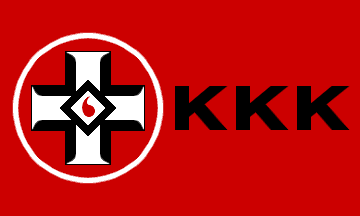 |
|
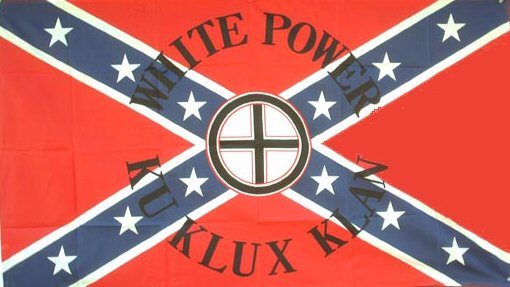 |
| KKK - White Power |
|
Blood Drop Variant |
|
KKK-White Power-CSA |
The variant KKK flag (red-white-red background with the center Blood Drop symbol) is commonly called the "Duke Flag" named for neo-Nazi, turned clan leader, David Duke. David Duke was also shown in KKK broadcast with a red flag (complete with centered white disk and black Sun Wheel) hanging on a wall behind him, apparently a holdover from his neo-Nazi days.
In addition to the American and Confederate flags, there is a KKK "White Power" flag with fist emblem centered on a black field, that occasionally appears at Clan rallies. A new, but undocumented flag is a KKK/White Power/CSA Flag currently being sold. |
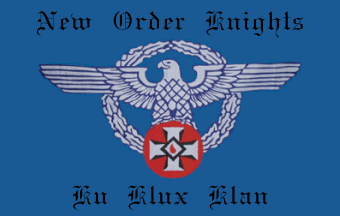
NOKKKK Flag
|
New Order Knights of the Ku Klux Klan (USA)
Another small splinter group (or individual) claiming to be part of the KKK are calling themselves the New Order Knights of the Ku Klux Klan. Proclaiming themselves the "Blue Tunic Army," they claim that their mission is to preserve the white heritage, so future generations will know and learn from their history." They proclaim a strange combination of anti-semitism, national socialism, and Christianity claiming that National-Socialism is the way of the Aryan warrior, yet say their "dedication is to educate, not in hatred, but with pride for the race that (they) are a part of." Not much is really known about this group.
Their flag has a silver eagle and wreath reminiscent of those used by the Third Reich centered on a light blue field, holding a KKK Blood Drop symbol where one would expect the swastika to appear. The words "New Order Knights" in a black script are written above the badge, with the words "Ku Klux Klan" appearing below. |
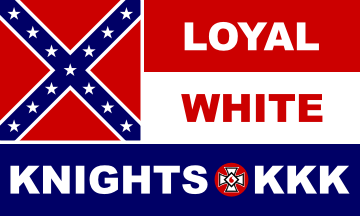
LWK-KKK Flag 2012
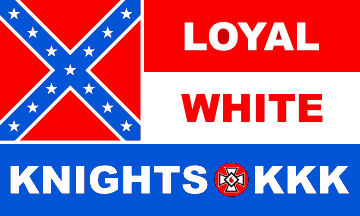
LWK-KKK Flag 2017
|
Loyal White Knights of the Ku Klux Klan 2012 (USA)
Another off shoot of the Clan is the Loyal White Knights of the Ku Klux Klan, basically another white supremacist and antisemitic neo-KKK group founded in 2012. The Loyal White Knights of the Ku Klux Klan aims to "restore America to a White, Christian nation founded on God's word."
As can be seen, the design of their 2012 flag resembles that of the Mississippi state flag, but with red at the top and blue at the bottom. The Blood Drop emblem also differs from the one typically used on the other KKK flags. The cross of the blood drop is more similar to that of the Iron Cross, but with the colors reversed.
The Loyal White Knights, as part of the broader white nationalist Alt-Right Movement, made it presence felt at the violent Charlottesville Riots of August 2017 flaunting a slightly different flag variant. Very similar to the original White Knight Flag of 2012, the new flag featured a lighter blue and red on the design than either the Confederate Battle Flag, the Mississippi State Flag, or that of the first National Stars and Bars of the Confederate States of America.
|
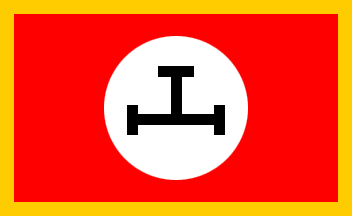
KKK-LLC Flag
|
The Ku Klux Klan, LLC 2003 (USA)
Headquartered in Compton, Arkansas, the Ku Klux Klan Limited Liability Company (KKK LLC), is yet another attempt to legitimize the KKK. A limited liability company (LLC) is a legal form of corporation that provides limited liability to its owners. Chartered in the State of Arkansas, and working under a legal business structure, this branch of the KKK claims its actions are all completely legal and aboveboard. They pay taxes, keep legitimate financial records of all their activities, and claim to act only as a resource for Klan philosophy and its meaning.
The emblem in the center of their flag is the "Triple Tau." They claim it is a symbol of Christianity dating back to the time of Christ. According to the Klan the cross symbol (a H bisected by a T) represents the Cross, God and Christ. A variant of this flag does not have the gold border surrounding the red field. |

Libertarian Green Party
|
Libertarian National Socialist Green Party (USA)
The Libertarian National Socialist Green Party (LNSGP), is an American organization that cites the National Socialist German Workers Party as its primary ideological inspiration, while also incorporating elements of Libertarianism and the Green movement.
It has not been established whether LNSGP has any activity or existence other than through its website. It doesn't appear to have any active membership.
|

LANC Flag (1923-c.1927)
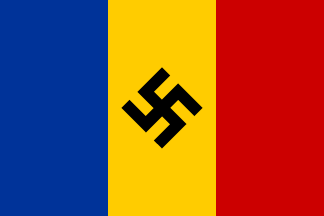
LANC Flag (c.1927-1935)
|
National Christian Defense League 1923-1935 (Romania)
Liga Apararii National Crestine - LANC
National Christian Defense League was founded in 1923, by transformation of the National Christian Union (Uniunea National Crestina), which was founded previous year. Founder and leader of both parties was Alexandru C. Cuza, a politician already known after his extreme anti-Semitism, in service of which he was using even the proposals that would otherwise sound progressive for those times, like universal male suffrage and land reform. Second position in the new party was held by Corneliu Zelea Codreanu, whose political mentor Cuza was during previous years. The flag of National Christian Defense League was black with a white disc charged with a black swastika, all within a border in national colors. According to Codreanu, black field was the symbol of mourning, white disc symbolized the "hopes surrounded by the darkness they will have to conquer", while the swastika was adopted as the worldwide symbol of anti-Semitism. The last statement suggests that the symbol was actually borrowed from the Nazis of Germany, although Cuza later claimed that it was used in Romania since 1910, when he took part in founding of the Democratic Nationalist Party (Partidul Nationalist Democrat), from which he later broke away to found the National Christian Union, the party whose use of the swastika is indeed verified.
Although the National Christian Defense League drew inspiration from Italian Fascism and German Nazism, it was not as militant as these movements and Cuza was constantly refusing Codreanu's proposals to turn the party into a militia. This eventually caused a split in 1927, when Codreanu broke away to found the Iron Guard. New movement quickly took many supporters from the National Christian Defense League, which managed to survive, although somewhat weakened, until 1935, when it merged with the National Agrarian Party (Partidul National Agrar) to form the National Christian Party (Partidul National Crestin). Some time after the split, the National Christian Defense League adopted a new flag, Romanian tricolor with a black swastika in the center, which it transferred to its successor in 1935. |
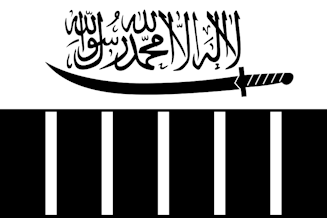
LeT Flag
|
Army of the Good (Pakistan)
Lashkar-e-Taiba (LeT)
The Lashkar-e-Taiba, or Army of the Good (Righteous, Pure, etc.), is one of the largest and most active terrorist organizations in South Asia, operating mainly from Pakistan. It was founded in 1987 in Afghanistan, with funding from Osama Bin Laden. Its headquarters is in Muridke (Punjab province of Pakistan), but the group operates several training camps in Kashmir.
The LeT has been banned as a terrorist organization by India, the United States, the United Kingdom, the European Union, Russia, and Australia. Although it's political arm, Jamat ud Dawah (JUD), has also been banned since 2015, the Pakistani government seems to still allow it to work openly as a "charitable" organization. |
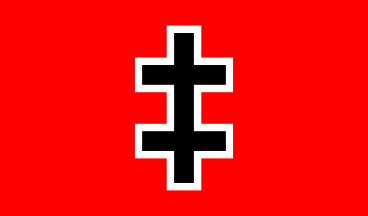
LITAS Flag
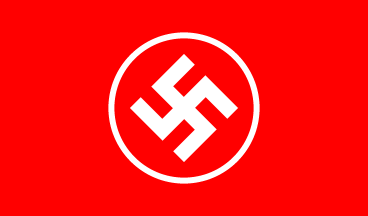
LNSVS Flag
(unverified)
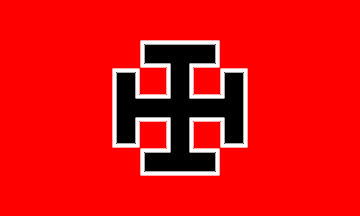
VLNDS "National" Flag

VLNDS "Party" Flag
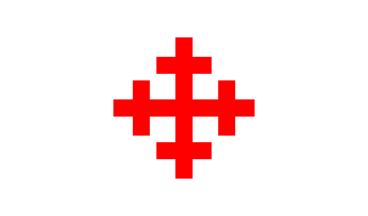
LTDS Flag
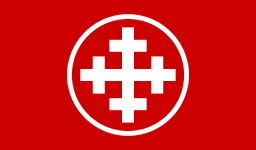
LNSP Flag
|
Lithuanian National Union (Lithuania)
Lietuviu` Tautos Sa`junga - LITAS
The Lithuanian National Union, founded 2011, is the most current neo-Nazi party in Lithuania. It is the successor of a host of previous neo-Nazi organizations. To name a few:
- Lithuanian Union of National Socialist Unity (LNSVS) - Lietuviu` Nacionalsocialine's Vienybe's Sa`junga (1996-1999)
- Lithuanian National Democratic Party (LNDP) - Lietuvos Nacionaldemokratu` Partija (founded independently 1999-2009)
- Lithuanian National Labour Union (LTDS) - Lietuviu` Tautinio Darbo Sa`junga (1999-2000)
- Lithuanian National Socialist Party (LNSP) Lietuviu` Nacionalsocialine' Partija (2000-2001)
- Unified Lithuanian National Workers Movement (VLNDS) - Vieningasis Lietuviu` Nacionaldarbininku` Sa`ju^dis (2007-2011)
All of these organizations, except the LNDP, were founded and led by the same man, Lithuanian neo-Nazi activist Mindaugas Murza (also known as Mindaugas Gervaldas). Each of these Lithuanian National Socialist Parties used a range of flags, many of which are derived from those of their predecessors.
Regardless of their varying names and flags, members of all these groups attacked Lithuania's minorities of Jews, Poles and Russians, and demanded that these minorities be made to leave Lithuania. They also advocated restrictions on immigration and on the import of foreign goods and expressed doubts about whether Lithuania should seek EU membership. Mindaugas Murza compared globalism to Zionism, and preaches hatred of the Jews (anti-Semitism) and other Nazi policies, including paraphrasing the German National Socialist slogan with "Lithuania, wake up!" Murza was imprisoned for his activities, but his followers still occasionally cause trouble.
|
|
|
LNDP Flag
(also briefly used by VLNDS) |
|
LNSVS Flag
(used by LNDP and VLNDS as a "heritage" flag) |
The VLNDS flag most frequently used was originally described as the "National" flag. The party described the cross as the combination of two swastikas, one right-facing and one left-facing. The flag they called the "Honor" flag has never appeared in any public demonstrations and was perhaps only used during private meetings, if any copies were made at all, for its design was never made known to the public. The VLNDS "Party" flag ("Organizational" flag, as it was called by them) was shown at the party website, but its actual use was not verifed so far. It is derived from the flag used by the LNDP in 2001-2007 (while Murza and his followers were its members) and also by the VLNDS in early 2007, but the white disc and black cross of the original design were reduced in size and superimposed over a "Black Sun," a well-known Nazi symbol, depicted here in gold color. To denote its ideological heritage, the VLNDS also sometimes used the flags of the Lithuanian Union of National Socialist Unity and the Lithuanian National Socialist Party.
The flag of the Lithuanian Union of National Socialist Unity (LNSVS) which featured a white swastika on a white outlined red disc placed on a red field, was most likely the flag of some earlier neo-Nazi group, because it does seem to be more traditional, and there have been many similar organizations previously in Lithuania. Their verified flag was similar to that of the LNDP, but was charged with a cross crosslet instead of the cross potent. The Lithuanian National Labour Union (LTDS), founded by a re-organization of the Lithuanian Union of National Socialist Unity (LNSVS), but replaced almost imediately the next year, used a flag that had a red cross crosslet on white field which differed from most used among the neo-Nazi groups in Lithuania that all favored red fields. Its replacement, the Lithuanian National Socialist Party (LNSP), used a red flag charged with a white cross crosslet on a white outlined red disc; the dark shade of red was also sometimes attributed to other flags used, but was verified only for this one. |
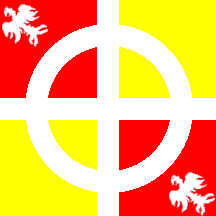
LN/PNF-L Flag
|
Nationalist Lorraine (France)
Lorraine Nationaliste
Nationalist Lorraine was established in French region of Lorraine in December 2012 as the local branch of the French Work. After the latter was dissolved in 2013, the Nationalist Lorraine kept operating and eventually joined the newly formed French Nationalist Party (PNF) in 2015, as the PNF Lorraine.
The flag of Nationalist Lorraine / PNF Lorraine is derived from that of the French Work, by replacing original blue and red colors with red and yellow, respectively, and addition of a white alerion in each red quarter. An alerion is a heraldic charge which looks like a small and simplified image of an eagle and appears in the traditional heraldic banner of Lorraine, from which the arrangement of colors is also borrowed. The use of flags and arms of traditional provinces is widely spread among French ultra-rightists, many of whom wish to re-establish the traditional administrative division of the country. |
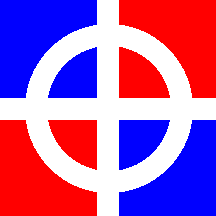
LOEF Party Standard
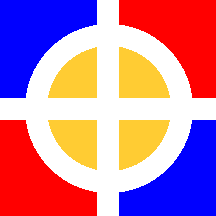
LOEF Party Standard
(2008 variant)
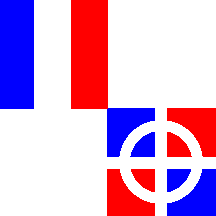
LOEF Secretariat flag
|
The French Work (France)
L'Œuvre française
The French Work is a French ultranationalist movement, founded in 1968 by Pierre Sidos. Sidos has a long history of founding, providing leadership, and memberships in a variety of different extremist groups such as Young Nation, the Nationalist Party, 13 May People's Movement, Organization of the Secrete Army, to name just a few. Most of these organizations were banned by the French government for being either anti-semitic, neo-Nazi, racist, or prone to violence. Somehow, the French Work has remained marginally legal in the French political picture. The L'Œuvre française main goal seems to be replacing the French Republic with a new monarchy whose goal would be to return France to its "historic role and civilizing mission."
On the L'Œuvre française website there is much discussion on the origins and meaning of the "Celtic Cross" and its meaning and use as the party standard, explaining that they "rightfully consider the Celtic Cross as their oldest national emblem, without fearing any kind of comparison," one would guess, to the swastika used by the German Third Reich and the Celtic Crosses used by many other neo-Nazi nationalist groups. Another symbol of the movement was the "Triple Ensign" - three plain square flags flown together, each in one of the national colors.
The Four-Quartered flag was reported to have been used as the emblem of the LOEF Secretariat during the Nationalist Congress (Congrés nationaliste), a gathering of various French ultra-rightist organizations which took place in year 2008. A variant of the party standard, with blue and red areas within the Celtic cross changed into gold, was used at the same event.
The French Work was banned in July 2013, along with several other ultra-rightist groups, after the street fighting which took place in Paris previous month resulted in death of one anti-Fascist. It had already been pushed aside in 2011, when Marine Le Pen became President of the National Front and decided to distance the party from more extremist groups, expelling the leaders of French Work and others with "double membership". After the dissolution, former members of the French Work have founded a number of new organizations, sometimes using its flag as the model for their new ones. |

LOEF Caryatids Flag |
The Caryatids (France)
Les Caryatides
The Caryatids was the women's wing of The French Work (LOEF), the ultranationalist movement founded in 1968 and banned in 2013. Not dissolved, The Caryatids kept operating and eventually joined the newly formed French Nationalist Party in 2015, to continue as its women's wing.
The flag of The Caryatids is blue with a white Celtic cross, superimposed with a yellow cross flory, i.e. whose arms end with fleurs-de-lis. An orchid flower in proper colors is placed over all in center. The flag design is derived from that of the French Work.
|
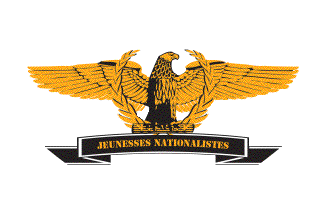
LOEF-JN Flag |
Nationalist Youth (France)
Jeunesses Nationalistes
The Nationalist Youth (JN) was established, as the youth branch of French Work (LOEF), in October 2011 during the 14th Forum of the Nation, organized in Lyon. Its activism, often leading to violence, eventually made it one of the organizations, together with the French Work, which were banned in July 2013.
The flag of the Nationalist Youth is white with the movement emblem: an eagle of Fascist inspiration, holding a fasces in its claws and surrounded by a wreath of laurel, all in gold color and set atop a black scroll bearing the movement name in golden letters. The laurel branches are, most probably, modelled on of the Fred Perry sportswear brand logo. Fred Perry shirts are equally prized by the skinheads and the antifas, as well as various other youth groups; the riot that eventually lead to dissolution of the French Work and Nationalist Youth
had actually started when the two rival groups unexpectedly met at a Fred Perry private sale.
|

Speculative Flag of the LRA
(possible reported color pattern)
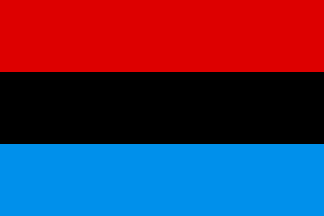
Speculative Flag of the LRA
(reported, but questioned)
|
Lord's Resistance Army (Uganda)
The Lord's Resistance Army (Lord's Resistance Movement), led by Joseph Kony, who proclaims himself the spokes person of God and the Holy Spirit, is a militant terrorist group which was started in 1987 in the Acholi region of Northern Uganda. The LRA operates in northern Uganda, South Sudan, the Democratic Republic of Congo and the Central African Republic. The LRA has been blamed for widespread human rights violations, including reported murder, abduction, mutilation, cannibalism, sexual enslavement, and seizing child conscripts to participate their terrorists activities. The LRA forces are now shrunken in size and on the defensive, with Ugandan Defense Forces, aided by American Special Forces commando trainers, determined to put an end to their violent activities. The remaining LRA forces appear to be now mostly active in the Orientale province of the Democratic Republic of the Congo, where the DRC provides a safe zone and refuses to allow Ugandan troops to enter in pursuit of the LRA.
The illustrated red-black-blue striped flag, although commonly presented as the LRA flag, might, according to Vexillologist Jaume Ollé, be a variant of a South Sudanese Liberation Movement flag photographed with South Sudanese guerrilla fighters operating within North Uganda and mistaken for the LRA. The colors are, however, the same as those used by the Uganda People's Congress Party, but with the top red-black stripes reversed. Many Ugandans still associate the UPC party with the military excesses of the past and especially the rule of the Military Junta of the early 1980s and the resulting civil war.
According to Ollé, the Lord's Resistance Army flag is a bicolored striped flag (either red-yellow or yellow-red) of two horizontal stripes (these colors are also present on the LRA uniforms). He adds that the flag is defaced with an emblem showing a half moon, a star, law tables, and a heart in the design. Unfortunately neither his red-yellow flag, or the commonly accepted red-black-blue flag, have been reliably documented, and since contact with the LRA is difficult, exactly which flag they are using, if any, remains a mystery. |
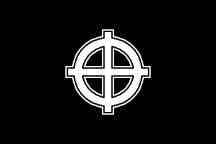
MAN Flag
(Variant)
|
National Action Movement (Portugal)
Movimento de Acção Nacional
The Movimento de Acção Nacional (MAN) was a "classical" European-type neo-Nazi style movement, which operated from 1986 to 1992. They used a white lined Celtic Cross (Sun Wheel) on black flag. Technically, this was not a party, but a neo-fascist movement connected with groups of "skinheads" and football supporters.
After the murder of a black man in Lisbon by these skinheads, they where outlawed by court order because the Portuguese constitution prohibits organized movements that promote fascist ideology.
|
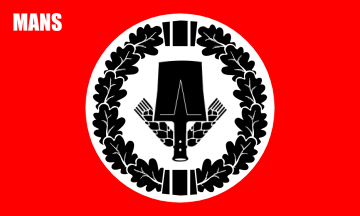
MANS Flag
|
Movement of National Socialist Action of Chile
Movimiento de Acción Nacional Socialista de Chile (MANS)
Founded in 1996 as the Horst Wessel Standard (Standarte Horst Wessel), this group adopted its present name in 2000. It claims the succession to the National Socialist Movement of Chile and the National Socialist Workers Party of Chile. Its flag is red, with a large white disc in center, charged with an oak wreath surrounding a spade between two wheat-ears, all in black; the charges in center are borrowed from the flag used by the National Labour Service of the Third Reich, but are differently shaped. Abbreviation MANS is inscribed in white in canton.
|
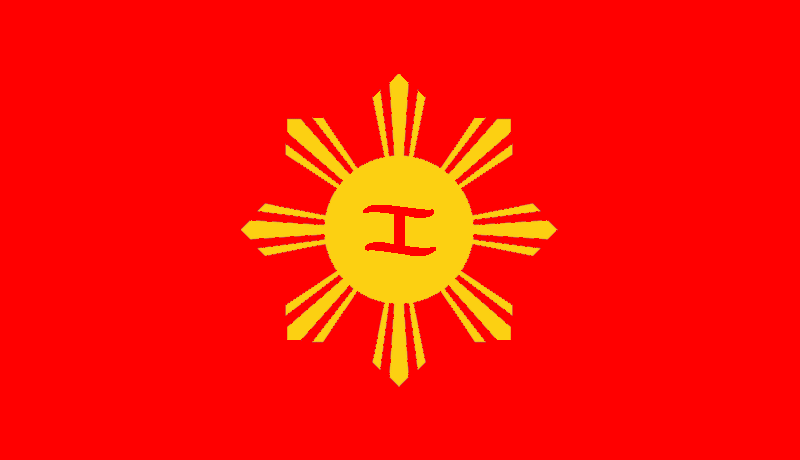
PNSF Flag
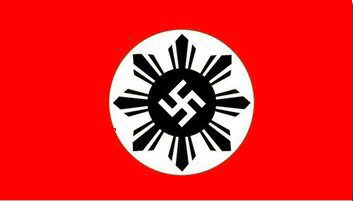
NDNMP Flag

PDF Flag
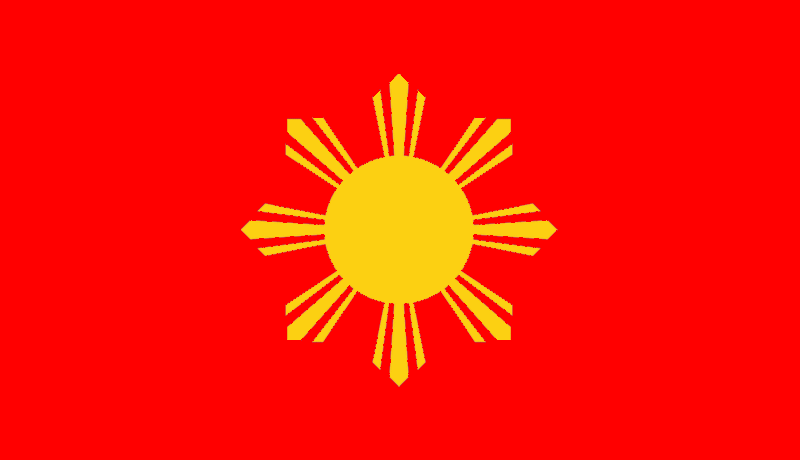
PFNF Flag
|
National Socialist Party of the Philippines 1930 (Philippines)
Partido Nacional Socialismo de Filipinas (PNSF)
Nationalist Democratic Maharlikan Party 2009
Partido democrático nacionalista de Maharlikan (NDNMP)
Right-wing Party of the Philippines 2010
Partido Derechista de Filipinas (PDF)
National Fascist Party of the Philippines 2012
Partido Fascista Nacional de Filipinas (PFNF)
 NDNMP Logo/Emblem There are a number of neo-Nazi and neo-Fascist web-based organizations, all hosted on FaceBook, that seem to all be the work of a small group of persons or person. According to these closely affiliated and similar websites, they all support goals of "anti-communism, militarism, the abolition of democracy and its ideals, the abolition of the old system of corruption, a strong ultra-nationalistic fervor, glorification of the past, statism, and glorification of the nation." The term "maharlika" refers to a feudal peasant warrior class that once existed in the Philippines, but in modern Filipino the term has come to mean "royal nobility." and has been adopted by these Filipino extremist. The word maharlika was used during the Kilusang Bagong Lipunan (New Society Movement) of Philippine President Ferdinand Marcos to describe Filipino nationalism, incorrectly indicating that it referred to the ancient Filipino kings and princes.
On their flags they claim that "red symbolizes the blood of the Filipino race, the blood which the fathers of our nation shed to attain freedom; the sun represents the eternal sunshine of the Philippines and its people which will last thousands of years; the eight rays of the sun represent our aims...and the eagle represents the might of the Philippines and its people." |
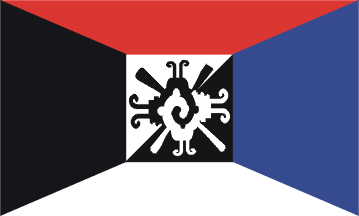
Mexica Movement Flag
|
Indigenous Movement of the People of Anahuac Flag (Mexico)
As the self-proclaimed "revolutionary voice" of the indigenous people of Mexican descent, the Mexica Movement wants to unite North and Central America into the "Nation of Anahuac" whose rightful inhabitants are indigenous Native Americans. They advocate that all white Americans should return to their true homes in Europe, and leave the Americas to its original people. They view Latin Americans of Amerindian descent, Native Americans, and the Canadian First Nations as one people who are falsely divided by European-imposed borders.
The black-and-white design in the center of their flag represents the Mayan depiction of duality (life and death, male and female, matter and spirit, etc.). The four colors of the flag represent both the four directions, and the two solstices and two equinoxes of the solar year, which all play an important part in all indigenous believes and religions. |

MNS Flag
|
Hungarian Welfare Association (Hungary)
Magyar Népjóléti Szövetség
The Magyar Népjóléti Szövetség (MNS) is a neo-fascist movement. It is small, but they are visible at public demonstrations on national days or anniversaries linked to World War II. The Hungarian Welfare Association, which has appeared under various names and in different guises, adheres openly to the legacy of the Hungarian fascist Arrow Cross, or Cross Star movement, led during the World War II by Ferenc Szalasi.
Various small groups, such as "Blood & Honour," are still active in organizing demonstrations on anniversaries linked to World War II and the legacy of Hungarian fascism. |

MNSC Flag 1932
|
National Socialist Movement of Chile
Movimiento Nacional Socialista de Chile (MNSC)
The Movimiento Nacional Socialista de Chile (MNSC) was formed in 1932 by General Diaz Valderrama, Carlos Keller, and Jorge González von Marées, who became leader. Initially supporting the ideas of Adolf Hitler, the party received financial support from the German population of Chile and claimed a membership of 20,000 people. The movement stressed what it saw as the need for one party rule and solidarity between classes, and soon set up its own paramilitary wing, the Tropas Nacistas de Asalto. However, support for Hitler was abandoned in the late 1930s and anti-Semitism was scaled back, with a more domestic form of Fascism being offered publicly. The movement was active until 1938, when it merged into the Popular Liberating Alliance (Alianza Popular Libertadora), a nationalist and populist party which eventually distanced itself from the Fascism.
The flag used by the MNSC was derived from the first Chilean flag by addition of a red thunderbolt pointing upwards. As the oldest Chilean Nazi flag, it was reused in 21st century by neo-Nazi groups such as the National Order Front. |
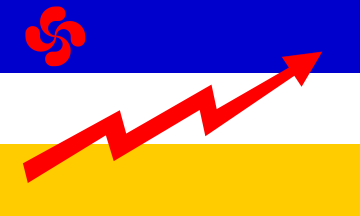
MNSU Flag 1988
|
United Nacional Socialist Movement of Chile
Movimiento Nacional Socialista Unificado de Chile (MNSU)
United Nacional Socialist Movement of Chile was founded - or "refounded" - in 1988. Its flag is derived from that of the original National Socialist Movement of Chile, whose successor they claim to be, with a differently stylized thunderbolt and addition of a red lauburu symbol on blue field in the canton. According to them, the lauburu is a "Spanish solar symbol". In reality, it is a specifically Basque symbol, but was obviously chosen due to its resemblance with the swastika, which is why it was also attributed to the National Socialist Movement of the Basque Country, a non-existent Spanish neo-Nazi group. |
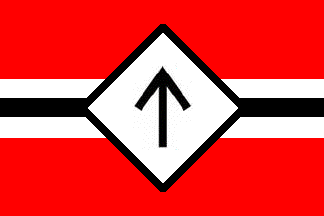
MNSVN Flag
|
National Socialist Movement - National Vanguard Flag (Peru)
Movimiento Nacional Socialista Vanguardia Nacional
One of the newest neo-Nazi groups in Peru is the Movimiento Nacional Socialista Vanguardia Nacional (MNSVN) which was founded in 2010, with branches in Lima, La Libertad and
Lambayeque. The National Vanguard uses a flag featuring a black arrow pointing upwards, said to be the "tyr" rune (tiwaz). The rune, shaped as a raised spear symbolizes power, resistance, determination and fighting spirit, according to the group.
The flag, which is presented in the traditional National Socialists colors with red field, and white and black striped detailing, is reminiscent of one of the variants of the Hitlerjugend (Hitler Youth) House Flag, with the tyr rune replacing the swastika. |

MNR Flag
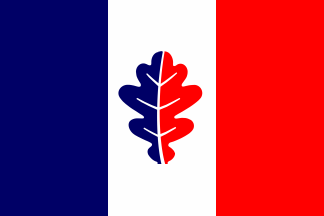
MNR Flag (unofficial variant)
|
Republican National Movement (France)
Mouvement national républicain
The Republican National Movement (MNR) was founded by Bruno Mégret in 1999 as a splinter of the extreme-right party National Front (FN or front national). Although political observers have considered the MNR to be a far-right party, the MNR presents itself as classical liberal and nationalist. It opposes immigration, Islamisation, and the European Union, but, unlike the National Front, supports free markets and neoliberalism.
The group uses the emblem an oak leaf, usually within a French tricolor flag. According to the party's website, "the oak leaf within the tricolor flag is the symbol of the struggle for our identity, of the attachment to our roots and of the continuity of our country. The oak symbolizes strength, nobleness and justice. In ancient Rome, the oak represented the civic virtues. It is shown in the arms of the [French] monarchy as well as in the arms of the Republic."
The flag of the MNR is vertically divided blue-red with, in the middle a white oak leaf with blue veins. The supporters of the MNR sometimes use another flag, probably unofficial, made of the French national flag charged in the middle of the white stripe with a tricolor oak leaf not reaching the horizontal edges of the flag. |

MNSDP Odal Rune Flag

Cross of Burgundy flag
(Spanish historical)
|
National Socialist Movement Awake Peru (Peru)
Movimiento Nacional Socialista Despierta Perú (MNSDP)
The Movimiento Nacional Socialista Despierta Perú (MNSDP) is a radical neo-Nazi group in Peru whose activities center around Cieneguilla according to the Peruvian police. Their motto of "Peru Awake" is obviously paraphrasing "Deutschland erwache!" (Germany awake!). The MNSDP formed what they called a super "creole" neo-Nazi group to celebrate Hitler's 119th birthday called the Peruvian National Socialist Union (UNSP - Unión Nacional Socialista Peruana) which briefly existed in 2008-2009.
The National Socialist Movement Despierta, in the tradition of the original National Socialists German Workers Party, maintains a militant and lightly armed "Brown Brigade," complete with flags, brown uniform shirts, black ties, and red and white MNSDP arm bands with the "Odal Rune" logos prominently displayed on them. The Odal Rune is also widely used by right-wing nationalist youth groups like the "Wiking Jugend" in Germany and "Afrikaner Student Federation" in South Africa.
The historical Spanish Cross of Burgundy has also been used by the MNSDP during their rallies. (The Cross of Burgundy was used as a military ensign in New Spain by Cortes and the Spanish Conquistadores in their conquest of the Mexico and later California.) |
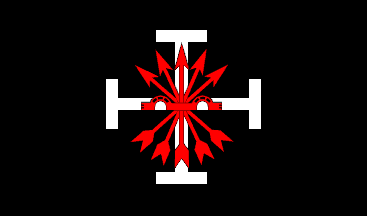
MNSPR Flag (2000-c2005)
|
National Syndicalist Movement of Puerto Rico (Puerto Rico)
Movimiento Nacional Sindicalista de Puerto Rico
This movement was founded in 2000, as the re-foundation of Falange Boricua. It never achieved any significant influence and seems not to have outlived the year 2005, since its website (existed 2004-2009) was not updated since then.
The MNSPR flag was a combination of those of the Falange Boricua and the Nationalist Party of Puerto Rico: red yoke and arrows, outlined black and superimposed on white cross potent, all on black field.
|
- My thanks to Rick Prohaska, David Ott, Tomislav Todorovic, and Chrystian Kretowicz for their help on this page -
Much of this information is borrowed, sometimes edited, modified, and shorten from longer articles in Wikipedia encyclopedia.
| Flags of Extremism Part 1 (a-m) | Flags of Extremism Part 2 (n) | Flags of Extremism Part 3 (o-z) |
|